Note: This page is a constant work-in-progress, with new information and corrections being made all the time. To search on the “1860-1869 Timeline” for any particular year, person, event, business, shop etc, simply press CTRL+F and type in the thing you are looking for in the small box that will appear on the screen.
1860 – Jan

The new Gold Warden’s Office is completed in front of the ‘Police Reserve’ on Ford Street. Designed by F. Reagan of Melbourne, to a standard design of the Public Works Department, it is built at the same time as the adjacent Chinese Protector’s Office at a cost of £365. Additional work is then carried out on the buildings by local architect and builder Donald Fiddes at a further cost of £160. The Gold Warden’s Office and the Chinese Protector’s Office will eventually be taken over by the Department of Forestry with extensive renovations carried out in the mid-1960s including the erection of a connecting link between the two buildings. The two buildings continue to operate as the Beechworth Forestry Office until the mid-1980s.
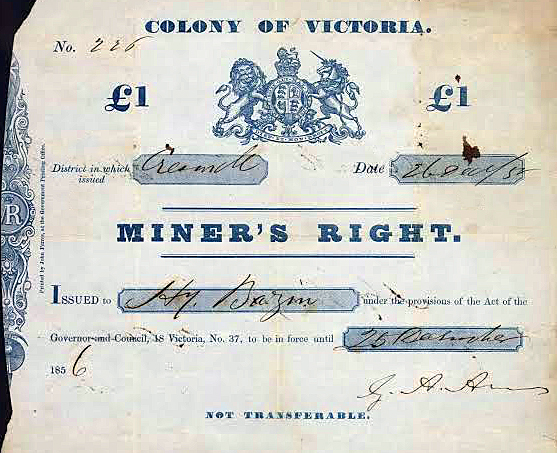
| The Gold Warden is responsible for the collection of miner’s rights, business licences and for enforcing the rules of the goldfields. |
1860

Beechworth becomes a contender for a proposed Australian capital city due, in most part, to its wealth from gold.
1860

The solid granite ‘Chinese Protector’s Office’ opens on Ford Street.
1860
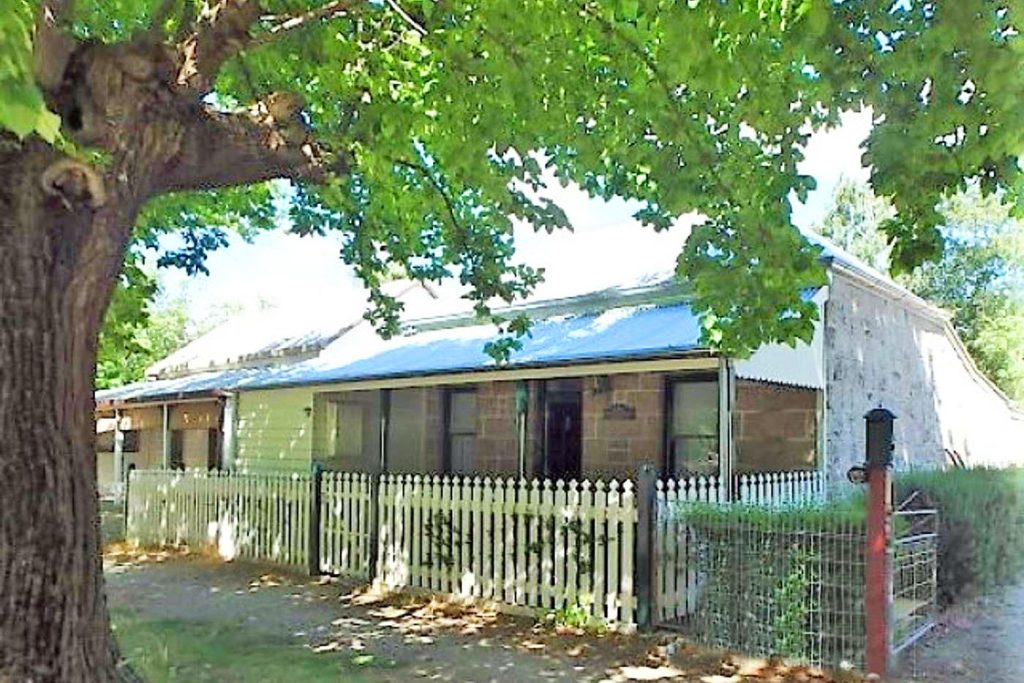
Scottish brothers Donald and William Fiddes construct a solid home at 30 Finch Street using granite from their Fiddes Quarry near the Woolshed. William Fiddes will live in the house until his death in 1906. It still stands today.
1860 – Jan 25

36 miles (58 km) from Beechworth, a wooden Post Office opens at Morses Creek (named after F.H. Morse, a former worker on George Edward Mackay’s ‘Warrouley’ run) and the settlement’s first Postmaster is Arthur Smith – a pharmacist – who has a business at the junction of Morses Creek and the Ovens River. Arthur Smith will also become the settlement’s first Registrar of Births and Deaths. Before this, the nearest Post Office for the growing mining community of Morses Creek is in the Buckland Valley, 25 miles away. The settlement’s name of Morses Creek will be officially changed to Bright in 1866, in honour of British orator and politician John Bright.
1860
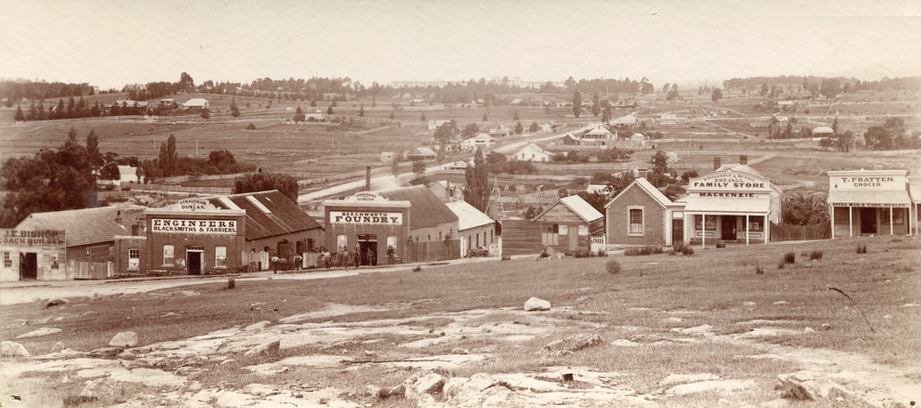
The area of New Town (or Newtown) – on the rocky sloping hillside just over the bridge from the main township of Beechworth – continues to develop. The image above shows a row of five business buildings in the mid-1860s – left to right – Joseph Eldred Bishop – Coach Builder; Straughair Duncan – Engineers, Blacksmiths & Farriers; Straughair Duncan – Beechworth Foundry; Mackenzie Family Store – Wholesale & Retail (established in 1855); and Thomas Pratten – Grocer. The Beechworth Mental Asylum can be seen on the hill in the background.
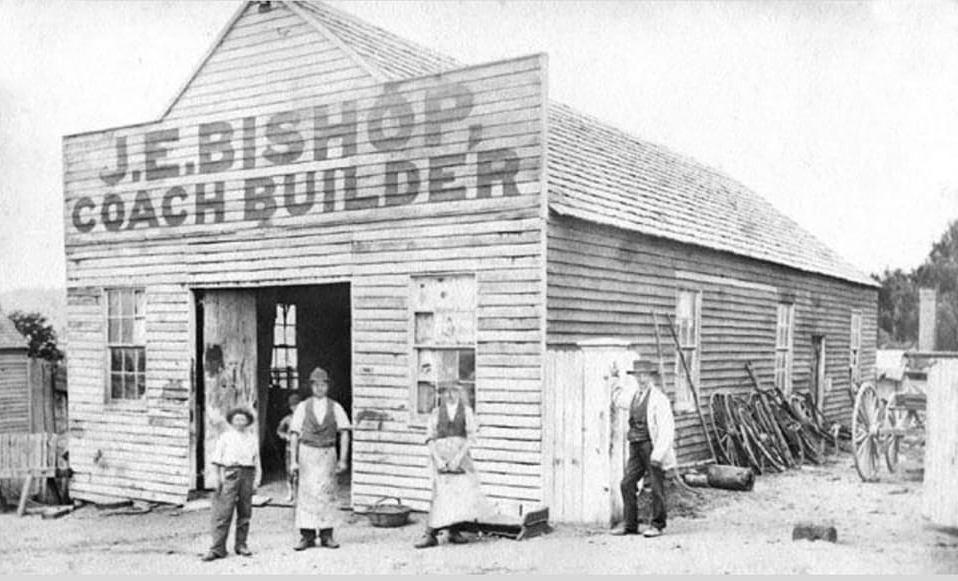
1860
The 36-kilometre (22 miles) ascent from Wangaratta to Beechworth takes 4 hours, longer in times of floods and wet tracks. (Now the same trip can be completed in a car on a well-sealed road in less than 25 minutes.)
1860
There are now 2,310 European miners and 2,139 Chinese miners working in the area. The Upper Three-Mile Creek (worked since 1852) is now chiefly taken up by Chinese miners, who are mainly using the sluicing method to find gold.
1860
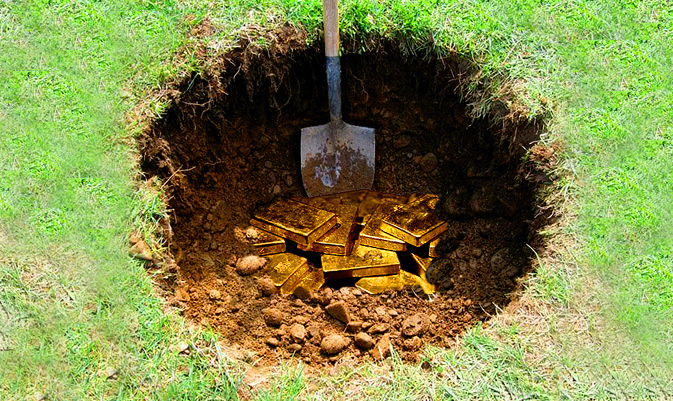
American-born miner James Ring gives evidence in court that he had buried gold valued at more than £1,500 (around $175,000 today) near a well on land that he owns with his brother, Patrick, at Three Mile Creek and that it has been stolen! James states that he returned from a hospital stay to find the treasure missing and accuses his brother Patrick of taking it. However, the case is dismissed when the court hears that James had told his brother “to make use of the gold should he need of it”. The gold is never recovered!
| Seven years later, on December 13th 1867, James Ring will suffer severe burns in a fire in the house – ‘Beaumaris’ – that he shares with his brother Partick on the Three Mile Creek. After suffering for over two weeks, he will succumb to his injuries at the ‘Ovens Goldfields Hospital’ on December 28th. |
1860
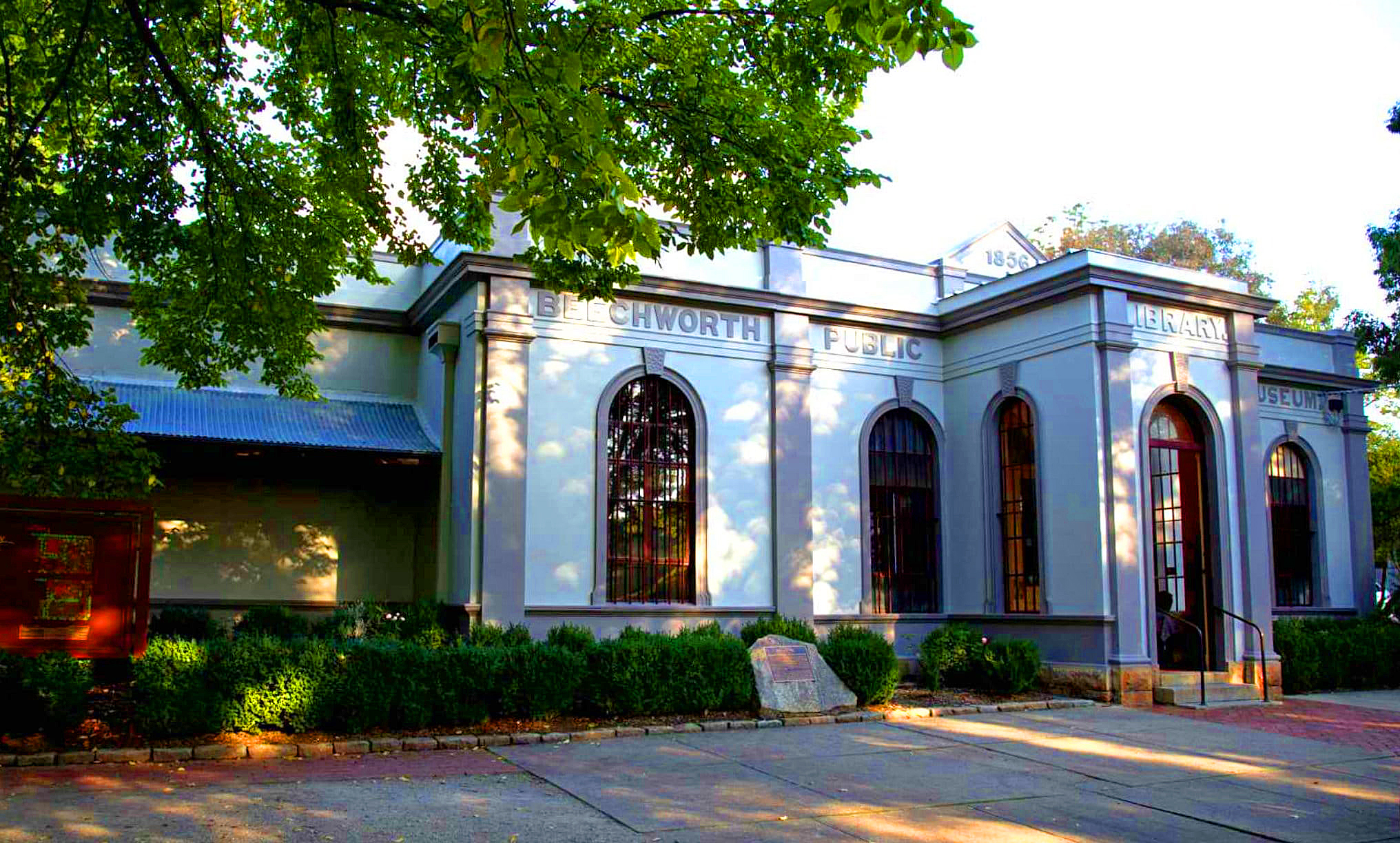
The Beechworth Municipal Council, having agreed to assist in financially maintaining the Young Men’s Mutual Improvement Development Group‘s private Athenæum on Loch Street – which comprises “a commodious reading room and extensive library” – will make the library open to the public, and it now becomes the Beechworth Athenæum and Public Library.
| In 1863, in order to pay tribute to the “much lamented” explorer Robert O’Hara Burke (formerly Superintendent of Beechworth Police), the ‘Beechworth Municipal Council‘ decide to add a Museum of Science to the building, and the ‘Burke Memorial Museum’ is established. The ‘Beechworth Public Library and Burke Memorial Museum‘ will be under the management of a committee of subscribers, acting on behalf of the ‘Beechworth Municipal Council‘. |
1860 – May 16

A gentleman calling himself ‘Doctor Radley’ – who has been practicing medicine in Chiltern – is arrested and sent to the Beechworth Stockade after one of his ‘patients’ dies following treatment. Charged with manslaughter, there is considerable doubt as to whether the man is actually a qualified doctor. Popular opinion is that he is an English aristocrat named Jowitt who fled to Australia following a scandal in London.
| While awaiting trial in Beechworth, the man – Radley or Jowitt – will help other inmates in the Stockade prepare for their own trials. They appear to be happy to take his advice, whether he is actually a doctor … or even a lawyer! |
1860

An interesting brick and granite home is constructed at 1 Loch Street. Featuring granite foundations, a large cellar and Baltic pine floors.

1860

There are now over 60 drinking establishments on the local goldmining fields at Beechworth, with the town and surrounding goldmining districts population sitting between 20,000 and 40,000 people (depending on which records are relied upon!).
1860

Many single Irish women arriving by ship in Melbourne wait around the Melbourne markets seeking employment, with many often ‘going astray’, making money as prostitutes in Melbourne’s infamous ‘Little Lon’ area at night. James Doyle of the St. Patrick’s Society writes to the Beechworth Catholic community, requesting it assist these new arrivals with employment. Doyle’s plea works, with George Joseph Cooper, owner of the Criterion Hotel on Camp Street giving work to a number of these young woman. However, their treatment in Beechworth is often questionable, with the Criterion Hotel featured in several cases brought by former female employees. Margaret Simmons, who arrives in Beechworth on a six-month contract, soon charges Joseph Cooper for outstanding wages of £15 after Mrs. Cooper fires Simmons for disobedience. The court rules in Simmons’ favour, with costs against the Coopers of £2, in default 14 days. Mrs. Cooper engages Annie Savage as a cook’s assistant, brings her up from Melbourne and expects her to dance and drink with drunken diggers. Annie refuses and is fired. Annie Savage sues the Coopers for eight weeks’ wages, £3. The court awards Annie outstanding wages with costs. Catherine Kelly a laundress recruited in Melbourne, sues George Cooper for £4 in unpaid wages following her dismissal when Cooper’s barman strikes her for refusing to dance with Cooper. The court awards outstanding wages and costs. This pattern of exploitation towards some female employees is not isolated to George Cooper. Recruiting women from Melbourne touches on a deeper social issue and the St. Patrick’s Society establishes a Beechworth chapter in 1863.
1860

Brothers Richard and William Warren dissolve their partnership in The Ovens and Murray Advertiser, with Richard Warren becoming the sole owner.
1860

Bushranger Daniel Morgan passes through the district after breaching his ticket-of-leave conditions. Born as William Moran in Sydney in 1830, this ‘native-born son’ grows up learning how to survive in the bush and gains the nickname ‘Bill the Native’.
1860 – Jul 3

The first cell blocks of the new Beechworth Gaol are officially opened, even though the building project is still incomplete. Chinese prisoners held in the wooden Beechworth Stockade are the first to be moved into the new cell block because of the reported “appalling state of the Chinese Hut within the Stockade”. A wooden picket fence is built to surround the new building, extending along the Williams Street frontage onto High Street, with a formal gateway aligned with the entrance to the Gaol providing entry to the site. The Governor of Beechworth Gaol – John Buckley Castieau – is assisted by a Matron, seven male ‘Turnkey’s’ and one female Warder.

| The Kitchen (Store), division walls, airing yards, a washing shed and a Watch House for female Warders will all be completed at the Beechworth Gaol by 1861. |
1860 – Jul 4

Crawford & Connolly coaches advertise the following prices for their coach trips – travel from Albury-Melbourne is £4/5/- and £5/5/- on a mail coach. The trip takes two days. By 1864 the Beechworth-Albury-Beechworth mail run is the backbone of the Beechworth-based company. The distance covered per annum under the Yackandandah-Albury mail contract is 16,224 miles!

1860 – Jul

The Star Theatre at the Star Hotel on Ford Street is the central place for entertainment in Beechworth, attracting all manner of acts. One of the most unusual is a performance by ‘Professor’ Bushell and his experiments in ‘Electro Biology’! (below). The ‘Professor’ presents a number of “instructive electrical experiments” and then completes the evening by “hypnotising volunteers from the audience”, instructing them to “do the most uncharacteristic things”!
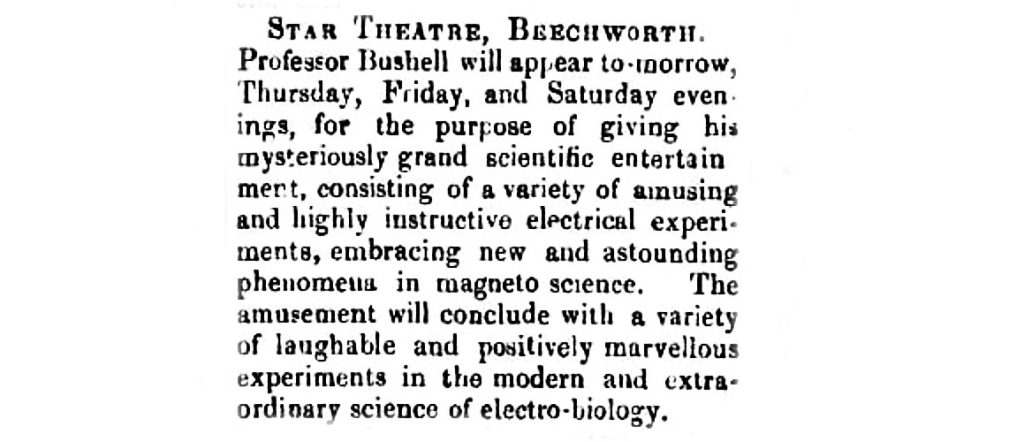
1860

American miner, storekeeper and entrepreneur 34-year-old Joshua Cushman Bigelow – who had been one of the first to discover gold at Snake Gully (Stanley) in December 1852 – has now accumulated enough wealth to build an impressive new home in Stanely, where he will live for the rest of his life. Joshua had married Margaret ‘Maggie’ Bigelow (née Thompson) in Ballarat in November 1856 and together they oversee construction of Bloomfield House on Little Scotland Road in Stanley. The impressive house is built of hand-made bricks with French doors opening out onto a verandah. After his family grows to 11 children, Bigelow will extend the house in 1873, adding two new bedrooms, a sitting room and a formal dining room. Bloomfield House still stands today (below).

1860 – Aug 20

With much excitement, an estimated crowd of 15,000 spectators gather at Melbourne’s Royal Park to watch Beechworth’s former Superintendent of Police Robert O’Hara Burke begin his ‘Great Victorian Exploring Expedition’ funded by the Victorian Government and the Royal Society of Victoria. Wearing a top hat astride his charger ‘Billy’, Burke departs at 4.00pm, leading his men out of Royal Park on to Flemington Road and thence to Mount Alexander Road heading for Essendon and distant parts north. The expedition sets out with 23 horses, 6 wagons and 26 camels, with the 19 men of the expedition made up of six Irishmen, five Englishmen, three Germans, an American, and four camel drivers from South Asia. No indigenous men are included in the expedition party – which will turn out to be a serious error. Burke, an Irishman with no exploration experience or skills in surveying or navigation, does “not trust aborigines”.
| The Burke and Wills exploration is one of the best funded expeditions ever mounted in Australia. Not being short of funds and going into the unknown, the expedition takes a vast quantity of supplies and equipment, including enough food and firewood to last two years. But they also take a lot of ‘equipment’ that defy explanation, including a heavy cedar-topped oak dining table with matching chairs, a piano, a Chinese gong, twelve dandruff brushes, four enema kits, fifty gallons of rum (to revive tired camels), a generous wardrobe of fine clothes, and a large desk for Burke to sit at to write journals (that he never writes!). Altogether this ‘special equipment’ weighs over 20 tonnes and clearly slows them down. Most of it is disposed of along the way. While a few members of the expedition will reach the shores of the Gulf of Carpentaria on February 11th 1861, Burke and Wills and others will perish on the return journey at the end of June 1861. |

1860

Florence Rose Morphy is born in Beechworth, the youngest daughter of John Stephen ‘James’ Morphy, Beechworth’s police magistrate and Gold Commissioner. (He will die a year after her birth.) By 1883 Florence is employed as the music teacher to the children of Sir William Clarke and Janet Lady Clarke at ‘Rupertswood’ in Sunbury (50km from Melbourne), where she meets Ivo Bligh, the tall, handsome and articulate captain of the touring English cricket team of 1882/83. They fall in love and Ivo and Florence marry on the 9th of February 1884 at St. Mary’s Church in Sunbury, with a glamorous reception held at ‘Rupertswood’. Ivo Bligh takes his new bride back to England and in 1900, he succeeds to the title of the 8th Earl of Darnley, and Florence becomes ‘Countess of Darnley’.
| At ‘Rupertswood’ Florence is instrumental in the creation of ‘The Ashes’. During WWI Florence opens the Darnley manner home of ‘Cobham Hall’ for use as a hospital. After the war, her generous work is recognised and she is made a ‘Dame of the British Empire’ (the female equivalent of a knighthood). With much local excitement, the ‘Countess of Darnley’ will return to Beechworth for a visit in December 1903 where she officially opens the ‘Beechworth Bowls Club’ at ‘Queen Victoria Park’. |
1860 – Sep 9
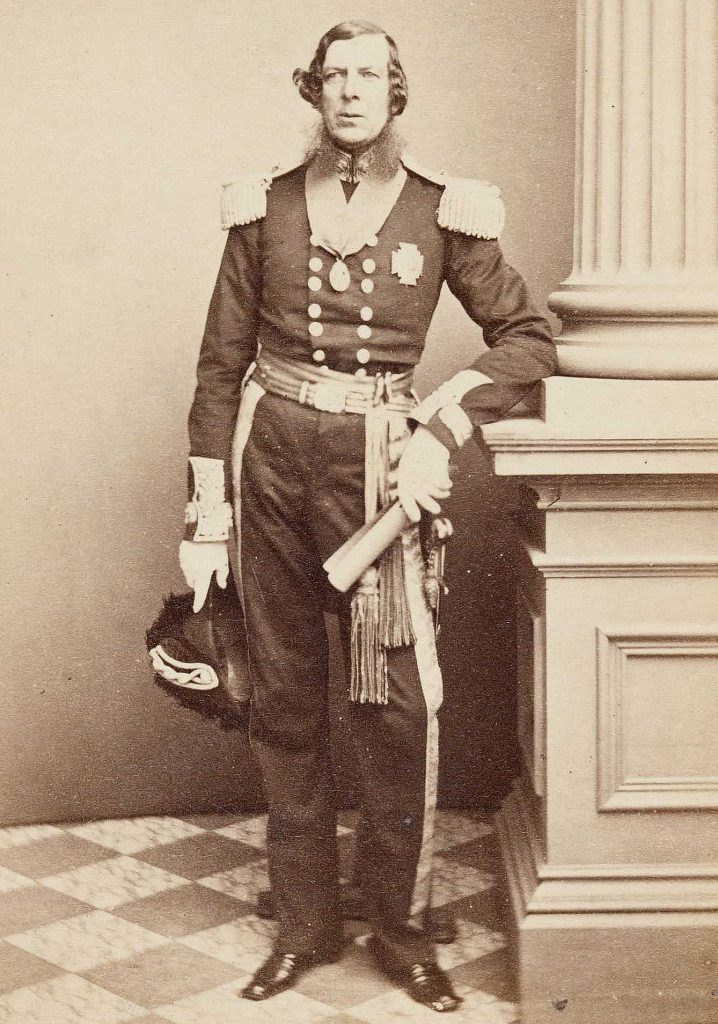
Following a cry on a Saturday morning that “gold has been discovered!” – a deep lead has been found underground by a prospecting party provisioned by John Frederick Foord from Wahgunyah – a large number of miners rush from Beechworth to a new site 40 km away. Originally known as the ‘Wahgunyah Rush’ – as John Foord’s Wahgunyah is the closest actual settlement to the discovery – the jubilant miners allow the lone butcher at Wahgunyah the honour of washing their first prospect! The gold rush settlement will be named Barkly after the current Governor of Victoria, Sir Henry Barkly. Word of the richness of the strike continues to spread, and more and more people arrive on the scene … and a new settlement is born. Barkly is now part of Rutherglen (see next entry).
| As the location is just 10 km from the Murray River, the river trade will also increase as boats from Wahgunyah carry goods and passengers to Echuca (for connecting rail service to Melbourne when the line is opened in 1864) and then beyond Echuca to South Australia. |
1860 – Sep 15
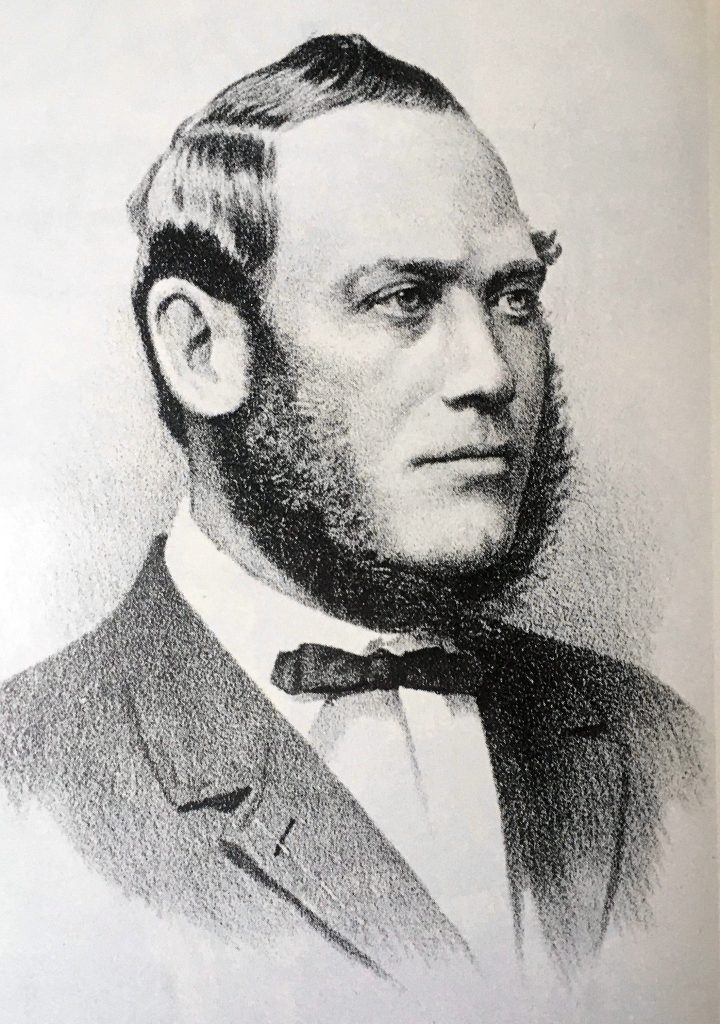
Shortly after the ‘Wahgunyah Rush’ and the creation of the settlement of the town of Barkly, another gold-bearing site is discovered 500 metres to the east. In October, John Alston Wallace quickly establishes another of his Star Hotels at the new town site which does yet have a proper name. It is claimed that Wallace is told “Shout the whole bar, and you can call this town whatever you like!” So, he buys beers for everyone and names the new town ‘Rutherglen’ in honour of his 1824 Scottish birthplace of Rutherglen in Lanarkshire. Within a month there are forty stores and innumerable grog shops in Rutherglen. By late October the first newspaper is issued and the first Postmaster is appointed, and by November three schools are in operation and a Police Camp has been established. By December 1860 there are 12,095 people in the Indigo Division (comprising Rutherglen, Indigo and Chiltern) of which 1,925 are Chinese. The ‘Wahgunyah Rush’ – and the creation of Barkly and Rutherglen – is considered “the last great goldrush in Victoria”.
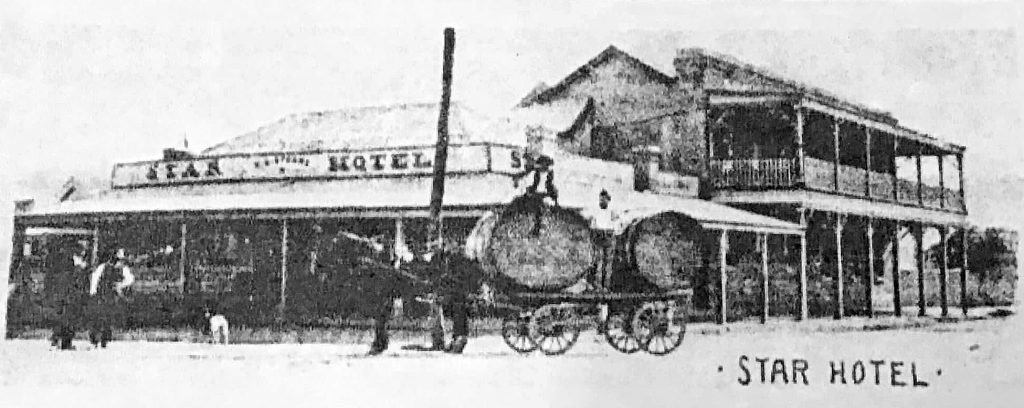
| From 1855 John Alston Wallace and his brother Peter establish a chain of ‘Star Hotels’ in north-east Victoria – at Stanley, Beechworth, Silver Creek, Lower Nine Mile, Yackandandah, Chiltern and Rutherglen. John Alston ‘Seven Star’ Wallace often rides through the night to supervise his various ventures, from Beechworth, Yackandandah and Rutherglen to as far away as Bright! In 1859 John extends his interests to the new Indigo goldfield near Chiltern and in 1860 he becomes a director of the ‘Ovens Gold Fields Water Company’, promoting a bold (though abortive) project of water conservation for sluicing. |
1860

A weatherboard, brick and granite residence is built at 11 Ford Street. One of the home’s most notable features is its spectacular views toward the gorge from the back of the property (below). Over 160 years later, in the early 2020s, the house will receive an extensive makeover (below) and rear extensions and be offered for sale at just under $1 million.
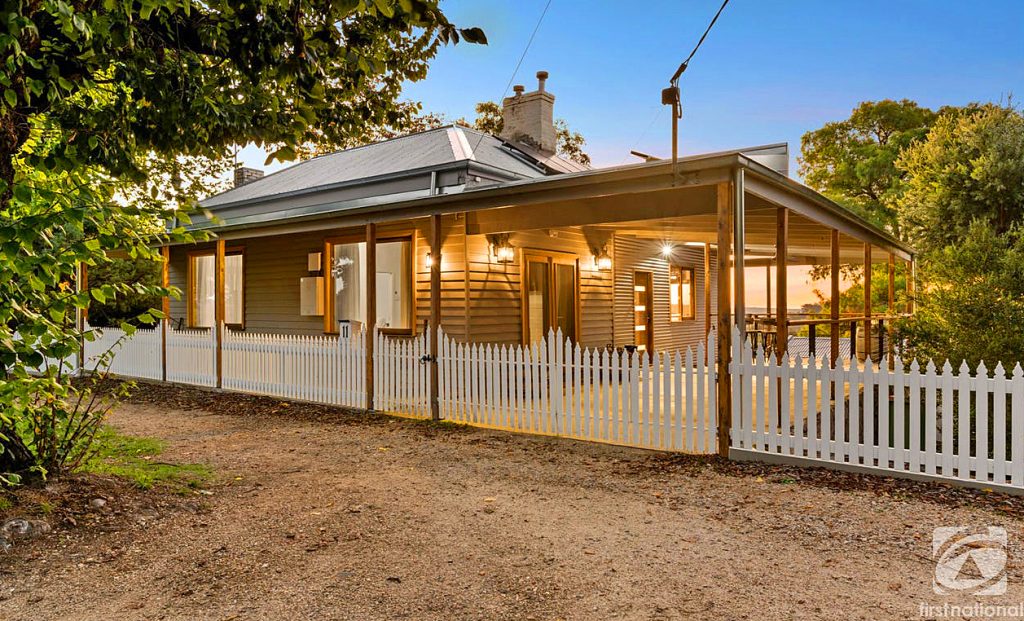

1860
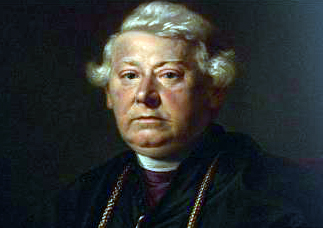
James Alipius Goold – Melbourne’s founding Roman Catholic Bishop – visits the Ovens District, focusing on religious activities to the ‘Catholic Mission of Beechworth’.
1860 – Dec
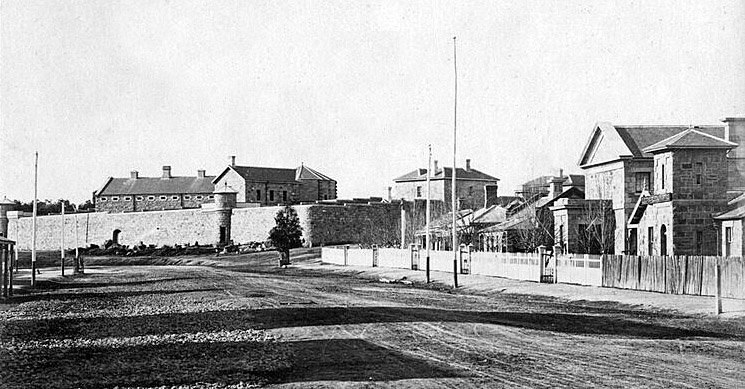
The northern end of Ford Street has grown rapidly and is now home to the Gold Wardens Office, Chinese Protectors Office, Gold Vault, Courthouse and the first cell blocks of the new Beechworth Goal. The high surrounding wall will be completed by 1864.
1861

The 1861 Census states that there are 372 Chinese at the ‘Pennyweight Flat’ (below). The large drop in Chinese numbers suggests tensions and dissatisfaction – caused by drought and lack of gold – has seen many Chinese depart the area, as the figures for September 1859 showed 1,347 Chinese in the camp.

1861 – Jan

The Beechworth Courthouse – opened in 1858 – now has five different courts being held within the building – General Sessions, Petty Sessions (Magistrates’ Court), County Court, Supreme Court, and the Gold Fields Local Court (Court of Mines).
| Three other courts will be added to sessions held at the ‘Beechworth Courthouse’ over the coming years – Court of Insolvency (from 1871 to 1928), Licensing Court (from 1885 to 1917) and a Children’s Court (from 1907 to 1989). |
1861 – Jan 24

The Victoria Government Gazette publishes the announcement that Stanley – 10km from Beechworth – has been officially gazetted as a ‘town’. Three ‘suburbs’ will develop within Stanley – ‘Little Scotland’, ‘Little Ireland’ and a Chinese Village, and by 1866 Stanley supports around 4,000 people. At the height of the goldrush in Stanley, up to 6 ounces of gold are extracted every day.
| Stanley will be stripped of its township status in 1994 following the amalgamation of local shires into the new ‘Shire of Indigo’ as an official local government area. |
1861
The population of nearby Wangaratta stands at 612 permanent citizens and has not yet acquired the status of a municipality. (It will become a ‘borough’ on June 19, 1863). Some in the government view Wangaratta as having little importance and regard it as a swampy, flood prone area of land. By contrast, Beechworth has become the central area of Government administration, the judicial headquarters of the Police District, and the commercial hub of the area … and the first section of the Beechworth Gaol has just opened.
1861

W. T. Hing, a successful and prominent member of Beechworth’s Chinese community, builds an attractive little home at 2 Finch Street. The cottage features granite quoining, tuck-pointed brickwork, bay and arched windows, pressed metal ceilings, open fireplaces, hallway arches and Victorian cornicing and skirting-boards. It still stands today.
1861

An impressive new two-storey residence – Bellevue – is completed at 9 William Street in Beechworth for Henry Thomas Littlewood, co-owner the popular Manchester House store. In April 1865 Bellevue is purchased by Mr M. McCormack and by 1866 it is owned by Mr. J Tisley who operates it as a boarding house. The two-level brick structure features granite dressings, a shingle roof and balcony and balustrade to the upper floor, with distinctive French doors opening onto the balcony and verandah. At the rear is a single storey section containing two short wings divided by a skillion-roofed central living area. Set on a large block of land featuring a number of brick and timber outbuildings including stables, Bellevue is one of the largest surviving 19th century residences in Beechworth and is now included on the Victorian Heritage Register.

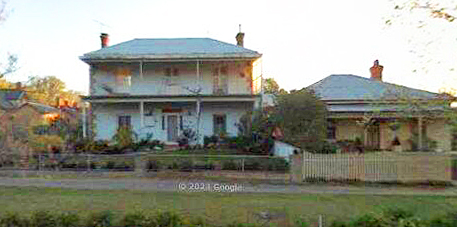
1861 – Feb
The Public Recreation Reserve is cleared and enlarged, and by June 1862 the Jockey and Cricket Club control the Reserve.
1861 – Apr

34-year-old Philip Le Couteur announces that he has produced the first wine ever made in the district. Le Couteur Avenue opposite Beechworth Primary School is named in his honour. Others had already planted vines at Beechworth – including John Richmond and Hungarian-born Julius Albert von Rochlitz – but had not yet successfully produced wine. A German, Mr. Zimmerman, announces that he has purchased land with the intention of planting vines and producing wine.
1861 – Apr 26

At a meeting at Frederick ‘Fritz’ Dreyer’s Corner Hotel, the first Beechworth Football Club is formed, and will play its first game – a ‘practice match’ involving 40 players – on April 27th on the Beechworth Cricket Ground at Baarmutha Park. However, the Beechworth Football Club will not compete in its first ‘formal game’ until 1872.
| By 1885 there will be two football teams in Beechworth – the ‘Beechworth Football Club’ and the ‘Wanderers Football Club’, which is based at Hurdle Flat near Stanley. The two teams play informally, both against one another and against teams from other nearby mining settlements, such as Yackandandah, Chiltern and Rutherglen. In 1886 the ‘Beechworth Mechanics Football Club’ is founded, followed by the ‘Two Mile Rovers Football Club’. The ‘Mechanics’ and the ‘Rovers’ will merge with the Beechworth Football Club in 1892. |
1861 – Jun 7
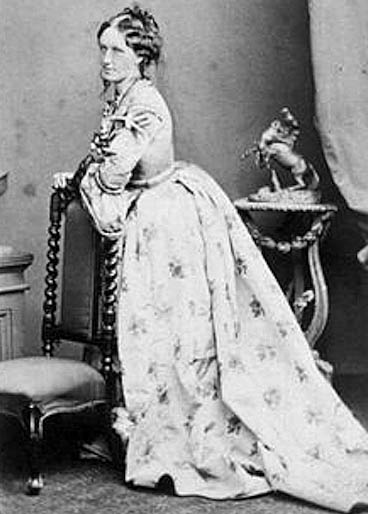
31-year-old Canadian-born John Henry Gray is killed in Chiltern when he is accidentally knocked over by his panicked horse and then run over by his dray. He leaves a widow, Jennie, and three children. Gray had arrived in Beechworth as a 21-year-old with the first goldrush and, by his mid-20s, he had established the popular and successful Beechworth Auctioneer and Dealer business J.H. Gray & Co. With Francis Hodgson Nixon he had commissioned the town’s best-known newspaper the Ovens and Murray Advertiser.
| William Telford – a principal shareholder of ‘J.H. Gray & Co’ – will continue to run the successful business after the death of John Henry Gray and will marry his widow Jeannie in 1864. Telford will later be be joined at the firm by Jeannie’s father William Orr. When the ‘J.H. Gray & Co.’ company opens a Wangaratta branch, Scottish-born Willim Orr moves to Wangaratta to manage the business and becomes active in local affairs. Elected to the Wangaratta Borough Council in 1875, he will serve as Mayor of Wangaratta in 1878-79. |
1861
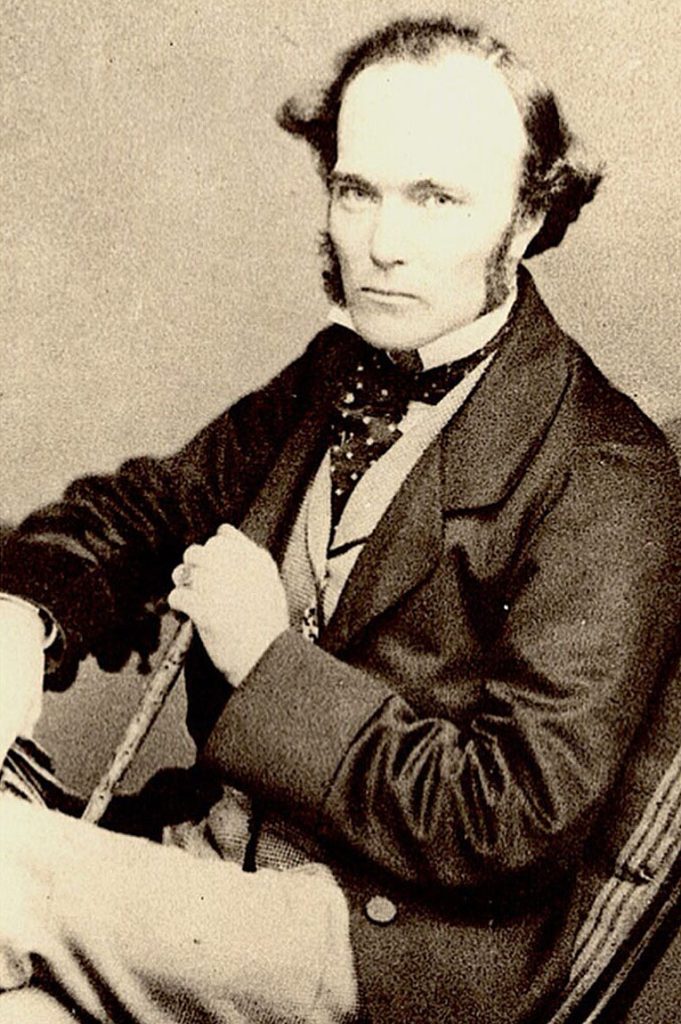
With prisoners moving into the first cells of the Beechworth Gaol in July 1860, work continues on new sections, with construction of the division walls, kitchen & store, washing shed, airing yards, and a Watch House for female Warders now being completed. Designed by the colony’s official Government Architect 38-year-old William Wardell (above) – who also designs St Patrick’s Cathedral and Victoria’s Government House – it will be completed by 1864 and is initially intended to house 25 male and 5 female prisoners, although these numbers will soon be revised upwards.

| Amongst Beechworth Gaol’s more ‘infamous’ inmates are Ned Kelly and his mother Ellen Kelly. The Gaol is decommissioned in December 2004, but still stands and is now open for guided tours. Journalist Derryn Hinch spends 12 days incarcerated in the old Beechworth Gaol in 1985 for contempt of court. |
1861 – Jul 10

48 km from Beechworth, 17-year-old Sarah Foord, eldest daughter of Wahgunyah pioneer John Frederick Foord, tugs on a silken sash at noon, which is the signal to drive the first pile of the new Wahgunyah Bridge over the Murray River, one of the first bridges ever built over the massive river. Built of local red gum, the bridge will resolve the great need of both people and stock to get across the river. (John Foord has been operating a punt across the river at the same spot since 1857 and established warehouses for the new river paddle-boat trade). A toll has to be paid to cross the new bridge and the fees gathered will quickly repay the various shareholder responsible for construction. Eventually jointly purchased by the governments of Victoria and New South Wales, it become a ‘free bridge’ when the tolls are removed in 1882.
| Once the bridge is opened at Wahgunyah, a second settlement of Corowa grows on the northern bank of the Murray River and soon surpasses Wahgunyah. |
1861 – Jul 22

A public meeting led by James Ingram initiates the creation of the Ovens Benevolent Asylum to provide accommodation, care and relief for ‘the aged, infirm, permanently disabled and destitute’. This includes gold miners who are permanently injured; women and children who are penniless, homeless, or whose parents were guests of the State.
1861
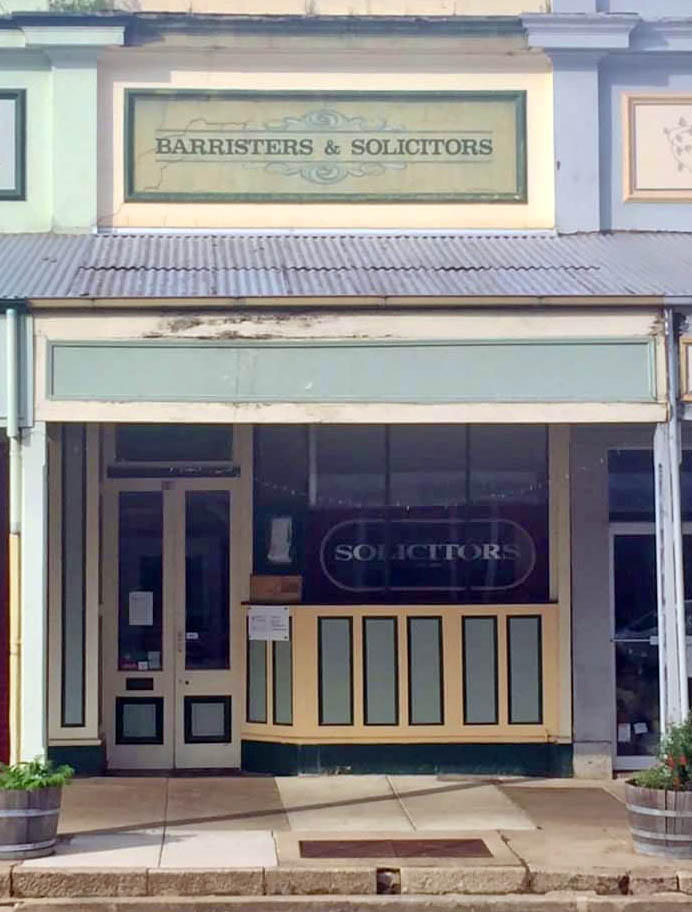
44-year-old Jamaican-born lawyer William Lawrence Zincke opens his own law firm – Zincke and Martin Solicitors – with his senior legal partner Frederick Martin at 22 Camp Street. It will operate continuously as a legal practice for the next 162 years until it finally closes in 2023.
| William Zincke plays the cello with the popular ‘Beechworth String Ensemble’. He marries Mary Laurence in Beechworth in 1869 and they have six children, three of whom die in infancy. Zincke will die in Brighton in Melbourne on the 18th of August 1896, aged 87. |
1861

Having purchased 55 acres of land in North Wangaratta, 38-year-old English-born Henry Silcock Parfitt now builds and opens The Vine Hotel, which also serves as North Wangaratta’s General Store and Post Office and, for a few years, used by the Wangaratta Shire Council for some of its meetings. After the single storey wooden structure is destroyed by fire in 1883, the now 60-year-old Henry Parfitt will rebuild the hotel with bricks (made on site) before selling it and entering politics (see box below). Still in business today, The Vine Hotel has become somewhat of an institution to many people in the surrounding area.

| The original builder, proprietor and licensee of the ‘Vine’, Henry Silcock Parfitt will serve as a member of Victorian Parliament between 1889 and 1892, representing Wangaratta and Rutherglen. He will pass away on June 7, 1892 aged 68. |
1861
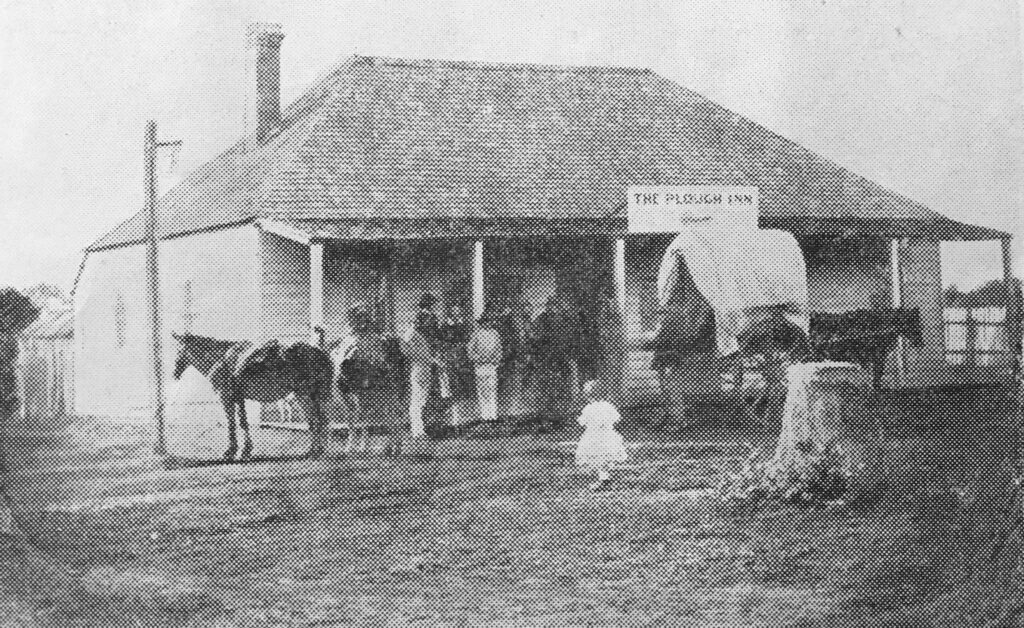
During the first land sales at Tarrawingee, 21 km from Beechworth, Hopton Nolan purchases a block of land and builds The Plough Inn, a new weatherboard hotel. It sits on the main road between Wangaratta, El Dorado and Beechworth. Now a brick building, The Plough Inn still operates from this site today.
| After marrying Jane De St. Legier in Beechworth in 1856, Nolan had become the proprietor of the ‘Sun Hotel’ in Stanley before deciding to build his own hotel in Tarrawingee. The Nolan family will remain the owners and operators of ‘The Plough Inn’ for the next 160 years! |
1861 – Aug 1

10 miles (16 km) from Beechworth, the Eldorado Post Office opens in the small gold-mining settlement of Eldorado beside Reedy Creek.

| Gold is initially identified at Eldorado in 1854 but not in payable quantities. That changes in 1857 with the sinking of the ‘Kneebone South’ (or ‘Kneebone No. 2’) shaft. A small township then begins to form on land known as the Eldorado Flat. Other mining companies will follow, including the ‘Wellington’, ‘McEvoy Company‘ ‘and ‘The Great Extended El Dorado Gold and Tin Mining Company’ in 1859. |
1861
Cabinet makers and furniture dealers Senglemann & Reidle open a successful business at 34 Ford Street.
| After 45 years in business, Henry Claus Senglemann and Joseph Reidle sell the property in 1906 and the building is turned into a Skating Rink, a popular amusement at the time. When motor cars come into fashion, it is converted to the ‘Golden Era Service Station’, which remains there to this day. |
1861 – Sep 2

With much fanfare, the first bridge over the Murray River at Albury – finally linking New South Wales and Victoria – is completed. The two-lane Union Bridge – between Albury and Belvoir (Wodonga) – is officially opened when Miss Chauncey, daughter of the Roads Superintendent, breaks a bottle of champagne in the middle of the timber bridge. (The new bridge replaces the river punt that has been crossing the river since 1843.) The bridge has been constructed by Americans Adam Casner Kidd and William ‘Billy’ Barnwell Brickell at a cost of almost £7,500. Kidd and Brickell naturally invite everyone back to their pub, the Exchange Hotel in Albury, to continue celebrations and drinks after the official ceremony! (Somebody jokes it’s too bad that Kidd and Brickell’s punt had sunk two weeks previously, forcing the authorities to open one lane of the two-lane bridge, unofficially, ahead of time!) The first vehicle to officially cross the new bridge is a ‘Crawford and Connolly’ coach from Beechworth.
| The first ‘Union Bridge’ will be replaced by a larger structure which opens on December 31st, 1898. This second bridge closes and is eventually demolished after the third and existing bridge is opened by the Premier of NSW, Mr Heffron, on April 7, 1961. |
1861 – Sep

The 1858-built Telegraph Hotel on Ford changes hands and is renamed the Albion Hotel (‘Albion’ is the 4th century Greek name for ‘England’) by the new licensee 40-year-old Robert Ransom who exploits the hotel’s close proximity to the Beechworth Court House, declaring that “witnesses needed at Court no longer have to wait in all weathers to be called – they can are welcome at the Albion where they will kept abreast of proceedings and advised when they are needed”.

| Standing next door to the 1876-built ‘Oriental Bank’ (now ‘Freeman on Ford’), the ‘Albion’ has its own small theatre, later appropriating the name ‘Star Theatre’ after the original ‘Star Theatre’ closes in late 1868. The ‘Albion’ will finally close on June 2nd 1920 and the building torn down. For a time the vacant land will be used as a venue for outdoor movie shows. ‘Parkinson’s Garage’ will later be built on the site. |
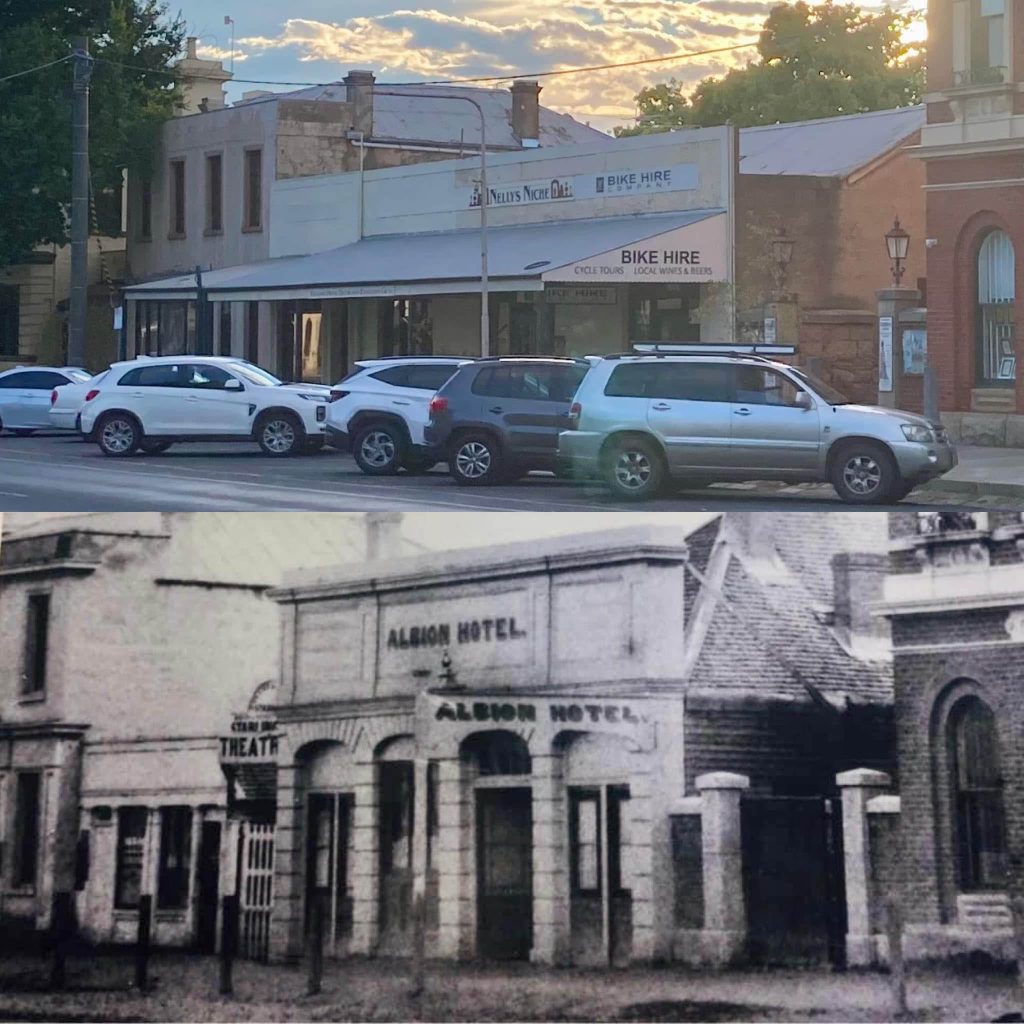
1861 – Oct 1
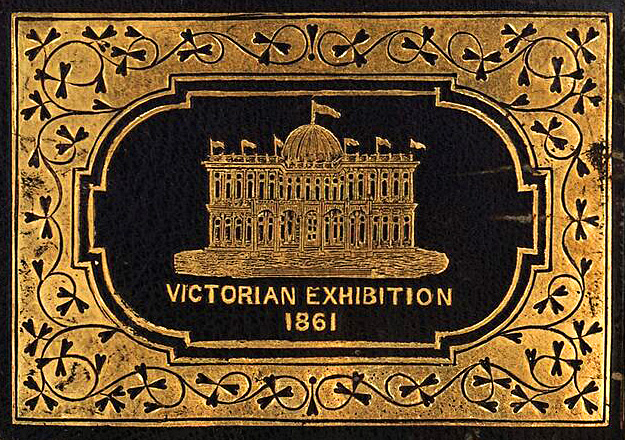
The Victorian Exhibition of 1861 begins in Melbourne and includes 9 wines exhibited by Beechworth’s John Richmond. The exhibition – as the name implies – features (almost) exclusively Victorian manufactured items and produce, and runs from the start of October until the end of November at Melbourne’s first Exhibition Building, built in 1854, on the corner of Latrobe and William Streets. All exhibitors have the advantage of the best items being selected for display at the London International Exhibition the following year.
1861 – Dec

A contract for the construction of a dam to provide water for Beechworth is awarded to James Parker for £7,281. Work begins in early 1862 and is completed by the end of that year. A key objective of the dam is to retain the waters of the Hurdle Flat Swamp for gold mining activities. Initial plans are for a dam height of 35 feet, providing a storage capacity of 46 acres, with an understanding that the bank of the dam could be raised by 12 feet when more funds become available.
| The Honourable George Briscoe Kerferd plays a significant role in securing the water supply for Beechworth. He is a great advocate for the construction of the dam and helps facilitate Beechworth’s water storage. The Council names the completed dam ‘Lake Kerferd’ in his honour. |
1861 – Dec 24

The ship Great Britain docks at Sandridge (Port Melbourne) after a two-month journey from Liverpool. On board are the All England 11, the first ever international cricket team to tour Australia.
| The tour is organised by two enterprising entrepreneurs – Felix Spiers and Christopher Pond – owners of the ‘Cafe de Paris‘ in Melbourne. It will be the first ever commercial sponsorship of cricket. |
1862 – Jan 1
The touring English Cricket Team – ‘The All England 11’ – play their first big match in Australia at the MCG in Melbourne (in front of an estimated crowd of 15,000). Then the team will prepare to head north … to Beechworth!
1862 – Jan 7
The biggest sporting event in Beechworth’s short history is set to begin with the imminent arrival of the touring English Cricket Team to play a game in the town. They depart Melbourne by coach at noon, arriving in Wangaratta the following morning in time for breakfast … and the excitement in Beechworth is palpable!
1862 – Jan 8

After the rigours of the coach trip from Melbourne, and their breakfast stop in Wangaratta, the touring All England 11 finally arrive in Beechworth, where they are greeted by a large and excited crowd. After a short break to refresh themselves, the team is given a tour of the diggings along Reid’s Creek where they watch sluice boxes being washed out and are presented with some small pieces of gold from the wash up. Back in Beechworth that evening, it is decided that the English Team members will all wear coloured ribbons on their linen hats during the big match so as to be more readily identified by spectators. The match will be played at the hastily cleared site of the Beechworth Racecourse, with Beechworth’s Gold Warden, William Henry Gaunt, appointed to umpire the match.
1862 – Jan 9

The Big Cricket Match – Day One. The English players emerge from their respective hotels. Half have spent the night at John Duncan Fisher’s Commercial Hotel, the other half accommodated at the Star Hotel across the road on Ford Street. They make their way to the Beechworth Racecourse (Baarmutha Park) where the flattest piece of ground has been selected as the site of the pitch and the game commences.
1862 – Jan 10

The Big Cricket Match – Day Two. The match between the touring English Cricket Team – The All England 11 – and an opposing team made up of twenty- three players drawn from all over North-East Victoria, finishes in what is described by many as a ‘total massacre”! England make 264 in their first innings The local team can only manage 20 runs in reply. In the second innings, the locals score just 53! As the planned three-day games finishes early, a ‘scratch match’ is arranged between England’s most flamboyant player George Griffith – dubbed ‘The Lion Hitter’ – and an ‘Ovens District Eleven’ which includes Robert Reid and his brother Curtis Alexander Reid. Griffith, with three men to field for him, bowls all the Ovens side out for only one run then takes the bat and hits the winning run with the fifth ball of his innings. He keeps batting for the entertainment of the crowd until he hits a catch and retires from the crease. The players and the large crowd all agree it’s been a very enjoyable and entertaining day – even those from Tarrawingee – who lose most of their wheat crop in a bushfire which breaks out at Tarrawingee while they’re in Beechworth for the match!
| Curtis Alexander Reid is a winemaker, who will produce wine at Tarrawingee under the ‘Reidsdale’ label until 1874. A celebrated local cricketer, he will go on to umpire the historic first Test Match in Melbourne in 1877 and, in 1878, becomes the first fully paid secretary of the ‘Melbourne Cricket Club’. |
1862 – Jan 11

The day after the ‘Big Cricket Match’, most of the population of Beechworth turn out for a performance of the ‘Californian Circus’ followed by the presentation of the ‘Man of the Match’ award to George Griffith, ‘The Lion Hitter’ from the All England 11 team and a Mr Ward from Myrtleford who is the top scorer for the Ovens side with a fighting 13 runs. (The evening’s entertainment will also be used to raise funds to be able to make up the shortfall of monies owed to the winning team!) It must have been a tough few days in Beechworth for the English team, who had left England in the middle of a bleak winter to play cricket in local summer temperatures that had ranged from 100 to 110 degrees Fahrenheit!
| ‘The All England 11’ will go on to play against local teams in Geelong, Bendigo, Ballarat, Castlemaine, Hobart, Bathurst and Sydney before returning to Melbourne for one final match on March 24, before triumphantly sailing home to England. Such is the success of the tour that another ‘All England 11’ team will return for second tour during the summer of 1863-1864. |
1862

John Connolly – former barman at John Duncan Fisher’s Commercial Hotel – takes over the George Hotel on the corner of Camp and Finch Streets and renames it the Shamrock Hotel. John Connolly quickly renovates the building to include the addition of a ‘Splendid Plunge and Shower Bath’ with a ‘Fountain Playing Daily’.
1862 – Feb

A severe summer storm hits the Beechworth area. A telegraph post near the Vine Tavern is split downwards from the top by a lightning strike, the effects of which are alarmingly felt in the Beechworth Telegraph Office. In an instant, a line of fire runs over the telegraph machines, burning up the paper tapes, fusing the wire coils and charring all the woodwork. The electric current is carried off to the wire which discharges down to the well where two men from the Beechworth Gaol are busy at work repairing the pump. One of the men “startled by the explosion, laid hold of the discharging wire and was at once thrown on his back, luckily more frightened than hurt”.
1862

Young Ned Kelly has started school in Beveridge’s new Roman Catholic Church. Ned’s schoolmate Frederick Hopkins memoirs state: “Ned was a tall active lad and excelled all others at school games.” In six months, Ned has learned to read and write to second class standard, before his father John ‘Red’ Kelly sells the Kelly house and farm in 1864 for £80, and moves the Kelly family 80km north to Avenel, renting forty acres on the banks of the Hughes Creek.
| John ‘Red’ Kelly, an Irish gamekeeper, is found guilty of stealing two pigs in 1841 and sentenced to seven years transportation to Australia, arriving in Van Diemen’s Land in 1842. After serving his sentence, he sails to Melbourne where he works as a carpenter and marries Ellen Quinn, daughter of a free settler from Ireland. They move north of Melbourne and have six children. After killing a calf that has strayed into his paddock, ‘Red’ is convicted of stealing and, on May 29, 1865, is fined £25 which he cannot pay. Sent to prison, a neighbour will kindly pay the fine and he is released. However, now a broken man and suffering from dropsy, ‘Red’ Kelly dies several months later, leaving 12-year old Ned responsible for the family. |
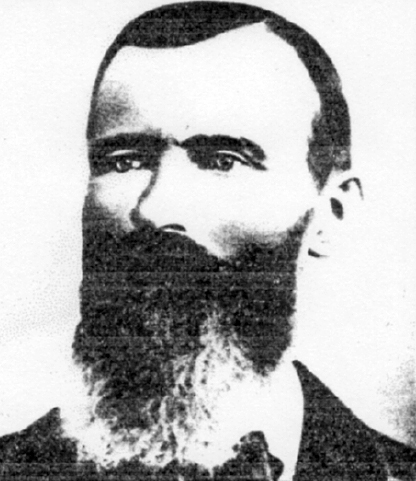
1862
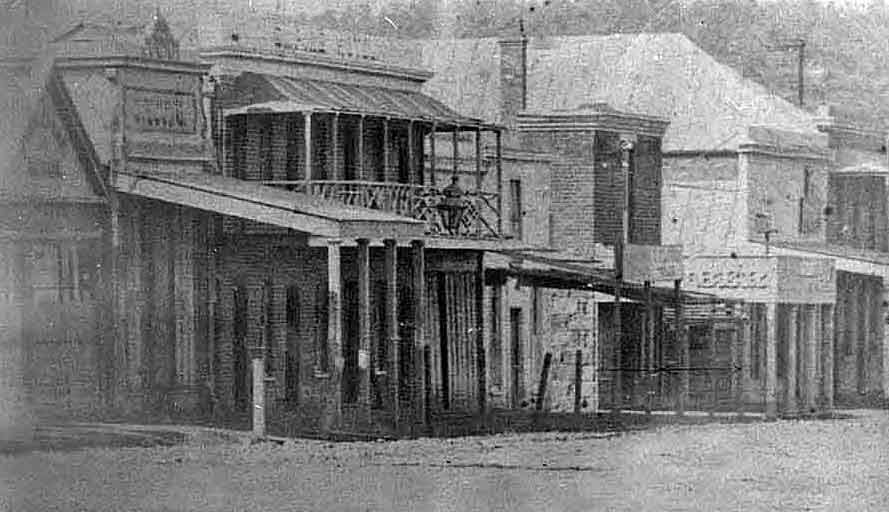
Camp Street, Beechworth. Above features the Empire Hotel. The Empire had formerly been the Smithville Hotel at the Woolshed before the entire wooden building is relocated to Camp Street where it will be destroyed by the Great Beechworth Fire on March 23rd 1867. Below features Henry Thomas Littlewood’s Manchester House on the corner of Ford and Camp Streets. It will later become a hotel, changing names a number of times (The Corner Hotel, Central Hotel) and, in 2022, becomes the home the Miss Amelie Gourmet Fine Foods.

1862 – May 3
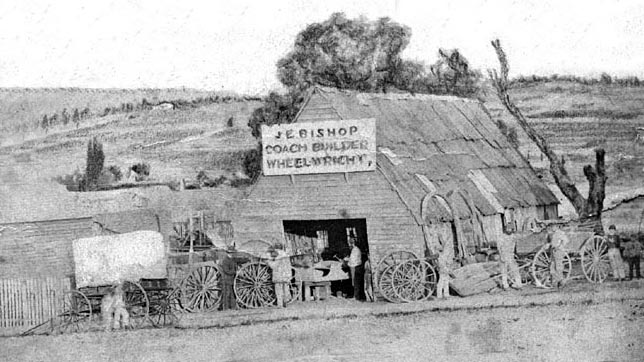
25-year-old Joseph Eldred Bishop marries 19-year-old Irish lass Mary Anne Cronan in Beechworth where Bishop runs his successful Coach Building and Wheelwright business on Newtown Hill. Joseph and Mary Anne (a dressmaker) will have nine children.
| Joseph Eldred Bishop will pass away at the age of 47 at his residence in Newtown on August 12, 1884, and is buried at the Beechworth Cemetery next to Mary Anne, who lives until the ripe old age of 91, dying on July 27, 1934. |
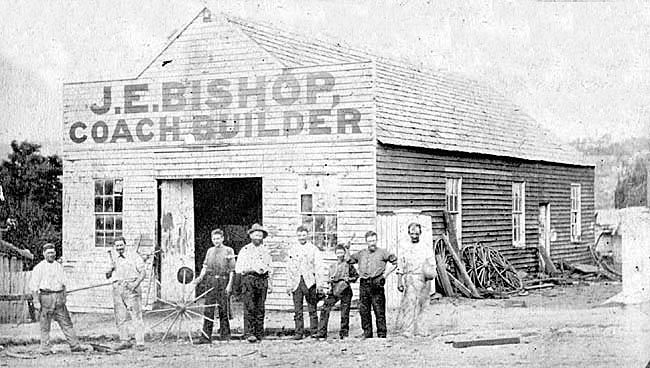
1862

A house is built at 39 Finch Street as a home for Alexander Greig. It is a single storey ‘Picturesque Gothic Revival’ style house of rendered brick on granite footings. It has an L-shaped plan and a steeply-pitched gable roof. The two gables each have small lancet windows and decorative timber bargeboards, leading to the house becoming known as ‘The Gingerbread House’. Expertly built by Greig, all the joints in the timber roof frame are mortised or bolted together, with no nails used. In 1863 Greig adds a second building on the site, with another structure added in 1867, closer to the house, to be used as a kitchen. The picturesque home – classified as a building of historic significance in 1972 – is still known locally as ‘The Gingerbread House’ and continues to be used as a residence (below).

| Alexander Greig is a master builder who arrives on the Beechworth goldfields from England in the late 1850s and quickly sets up a business as a building contractor. By the early 1860s he has established the firm of ‘Greig & Wilson’, dealing in hardware and builders’ supplies, and becomes one of Beechworth’s most respected early citizens. |
1862

In its first 5 years of operation, the Committee of Management of the Ovens Goldfields Hospital has spent £32,000 on buildings and maintenance and has admitted 3,600 patients for treatment. Even after hospitals are built in Albury in 1861 and in Wangaratta in 1871, many patients still prefer the grand hospital in Beechworth. And it will continue to grow: the ‘Albert Ward’ will be added in 1871 and the ‘Chinese Ward’ opens in 1883, both behind the main building.
| Although the Ovens Goldfields Hospital is intended as a philanthropic institution and is supported by generous donations from the community – especially from the Chinese – in practice it still relies heavily on government grants. |
1862
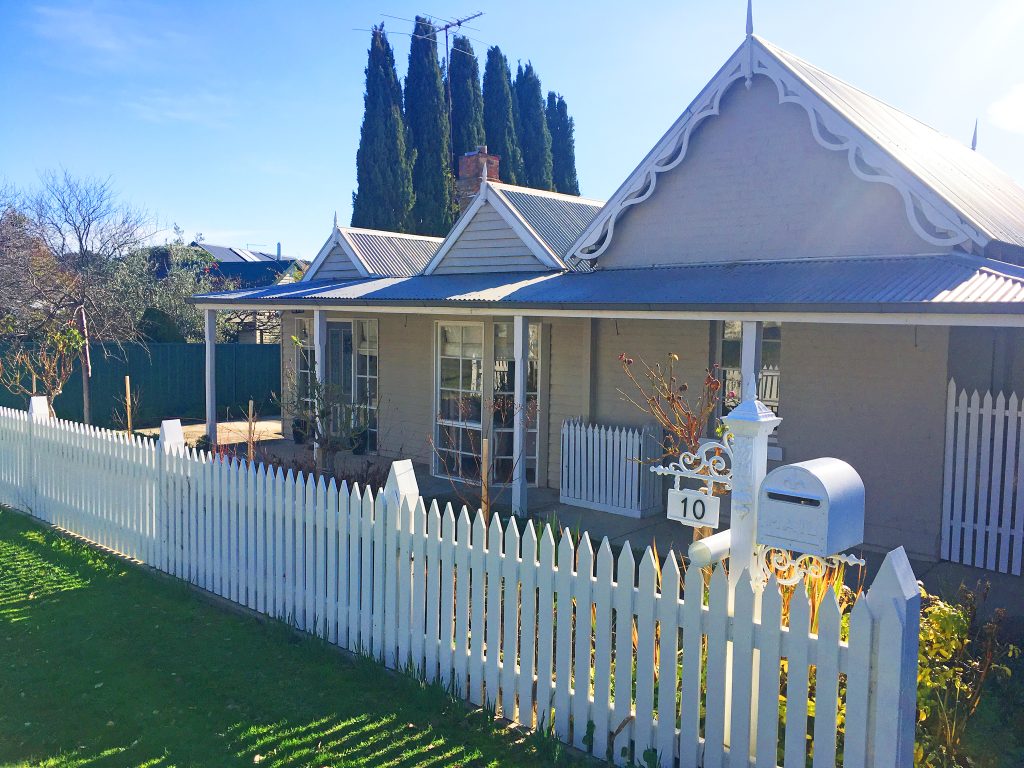
Beginning as a 16ft x 12ft calico tent with slab walls for miner Robert Chant, the slab walls are later replaced by weatherboards and the calico roof by shingles, evolving into Chant Cottage, a perfect example of an early miner’s cottage in Beechworth. Located at 10 John Street – quite close the original diggings beside Spring Creek – the original structure comprises the central part of the present three gabled building (above). It remains a significant part of the town’s history and is now registered by the Heritage Council of Victoria.

1862
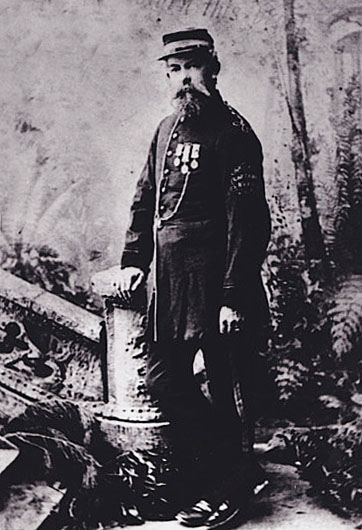
Hiram Allen Crawford’s young wife Anna dies at the age of 24, leaving him a widower with two young daughters, Martha and Emma. In poor health, Crawford – who established the ‘H.A. Crawford & Co’ coach business in Beechworth in 1856 – returns to his family home in New Hampshire in America, where he falls in love, returning to Beechworth in December the following year accompanied by his second wife Martha Alamanza Foster.
1862

Prussian emigrant Charles Ferdinand Ludwig Falck establishes a clock, watchmaking and jewellery shop on Ford Street, which also buys and sells gold. Falck’s Watchmaker & Jewellers shop windows become famous for their displays of his beautiful hand-made clocks. Falck also becomes the respected time-keeper at the Beechworth Racing Club.
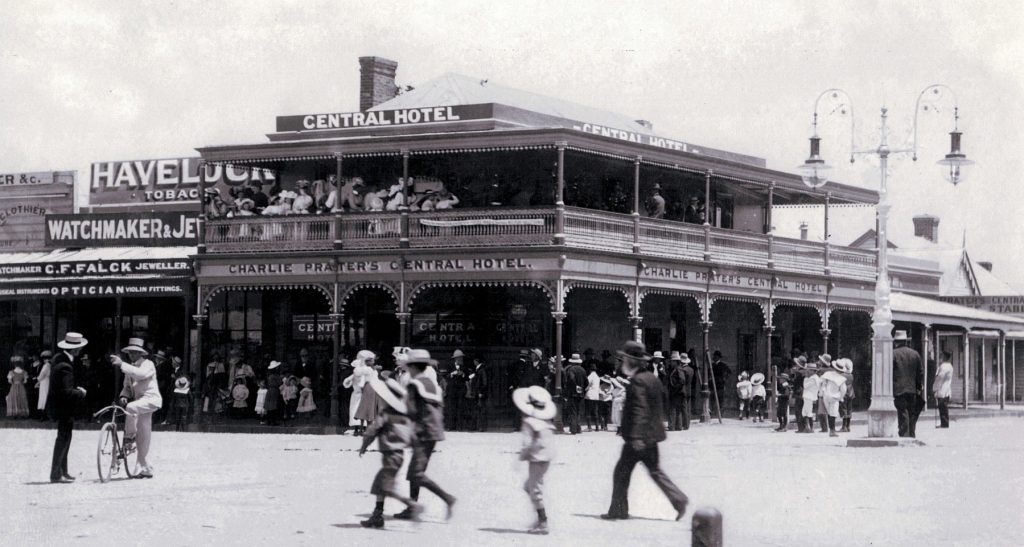
1862
The Beechworth Aclimatization Society seeks permission to erect an aviary next to the spring in the ‘Botanical Reserve’, although the recurring theft of newly planted trees at the Reserve is becoming a problem.
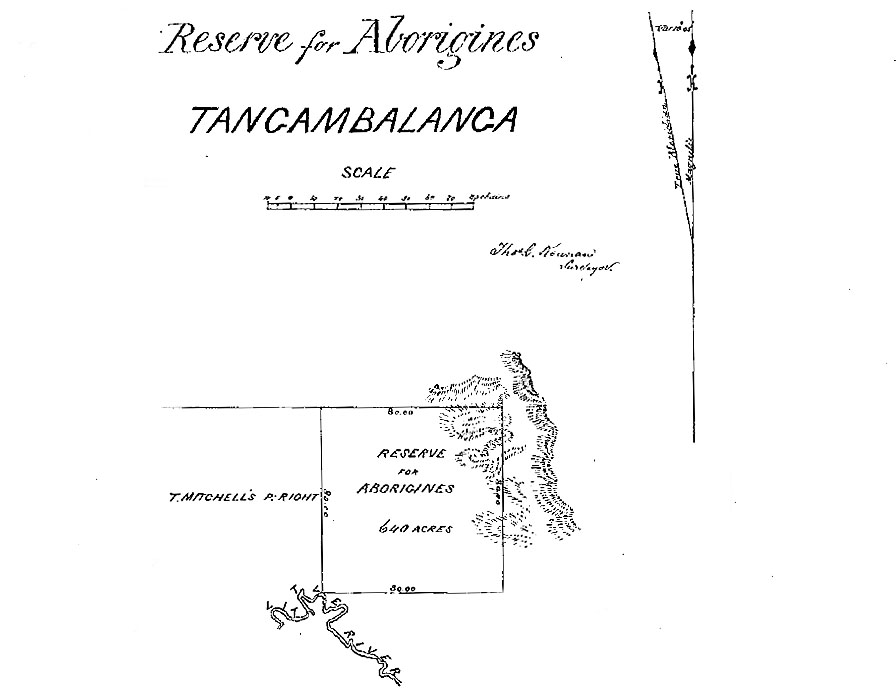
33km from Beechworth, 640 acres of gazetted land is cut from Thomas Mitchell’s Tangambalanga run to create the Tangambalanga Aboriginal Reserve.
1862
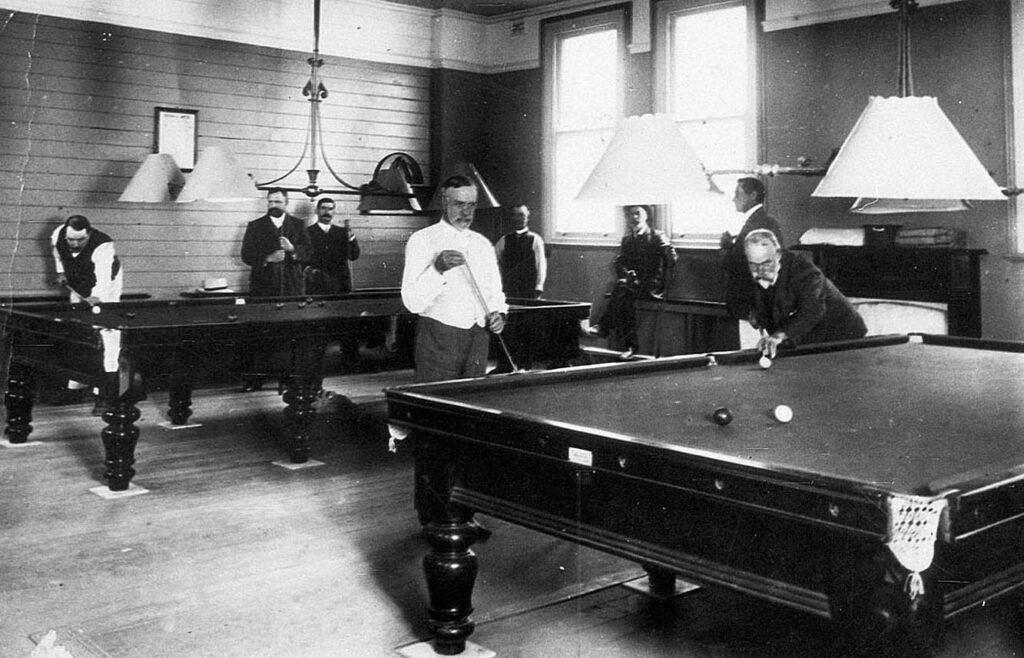
The Imperial Hotel opens for business at 56 High Street, Beechworth. Built by Edward Rogers, by 1865 he is advertising his hotel as “the best accommodation and amusement of any in the township” and offers a “magnificent Concert Room with grand Pianoforte”, an “American Cue Alley” (billiards) on the premises, with a vegetable garden and a range of fruit trees and beer hops at the rear, which backs on to Spring Creek. In 1868 he adds the “Imperial Swimming Baths” as an adjunct to the business, as well as a “Skittle Alley”, a “Quoit Ground” and he creates the popular “Beechworth Chess & Draughts Club”.
| Edward Rogers becomes well known in Beechworth for staging legitimate (and sometimes illegal) sporting activities either inside his ‘Imperial Hotel’ or in the hotels’s rear gardens beside Spring Creek. Ned Kelly will fight Isaiah “Wild” Wright at the rear of the ‘Imperial’ in an infamous bare-knuckle boxing match in 1874. |
1862 – Dec
The first dam wall at Hurdle Flat Swamp is completed, and the first filling of the newly-named ‘Lake Kerferd’ dam produces 20 acres of water. The dam is 17.5 feet deep and has cost £12,000 to date. There are additional costs of £2,000 following a dispute with a contractor.
| Sadly, following construction of the dam, the Council is on the verge of bankruptcy and the town continues to take its water from the municipal wells instead of the dam, and – between 1862 and 1872 – Lake Kerferd is unused, apart for annual regattas that are held on the Lake in the 1860s. Water from Lake Hume is sold to mining companies, but this is fraught with disagreements and a significant amount of ratepayers’ money is spent on fighting legal action. |
1862 – Dec 16

The Stanley District Road Board is established.
| A number of businesses operate on the Beechworth-Stanley Road by the 1860s to service people travelling between the two towns. These include Haworth’s ‘Stanley Arms Hotel’, ‘Douglas’s Hotel’, Little’s ‘Freemason’s Arms Hotel’, Ryan’s ‘National Hotel’ ‘Ellis’s Hotel’, a butcher’s shop and the ‘Crow Hotel’ at Silver Creek (above). |
1862 – Dec 24
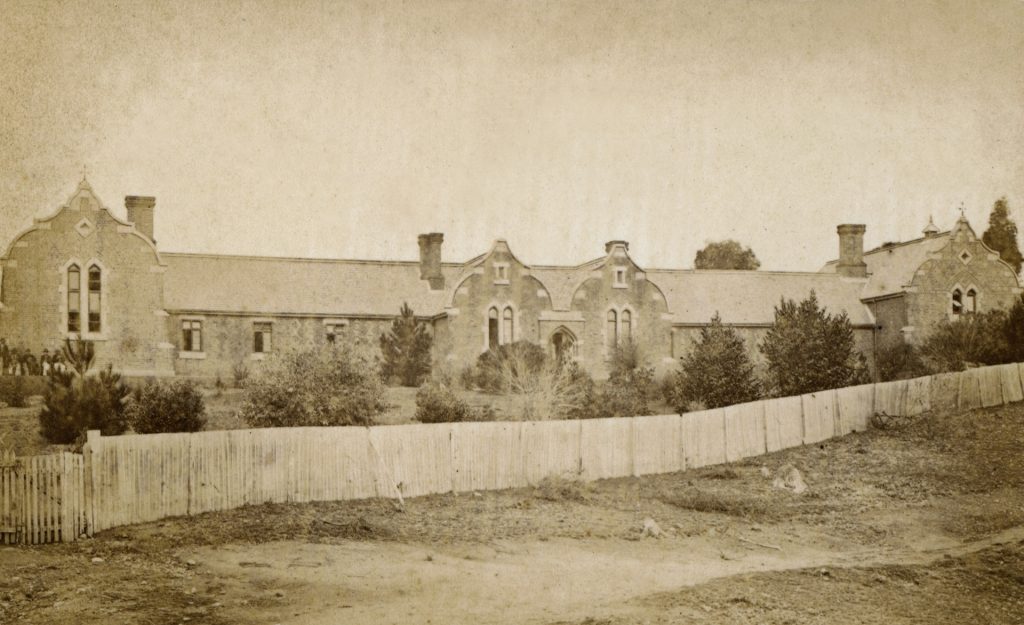
Construction commences on the Ovens Benevolent Asylum on (what is now known as) Warner Road. It will feature two large dormitories and numerous other smaller rooms and provide accommodation to those who require permanent care as a result of gold-mining injuries or other long-term incapacitating conditions.

| In the 1860s Beechworth has large number of Belgian miners, and the striking new building will be erected with a Flemish façade. The Flemish gables will be capped with stone dressings and decorative iron finials. The building will feature elaborate ‘diaperwork’ (patterns in the bricks) with all the bricks being handmade and glazed. For many years the Asylum’s striking and unusual Flemish gables remain a dominant feature on the hill above the township. |
1863 – Jan 21

Australia’s first State Funeral. In Melbourne – following the return of the remains of Robert O’Hara Burke and William John Wills after their death in central Australia in June 1861 – Burke and Wills are given a State Funeral. The bodies of the two explorers will then lie in state at the Royal Society Hall at the corner of Stephen and La Trobe Streets. Over fifteen days – commencing on January 21st – more than 100,000 people will file through the hall, to pay their respects and view the open caskets.

| On 15 September 1861 a Victorian relief party led by Alfred Howitt and Edwin Welch found the one survivor, John King, living with the Yandruwandha. The bodies of Wills and Burke are also found and buried. Their remains are later recovered and returned to Melbourne and re-buried. They are given Australia’s first state funeral on 21 January 1863. |
1863
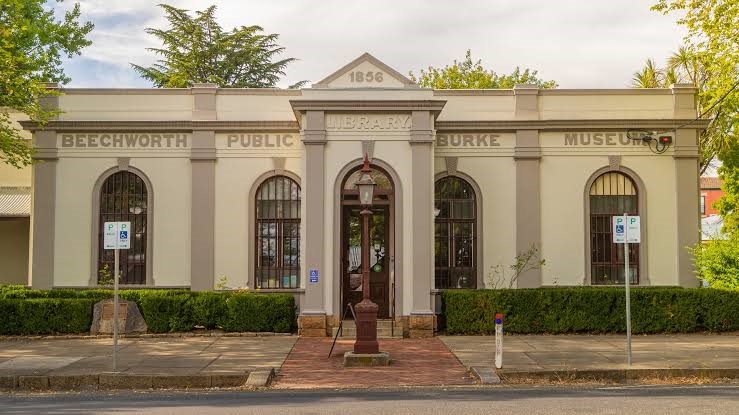
To honour Robert O’Hara Burke – Beechworth’s former Superintendent of Police – Beechworth Council purchases the Athenæum and Public Library on Loch Street outright and adds a ‘Museum of Science’ to the building, renaming it the Beechworth Public Library and Burke Memorial Museum. Items belonging to Burke will gradually be added to the museum’s collection, including an inscribed Bible given to Burke by his godmother A.H. Shawe Taylor, and saddlebags from Burke’s camel that had been found in October 1873 by John Conrick of Nappa Merrie Station on his property near Cooper Creek. The popular Museum still operates today, and is one of Victoria’s oldest.
1863
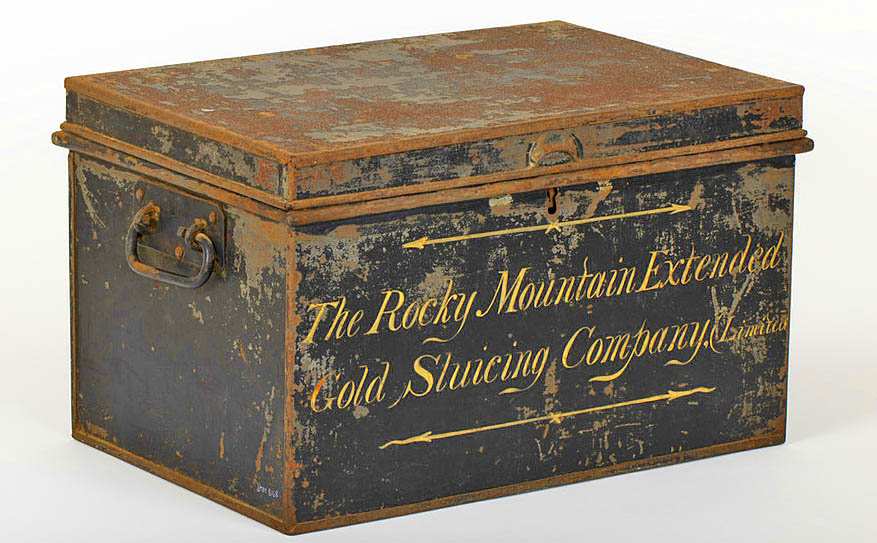
Miners at the ‘Rocky Mountain Extended Gold Sluicing Company’ sell out to George Briscoe Kerferd and Robert Ransom who, shortly after, float shares in the company to raise enough capital to increase the average depth of the tail race to 8 feet. These works are carried out between October 1867 and July 1869. It will cost the life of one of the workers who is killed during blasting operations.
1863 – Feb 21

30-year-old Beechworth pharmacist George Gammon and his wife Kate Gammon tragically lose Adelaide Anne, the first of their many children who will all perish from a range of conditions such as atrophy (wasting disease) and diarrhoea. Seven of the very young children – Adelaide, Frederick, Louise, Florence, Agnes, Constance and Alice – die progressively over the next 10 years. Their ages at death range from 9 weeks to two years, illustrating the trauma of family life in the 19th century, when so many children die from illness and disease which are now able to be treated. The Gammon children’s beautiful graves can be seen near the Rotunda at the Beechworth Cemetery surrounded by a hedge where, inside, is a statue of a sleeping baby, and the names of some of the children are inscribed on the statue pedestal (below).
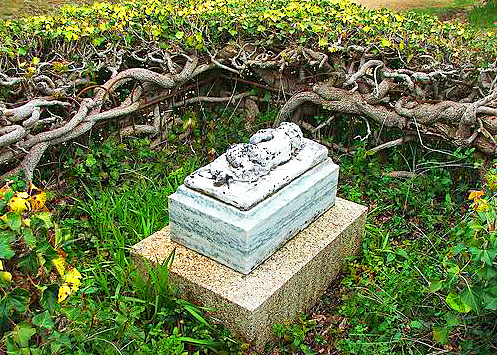
| By 1872, the Gammons had had eight children, but only one, Lucy Coles Gammon (1867-1955), is still alive. They will go to to have two more children who survive – Walter Herbert Gammon (1874) who will be killed in France in WW1 in 1917, and George Burgis Gammon (1878-1953). |
1863 – Feb 28

William Telford from Beechworth’s leading auction company J.H. Gray & Co. (established by the late John Henry Gray) is selected to run the auction of the Oriental Hotel on the corner of Bridge Road and Mellish Street in Newton, as owner James J. Moran has decided to retire. Sitting directly opposite Chevalier’s Flour Mill by the Newtown Bridge, the Oriental Hotel also adjoins a store which is included in the sale price. Alexander Thomson will be the successful bidder. Sadly, the Oriental Hotel will be destroyed by a fire on April 1st 1886.
1863
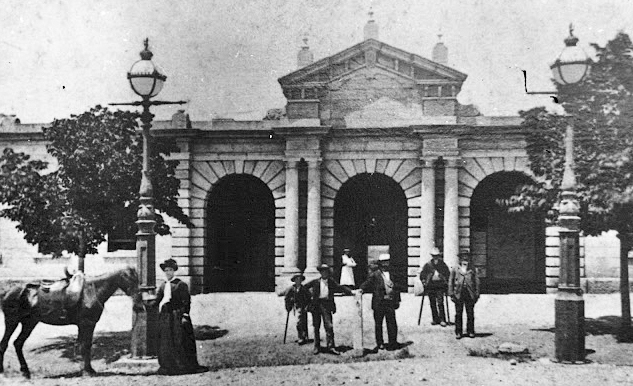
A grand façade is completed at the Ovens District Hospital on Church Street, finally uniting the hospital buildings behind it. Designed by James Harold Dobbyn, the façade is a long symmetrical Free Classical style composition of cut local granite in the ‘Palladian’ manner. It has arched windows and pediments at the centre and at each end. The central entrance is most elaborate, with three arched openings with rusticated voussoirs, pairs of attached columns and a Baroque-inspired pediment above. The end sections have Palladian-influenced triple windows. Symbolising the optimism and vision of the gold rush period, the Ovens Goldfields Hospital now has 100 beds, with injured diggers from the entire region coming to the hospital. First taking patients in 1857, in its first five years of operation, it will treat 3,600 people and be considered one of the finest hospitals in the entire colony.

| The driving force behind the establishment of the hospital, James Ingram, will remain on the hospital’s Board of Management for the next 72 years until his death in 1928 a few weeks before his 100th birthday! Before the hospital is built, Ingram and his wife Margaret nurse cases of fever among local residents in a tent. The Ingrams have a life-long interest in caring for ‘the sick, the poor and the afflicted’. |
1863 – Apr 24
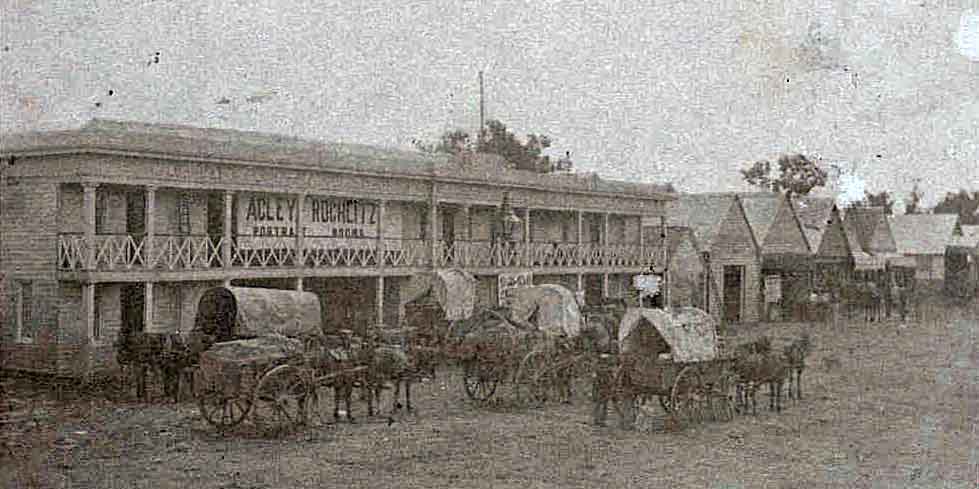
John Alston Wallace sells his Star Hotel on Ford Street to John Sitch Clark for £1,300. Wallace will begin to sort through his hotel’s fittings and possessions and then – during June and July – hold a number of ‘All Day Auctions’, putting up over 1,000 different items for sale, including furniture, bedding, bar fittings, carpets and curtains. By September, John Sitch Clark – who already owns the Empire Hotel on Camp Street which he had established in 1857 – has taken possession of the now empty building and, over the following months, he will demolish the central portion of the timber structure and begin construction of a two-storey brick building (which stands in the centre of Beechworth to this day – below).

1863 – May 12
Around 200 people gather at George Billson’s Wooragee Hotel to elect members for the first ‘Wooragee Road Board’ with 32-year-old Edward Boville Chandler voted to the chair.
| Born in Barbados in 1831, goldminer Edward Boville Chandler works at the fabulously rich Woolshed during the 1850’s and will be connected with Beechworth’s famous ‘Golden Horseshoes’ event in 1855. He will become a member of the ‘Beechworth Mining Board’ and be one of the pioneers of the El Dorado gold field. Sadly, Chandler’s journey from riches to poverty – and burial in an unmarked grave in Queensland in 1899 – will be the fate of many miners who ‘strike it rich’ only to vanish, except for occasional lines in old newspapers, one of which acknowledges Chandler as ‘a prince among prospectors’. |
1863 – Jun

After running the Brittania Hotel on the Woolshed diggings for six years, Jacob and Christina Vandenberg and their five children decide to move closer to Beechworth and take over the Vine Hotel (established by Robert Quirk in 1858) at the junction of the Woolshed, Chiltern and Yackandandah Roads – on the road out of Beechworth towards Wodonga – a popular stopping place on the Crawford and Connolly coach route.
| The ‘Vine Hotel’ building will stay in the Vandenberg family for many years, later becoming their private home, known as ‘Vine House’. It has since been demolished. |
1863
School inspector Wilson Brown visits the Woolshed Catholic School and records (future Kelly gang member) Joe Byrne as a handsome six-year-old who capably reads a passage from the Irish National Schools Second Book. Joe gains a ‘pass’ in reading but fails writing and arithmetic … as do all the other students in second class!
1863

A beautiful home – Gilmerton – is built at 16 Ford Street. It still stands today and features the original cellar, attic with pull-down ladder steps, surrounded by an English-style garden featuring 100 year old hedges, oaks and elms.
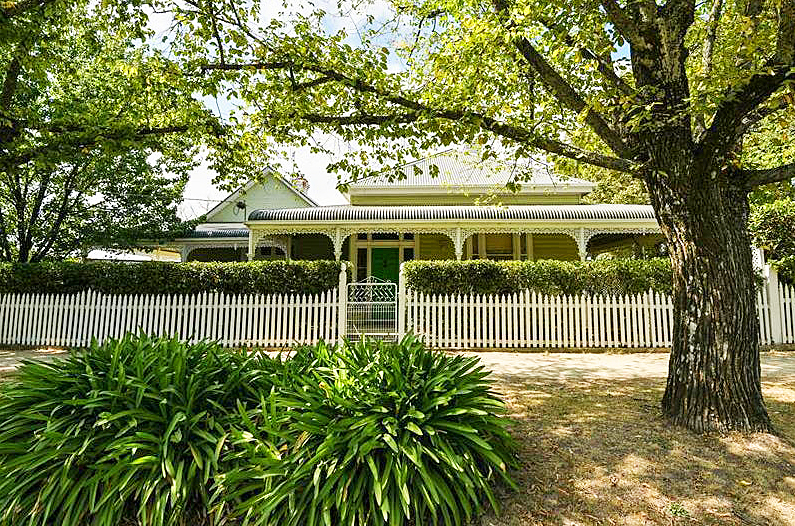
1863

The original tailrace cut through solid granite to drain the Spring Creek Flats under the Newtown Bridge (first cut in 1856) is further cut to a depth of 8 feet (2.4 metres) so that it is now 450 yards long. This lowers the water table so shafts can more easily reach bedrock. A thin layer of gold is often found on top of the bedrock, covered with black sand. Before the deeper tailrace is fully completed (in July 1869), one contractor will be killed in a blasting mishap.
| The deeper tailrace allows the continuation of goldmining on Spring Creek from 1869 to 1876 , during which time a further 6,500 ounces (around $91 million) of gold (at $1,400 per ounce) is discovered! |
1863

After importing grindstones from France, Louis Chevalier converts his sawmill beside Spring Creek – at the top of the Newtown Falls – to become the Beechworth Flour Mills. He also builds a beautiful home for himself and his family next to the converted flour mill. The Mill has long gone but the house still stands today beside the bridge at 2 Bridge Road (below).
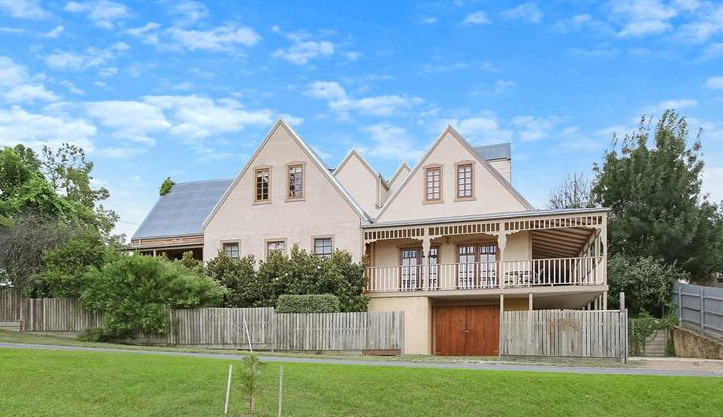
1863
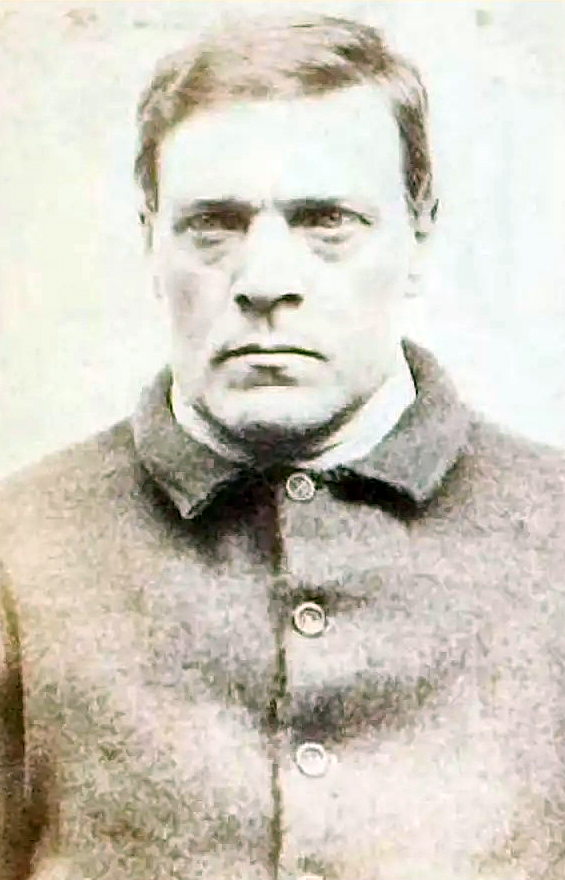
Horse-thief and cattle-duffer Harry Power (born Henry Johnson in Ireland) makes his first court appearance in Beechworth. He is represented by 44-year-old Beechworth solicitor William Zincke. This court appearance will be followed by six more, fronting Magistrates in Beechworth. He lives at Middle Creek in the Ovens District, where he is often assisted by the Kelly, Quinn and Lloyd families. Arrested on another charge of horse-stealing, he is sentenced at Beechworth on 19 February 1864 to seven years ‘on the roads’ hard labour.
| William Lawrence Zincke is a sought-after solicitor in the North-East of Victoria and will also represent Kelly gang members Joe Byrne and Aaron Sherritt, and defend Ned Kelly’s mother Ellen Kelly when she is charged, along with William Skillion and William Williamson, for the attempted murder of Constable Alexander Fitzpatrick. At the Glenrowan siege of 1880, the entrepreneurial lawyer offers his services to those involved and ends up acting for more than 20 Kelly sympathisers who are being held in the Beechworth Gaol. |
1863 – Sep 11
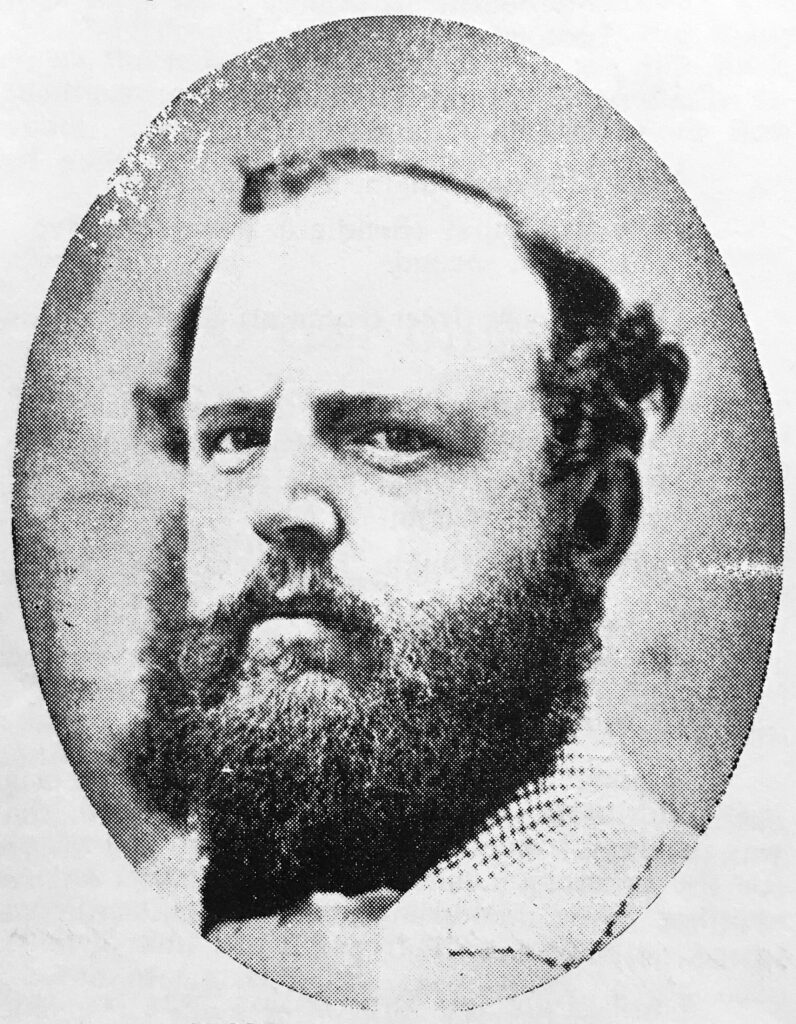
Beechworth, by statute, is proclaimed a ‘Borough’, a formalisation of the ‘Municipal Incorporation’ of the town that had occurred seven years earlier on 23 August 1856. George Briscoe Kerferd, who is currently the Chairman of the Municipal District of Beechworth is named the first Mayor of the Borough of Beechworth.
| First elected to the Municipal Council in May 1857, Kerferd serves as Chairman for three terms between 1858 and 1864 and, along with James Ingram, is also the driving force behind the establishment of the ‘Ovens Goldfields Hospital’ in 1856-57 and the ‘Ovens Benevolent Asylum’ in 1861-63. Kerferd is largely responsible for Beechworth’s unusual water scheme which, though eventually successful and still in use, will not be completed until 1874 because of engineering and funding problems. Beechworth’s large water storage area is known as ‘Lake Kerferd’. |
1863 – Sep 16

With the proclamation of the Borough of Beechworth, the government releases the following information – the Borough currently boasts 26 well-formed roads and streets, and some 550 stores and dwellings. There is also a Town Hall (also used as a Petty Sessions Court House), Council Chambers and offices, and the ‘Beechworth Athenæum’ – all under the control of the corporation; a Circuit Court House and offices, Treasury, Electric Telegraph Office, Survey Office, Warden’s Offices, Powder Magazine, Police Barracks and Gaol, under the control of the Colonial Government. There are four banks in the municipality – The Bank of New South Wales, The Bank of Victoria, The Bank of Australasia, and the Oriental Bank; a Masonic Hall, and soon a commodious Hospital, capable of holding seventy beds. The Beechworth mining district has a population of 14,373 European, and 3,974 Chinese miners, making a grand total of 19,211. The total number of all persons residing in the district is 30,883. There are 46 steam engines employed in mining in the district, with an aggregate power of 526 horses!
1863
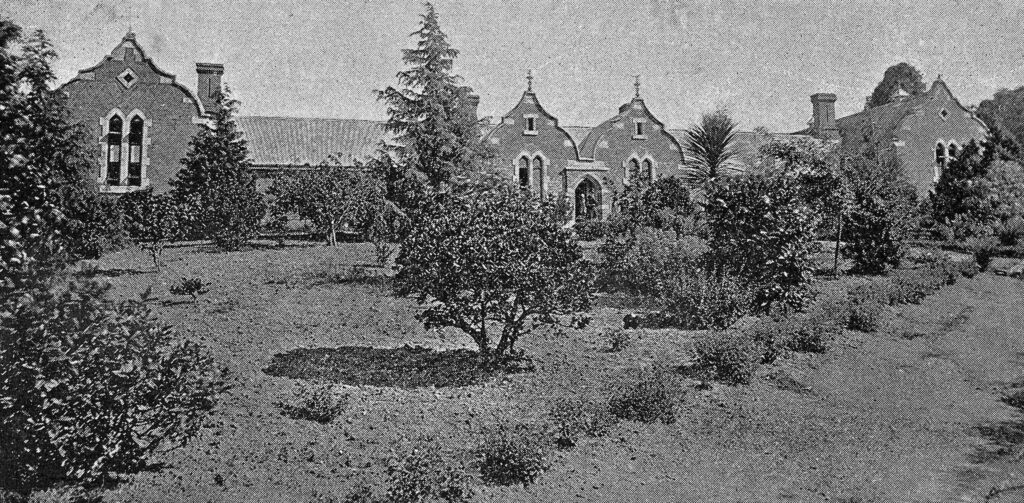
The Ovens Benevolent Asylum is officially opened. Once again, James Ingram is the driving force behind the establishment of the institution, as he had been in 1857 with the creation of the Ovens Goldfields Hospital. The Asylum provides accommodation to those who require permanent care as a result of gold-mining injuries or other long-term incapacitating conditions. In the four months after it first opens, several children whose parents have died or are in prison are also admitted to the institution.
| The Asylum’s flanking gable wings are added in 1867 and the ‘J.A.Wallace Wing’ dates from 1889. In 1935 it is renamed the ‘Ovens Benevolent Home’, then changed to the ‘Ovens and Murray Home’ in 1954. Two decades later, it becomes the ‘Ovens & Murray Home for the Aged’, before amalgamating with the ‘Ovens District Hospital’ in 1992 to become ‘The Beechworth Hospital for the Aged’ and finally the ‘Aged Care Division of the Beechworth Hospital’. The complex of single storey brick structures still stands on a hill overlooking the town and now operates as the ‘Beechworth Day Spa’. |
1863 – Nov 2

Now aged 31, American-born Hiram Allen Crawford becomes naturalised as an Australian citizen. The successful Beechworth coach company operator is now married to his second wife Martha and they will have four children together, although only two – Susie and Walter – will survive childhood.
1863 – Dec 26

After the Union Hotel on Ford Street is renamed the Temple Bar Hotel in 1861 (by new licensees Harry Ray and John Williams), it’s famous 18-foot-long ‘American Bowling Alley’ is refurbished and opens with “new balls, new pins, pine floor, and appointments”. The Temple Bar Hotel also advertises the fact that its rear yard is “the only one in Beechworth where there is room to accommodate a circus”!
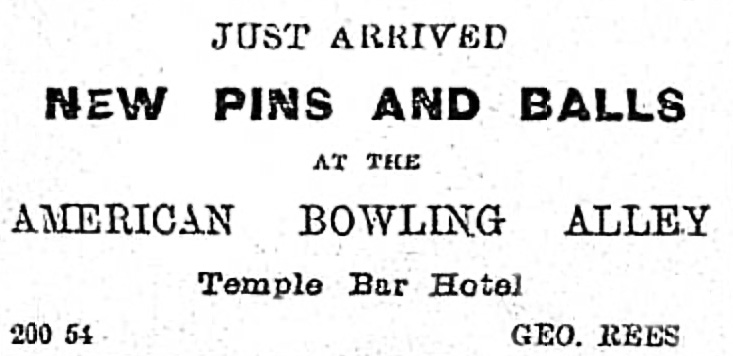
1864

Beechworth’s Anglican Christ Church – which stands proudly on the crest of Ford Street – finally gains a polygonal apsidal Chancel and commanding Tower, designed by Melbourne architect Leonard Terry (architect to the Anglican diocese). The total cost of the new additions is £3,000. Pairs of buttresses express each corner of the castellated 17-metre-high square Tower, and it is crowned by a castellated parapet. A timber vestry will be added in the 1870s. Below, the two wide-view images of Beechworth show Christ Church before – and after – the Tower is added …

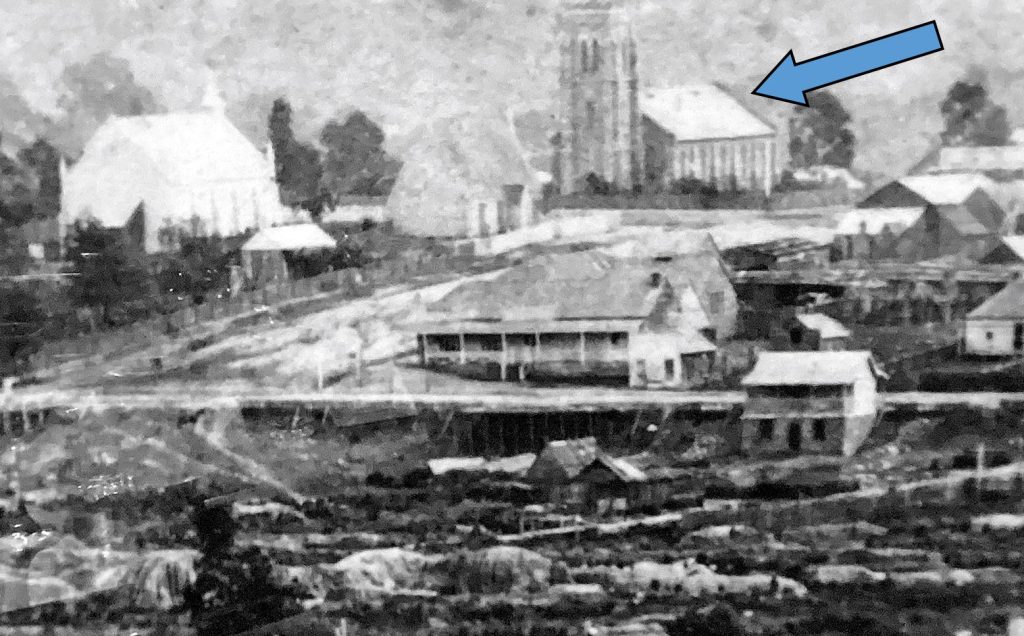
| Originally ‘Christ Church’ is at the centre of the ‘Archdeaconry of Beechworth’ which embraces Beechworth, Eldorado, Myrtleford, Bowman’s Forest and the surrounding district. By 1901 – when the focus of population has shifted – Beechworth will become a smaller parish which is absorbed into the ‘Diocese of Wangaratta’. |
1864
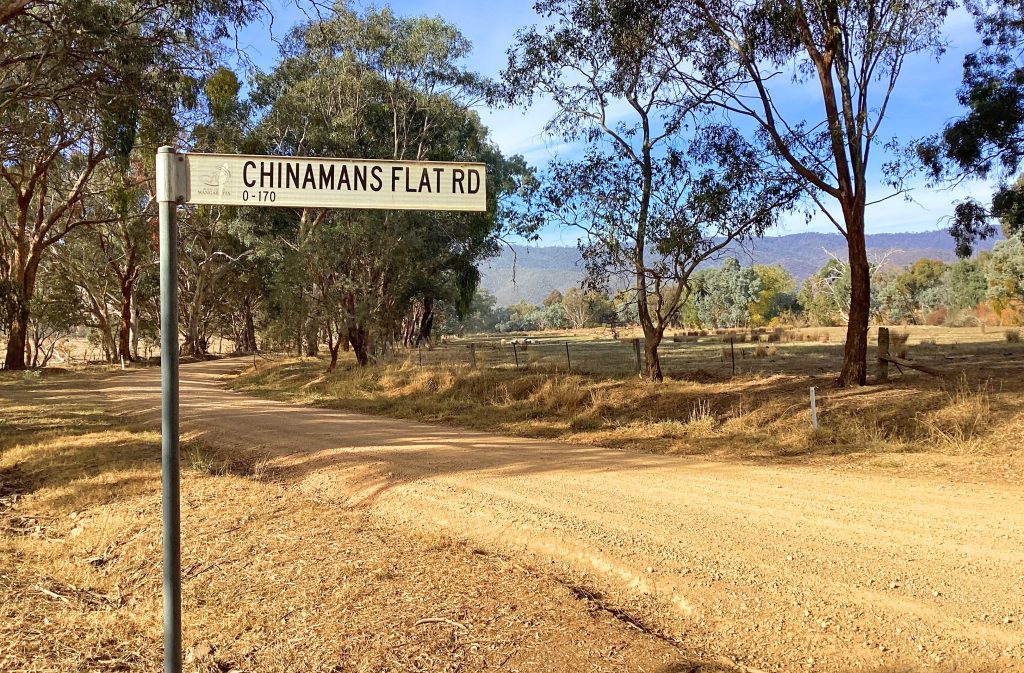
The 1864 Mining Register for the Beechworth District lists 60 Chinese men mining for gold at ‘Chinaman’s Flat’ at Murmungee, 11 km from Beechworth, and the name ‘Chinamans Flat Road’ comes into common use. It is still the name of the road today.

Forty-five surviving aborigines from the Ovens, Kiewa and Mitta Mitta Valleys are taken to the Aboriginal Reserve at Tangambalanga, which covers 640 acres of gazetted land cut from Thomas Mitchell’s Tangambalanga run. This small number of First Nations people reflects the severity of genocide that has swept the region over the previous 30 years
| By 1872, the policy of removing First Nations children from their families is in force across North-East Victoria, further crippling the surviving communities. |
1864 – Jun 19
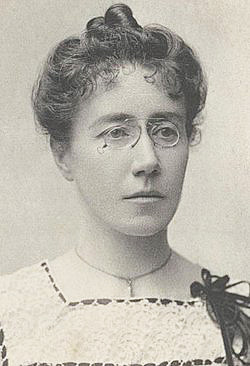
57 km from Beechworth, Christina Rutherford Macpherson is born at Peechelba Station near Wangaratta, the ninth of eleven children born to Ewen Macpherson and his wife Margaret Rutherford who had migrated to Australia from Scotland around 1854. Peechelba Station, a property of about 150,000 acres, is jointly owned by the Macphersons and Rutherfords who have homesteads close to each other. Christina will grow up to compose the music for Banjo Paterson’s “Waltzing Matilda” in 1895 (based on a piece of Scottish music she had heard called “Bonnie Wood O’ Craigielea” which had later been converted into “The Craigielee March” by Godfrey Parker (aka Thomas Bulch) in Warnambool).
| Christina Macpherson played her composition on a zither (autoharp) to Banjo Paterson, inspiring him to write the lyrics to “Waltzing Matilda”. Her contribution in composing the music is confirmed in 1991 with the discovery of one of her letters describing how she and Banjo Paterson collaborated in writing the song, followed by the further uncovering of the original sheet music in Christina’s handwriting, clearly demonstrating that Christina played a vital part in the composition of famous song. Christina never marries and dies in obscurity on March 27 1936. Buried next to her father and other members of her family at the St Kilda Cemetery, she leaves her entire estate worth £3,624 (about half a million dollars in 2014 currency) to her younger sister. |
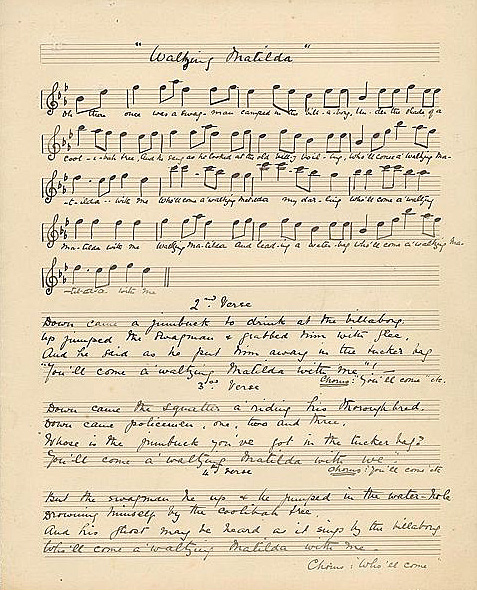
1864 – Jun 29

Philip Peter Jacob Wirth is born in Beechworth. He is the son of Bavarian musician, Johannes (John) Wirth and his English wife Sarah, who had arrived in Victoria during the height of the gold rush in 1855. As a boy, young Philip and his three brothers all play musical instruments in their parent’s travelling band, the Star Group of Musicians. After touring for a while as musicians and circus performers with Ashton’s Circus, the family set up their own troupe, which will become Wirth’s Circus. Johannes dies in 1880, but his sons carry on, adding to and improving the show until, in 1887, Wirth’s is the largest circus in the country and for the next eight decades Wirth’s Circus becomes known as Australia’s own ‘Greatest Show on Earth’, a huge travelling circus of international standard and reputation. Wirth Brothers Circus Ltd is incorporated in 1913 and at its height – under the guidance of Philip Wirth and his younger brother George – the circus tours 40 artists and another 110 support staff, 10 elephants, 40 horses, 14 cages of wild animals and eight tents, the largest seating 3,000. The special Wirth’s Circus Train consists of eight passenger cars and 20 wagons!
| In 1893, to escape the Depression in Australia, ‘Wirth’s Circus’ embarks on a seven-year world tour: South Africa, South America, the United Kingdom, South Africa (again), India and Java. During their extended stay at Southport in England, they are visited by the Prince of Wales, the future King Edward VII, who is particularly impressed by Philip Wirth’s six trained Australian brumbies. When ‘Wirth’s Circus’ finally returns to Australia in 1900, they bring with them the first of their famous herd of elephants. Until ‘Circus Oz’ is established in the 1970s, Wirth’s is the only Australian circus to undertake a world tour. |

1864 – Jun 30

After a fire destroys ‘The Plough Inn’, the 1861 single-storey weatherboard hotel at Tarrawingee, Hopton Nolan rebuilds his popular pub as a two-storey brick building 24km from Beechworth (which still stands today – see photo below). The bricks are made using soil from local paddocks and the new building contains large stables at the rear, used by Crawford and Connolly as a regular changing station for their horses and coaches.
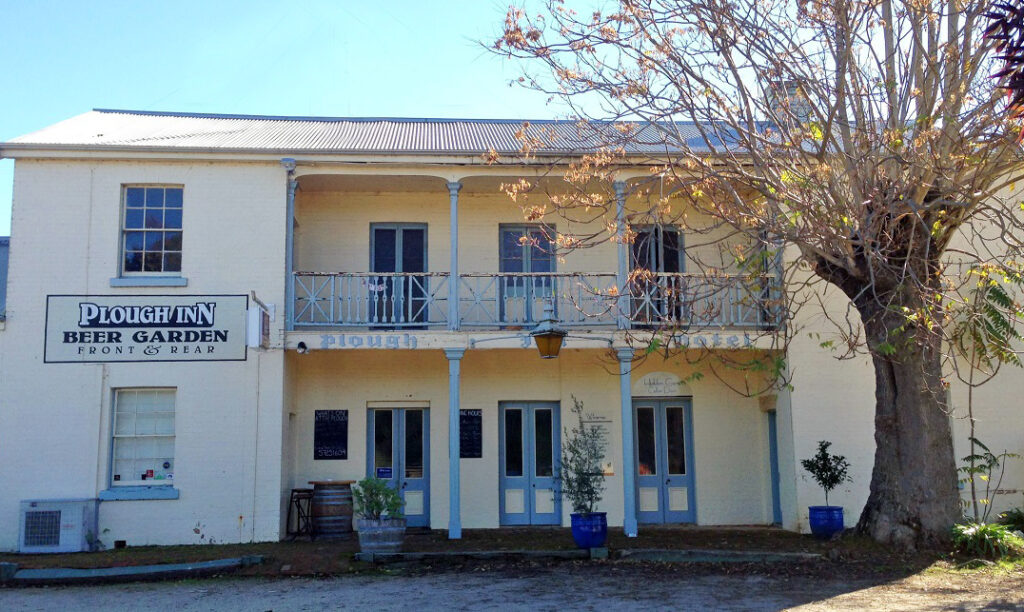
| In the mid-1860s, the settlement of Tarrawingee continues to grow. Along with Hopton Nolan’s newly rebuilt ‘Plough Inn’, Bernard Devery establishes the ‘Red Lion Hotel’, Wallis H. Rudduch builds the ‘Australian Arms Hotel’, and George Strain opens his ‘Seven Oaks Hotel’. There are now an astonishing 16 hotels along the Beechworth Road, between the bridge over the Ovens Bridge at Wangaratta and the Newtown Bridge at Beechworth! |
1864 – Jul
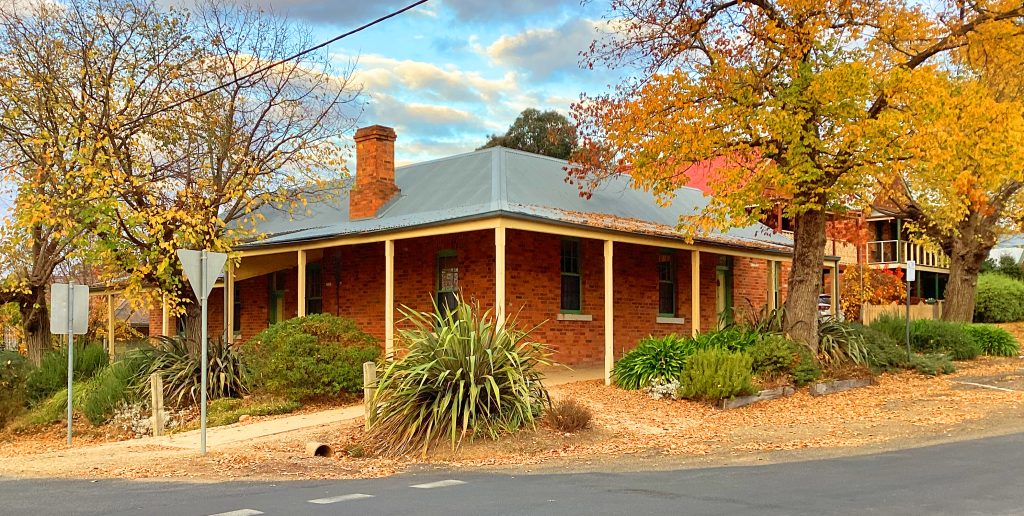
Despite initial objections from the Reverend W.C. Howard and the committee of the Church of England School directly across the road on Church Stret, the light red brick Harp of Erin Hotel gets its licence and opens on the corner of Loch and Church Streets in Beechworth, with 29-year-old Thomas Waugh – a Beechworth baker for the previous 8 years – as the hotel’s first licensee (see advertisement below). In January 1869, Waugh’s Irish wife Maria will pass away suddenly of dropsy (enlargement of the liver) at the age of just 32, and then, two months later on his way to Melbourne, 34-year-old Thomas will die at Avenel on March 7th. Subsequently, the hotel is sold for £585. The (rebuilt) building still stands today and is now a private home (above).

| When Thomas Barmby takes over the ‘Harp of Erin Hotel’ in 1902 it is briefly renamed ‘Barmsby’s Hotel’ but reverts back to the ‘Harp of Erin’ in 1905 when Rosanne Stewart becomes the licensee. It will retain its licence until 1916. The Ball family, who own the building, retain the large corner block on which the old hotel stands and eventually demolish the hotel, but go on to rebuild it in the same shape and style in 1990, utilising the building’s original light-red bricks and is now a family home. |
1864 – Jul
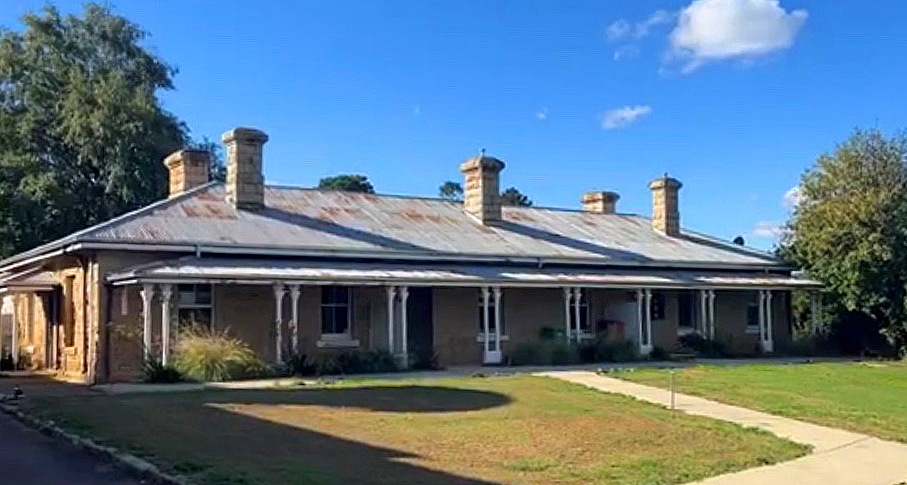
The Beechworth Gaol Governor’s House is completed next to the Beechworth Gaol. It’s first resident is Gaol Governor John Buckley Castieau. The house is built using prison labour utilising granite from the quarry behind the Gaol. Castieau will live at the 1,374-square-metre property until 1869, when he leaves Beechworth to become Governor of Pentridge Prison in Melbourne. Subsequent governors live in the house before a home is built inside the gaol itself. In the 1940s the property is divided into three separate homes.
| During Castieau’s tenure as Beechworth Gaol Governor between 1856 and 1869, the Gaol is known as “Castieau’s Castle”. He meets his wife Polly in 1858 at a church bazaar, and the couple live in the Beechworth property with the first of their 10 children once it is built. Castieau is the government representative at Ned Kelly’s hanging on November 11th, 1880 as he is governor of Old Melbourne Gaol by then.. |
1864 – Jul 14
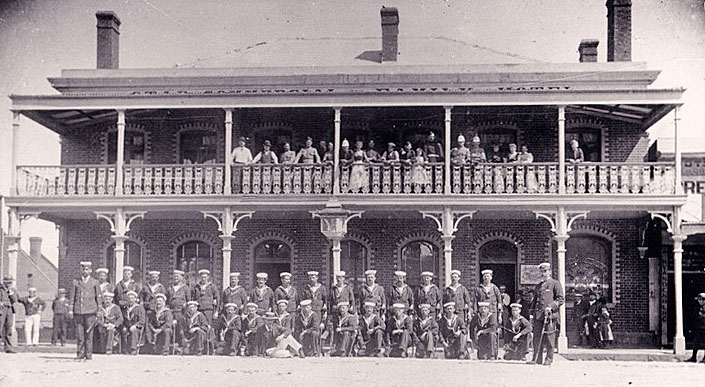
A ‘champagne lunch’ lunch is held to celebrate the official re-opening of Beechworth’s Star Hotel on Ford Street. This follows John Sitch Clark’s purchase of the building in March the year before and his costly rebuilding of the wooden structure in brick. The ‘new look’ Star Hotel will continue to be the focal point of social life in Beechworth and stands for a time as the largest hotel in the district. Notable features include its deep verandah to the street and an elegant drawing room on the first floor (below).
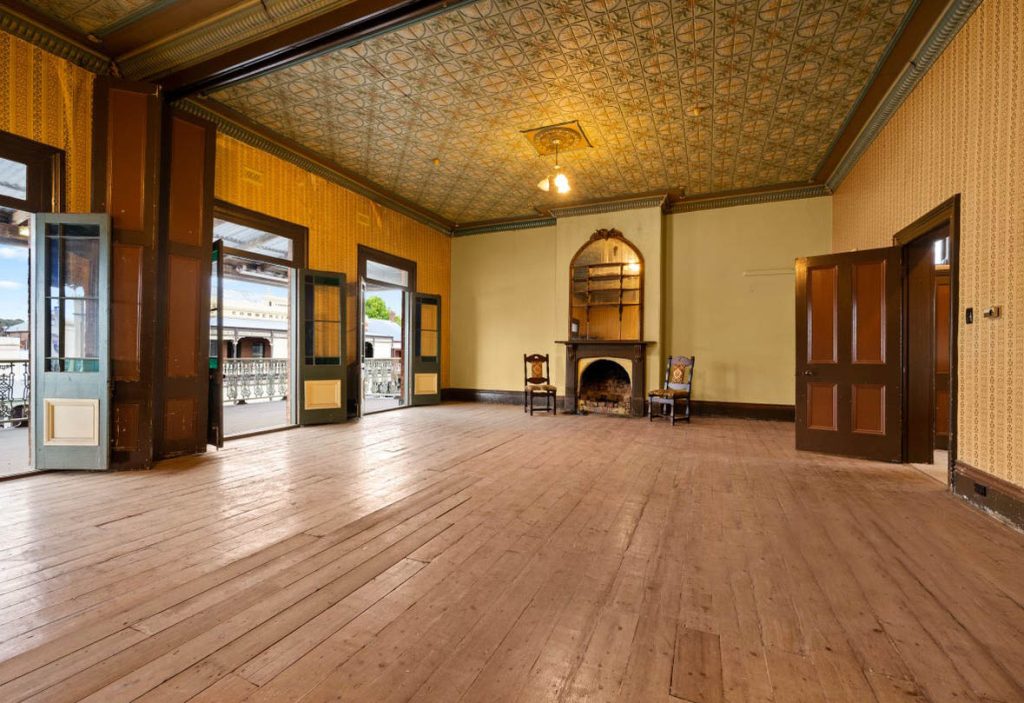
| In 1922 the ‘Star Hotel’ will be renamed the ‘Star Coffee Palace’ by new owner Mary Jane Rogers, but the new ‘no-alcohol’ policy will only last a couple of years. In the late 20th century it becomes a ‘Youth Hostel’ and later, the ground floor of the building will converted into two shops which still operate today. |
1864
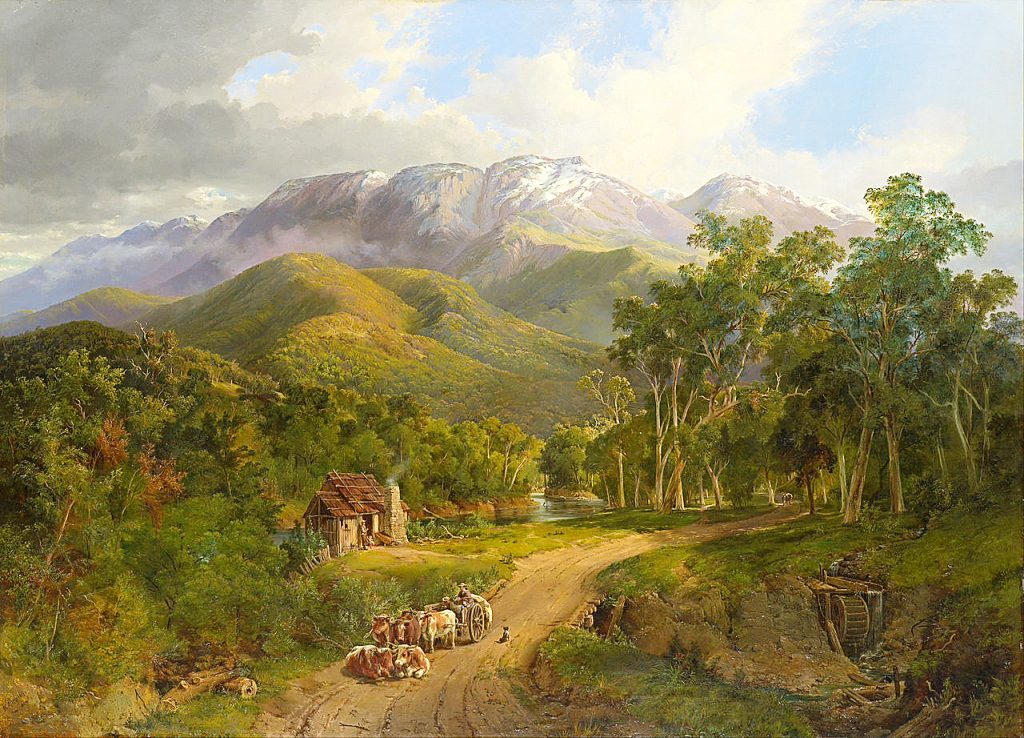
Russian-born artist Nicholas Chevalier – brother of Louis Chevalier who operates the Beechworth Flour Mill – paints “The Buffalo Ranges”. It is promptly exhibited among works of other Victorian artists at a Melbourne Gallery. As the National Gallery of Victoria has just been established, the government announces it will purchase the best picture at the exhibition for £200. Chevalier’s oil painting is selected and “The Buffalo Ranges” becomes the first artwork painted in Australia to be included in the Melbourne collection.
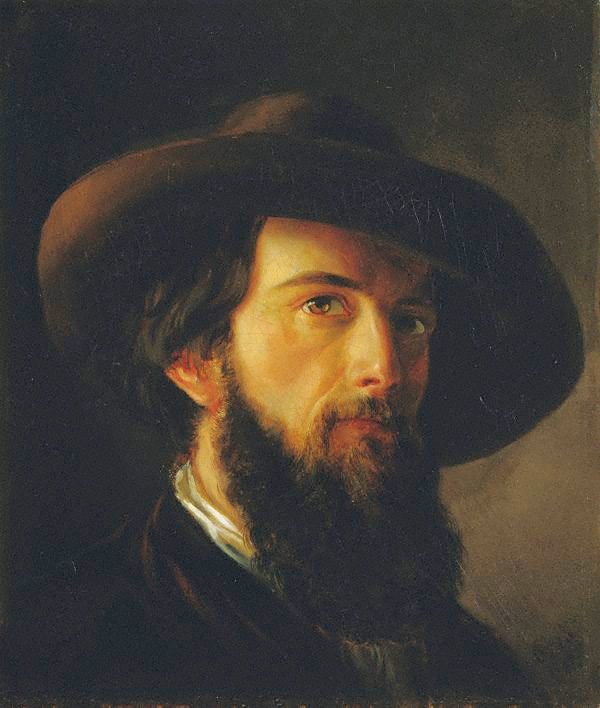
1864 – Aug

Irish-born Timothy Keane and his family take over the El Dorado Hotel on the corner of High and Church Streets. Standing on half an acre of land, it had originally opened as Beechworth’s second hotel in October 1853 by C.H. Palmer. The 14-roomed wooden El Dorado Hotel and the stables next door will be renamed the Exchange Hotel in 1869 (above) by the Keane family, who will own and run the hotel for the next 30 years. Mary Keane will take over the running of the Exchange Hotel from her husband Timothy in 1875.
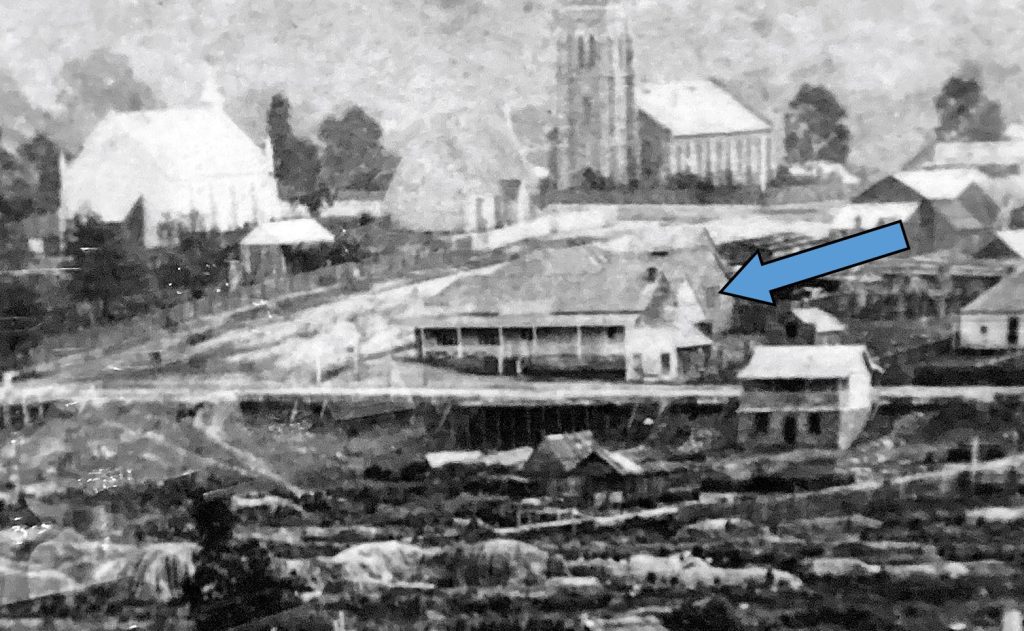
1864 – Aug
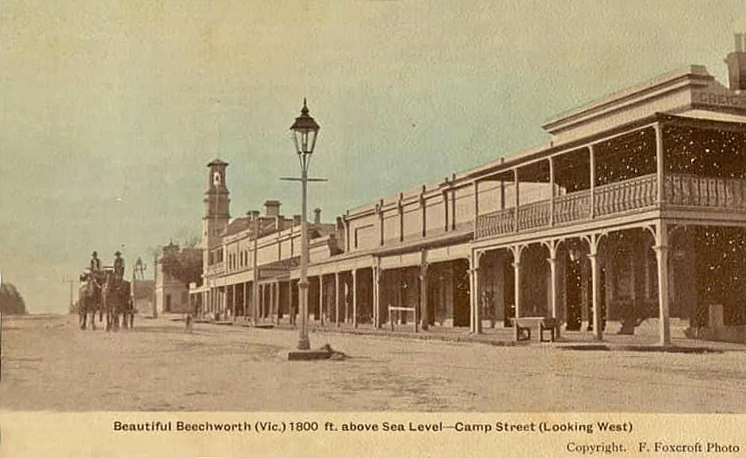
The Metropolitan Hotel opens on the corner of Camp and High Streets (where the current Empire Hotel stands today). The large two-storey red-brick building is commissioned by 34-year-old Canadian Richard M. Murton, the former landlord of the original Empire Hotel. During the summer months, the Metropolitan is advertised as “the only really cool place in Beechworth”, where the colonial wines are “‘of the best quality and cold as ice”.
1864
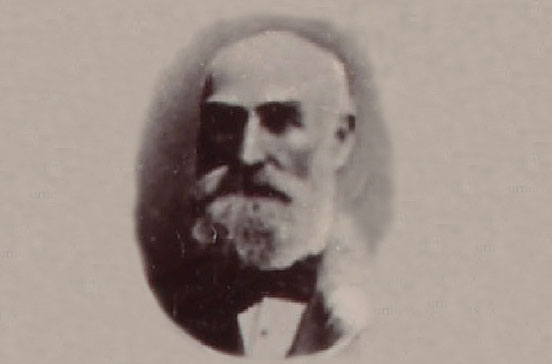
Like a number of other Beechworth shop owners, 32-year-old druggist George Gammon decides it’s time to replace his single-storey wooden shop with a more solid brick building. He tears down his wooden Medical Hall business at 55 Ford Street – directly opposite the Commercial Hotel in the centre of town – and starts to build an impressive two-storey brick shop, with family residence above.
1864 – Nov
An announcement is published in the Government Gazette stating that “An order is given to reserve a site in Beechworth for a Lunatic Asylum, being 201 acres, 2 rods, 26 perches”. Tenders are called for the design and construction of the Asylum, with the deadline set at November 2nd. No specifications are sent to Beechworth, precluding locals from the tendering process.
1864 – Dec 3
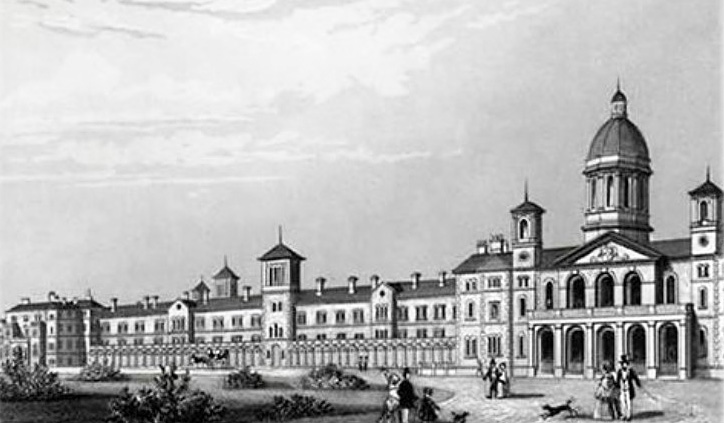
It is announced that the tender to erect the first portion of the Beechworth Lunatic Asylum has been awarded to Abraham Linacre of Carlton in Melbourne, with a contract for £12,000. It is estimated that the final cost for the entire project will exceed £100,000. Initial plans for the design – by prominent Melbourne Public Works architect 26-year-old John James Clark – are based on the influential Colney Hatch Asylum (above) near London which features an Italianate design with an ‘E-Shaped’ plan of administration, recreation halls, kitchens, stores, and dormitory wings with airing courts and covered walkways.
| Built as the ‘Second Middlesex County Asylum’ in 1851, it is located in the parish of Frien Barne, close to a crossroads which has a hamlet known as Colney Hatch and so it becomes widely known simply as the ‘Colney Hatch Asylum’ and for much of the 20th century, its name is synonymous among Londoners with any mental institution. At its height, ‘Colney Hatch’ is home to 2,500 mental patients and is famous for having the longest single corridor in Britain, taking a visitor more than two hours to walk all of its wards! |
1864 – Dec

The Inspector General of the Public Works Department approves construction of a new, larger clock tower at the 1858 Beechworth Post Office. The new tower will be completed by 1865 and is surmounted by a handsome granite bell turret. The bell chimes on the hour. Although provision is made for a clock with four faces – facing north, south, east and west – only three sides have ever functioned. A persistent rumour for the ‘three sides only’ suggests that it is to deprive the prisoners at the Beechworth Gaol (to the north) from seeing the correct time! But the more logical reason is that the cramped space of the bell tower inhibited winding the clock and the clock mechanism for a fourth clock face. The clock has since been converted to electronic operation.
| The 1865 ‘Beechworth Post Office Bell’ is claimed to be the oldest Post Office bell in Victoria. |
1865 – Jan 1

Druggist George Gammon officially opens his new purpose-built two-storey Medical Hall Pharmacy and dwelling at 55 Ford Street. George and his wife Kate will run the business successfully until 1896. Today the Beechworth Laundromatt operates from the ground floor of the building.
| The 1860s and 1870s are very prosperous for Gammon, who accumulates significant wealth, and he will become an investor and major shareholder in a great many Beechworth gold-mining companies and businesses. |
1865
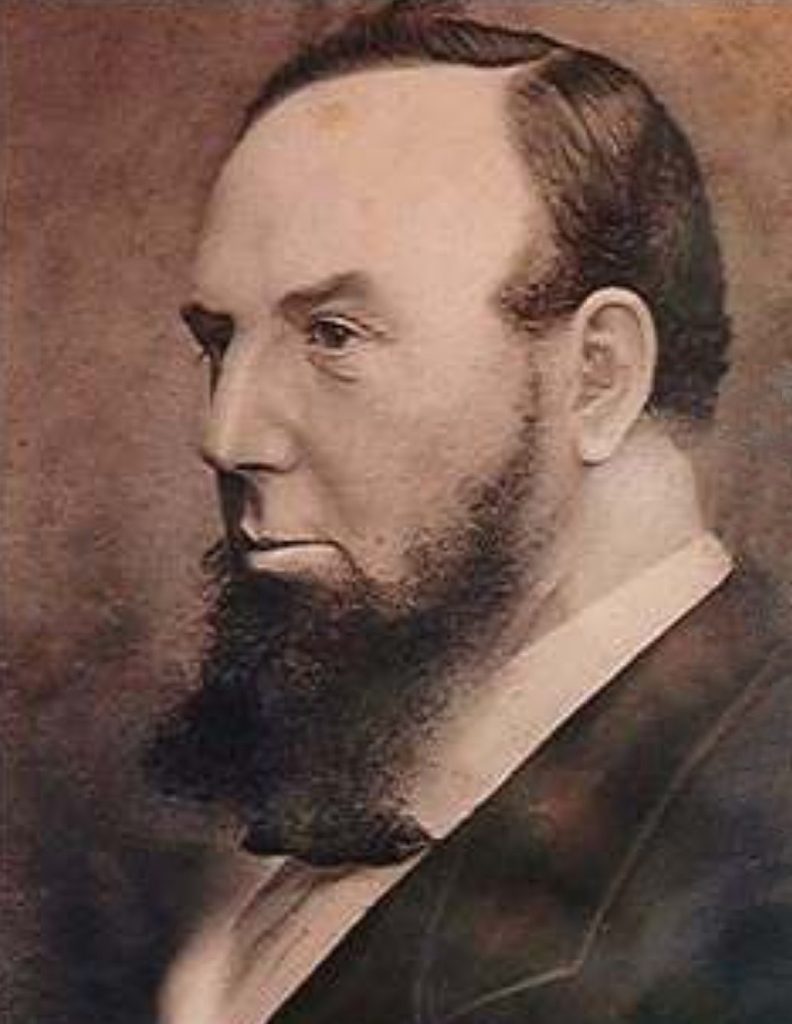
Having first been elected to the Beechworth Council in October 1859, popular local Pharmacist William Witt is now elected Mayor of Beechworth, serving a 12-month term in the role. This will serve him well when he is elected to the Victorian Legislative Assembly as the member for Murray in 1868, where he is instrumental in the establishment of the railway line between Melbourne and Wodonga. In 1872 Witt becomes President of the new Melbourne shire of Nunawading, remaining there until his retirement in 1880. He builds a large family home called Heathersett, set on 33 acres of land at the corner of Elgar Road and Burwood Highway. The two-storey sandstone house is now the administration building for the Presbyterian Ladies College in Burwood.
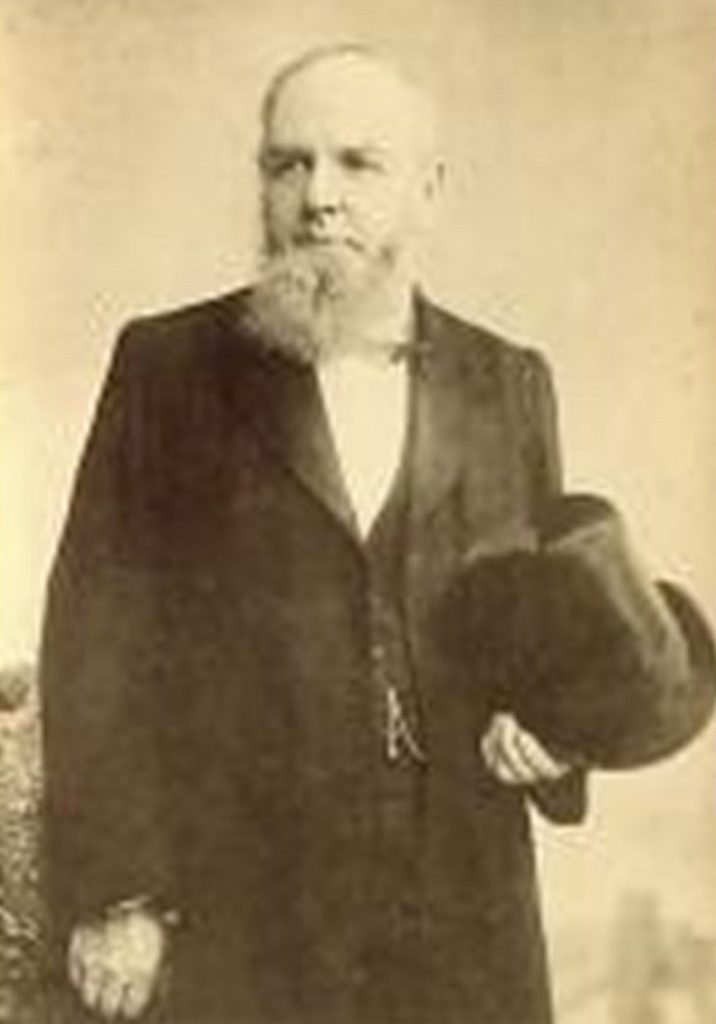
| A busy and dedicated citizen, Witt becomes a Justice of the Peace in 1863 and will serve on the bench of the Beechworth Court for the duration of his time in Beechworth. Witt is also one of the founding members of the ‘Beechworth Fire Brigade’ in 1867, serving as its secretary; a founding member and Governor of the ‘Ovens District Hospital’ and, at different times, serves as its chairman, secretary and treasurer of the Board of Governors; founder of the ‘Beechworth Prospecting Association’; a founding member of the ‘Beechworth Lunatic Asylum’ and the ‘Ovens Benevolent Society’. In 1857 Witt becomes a foundation member of the ‘Pharmaceutical Society of Victoria’ and is the Society’s secretary for the Beechworth district. |
1865

Almost 90 acres of vineyards and market gardens are now under cultivation in the Beechworth district.
1865

American pharmacist and prominent civic leader J. C. Lyons moves his growing ‘soap works’ from Beechworth to Wangaratta. He has been operating the popular Lyons Soap Works for a number of years beside the One Mile Creek (next to where the 1876 Beechworth rail line will be built) and Lyons is well known for his ‘Windsor’, ‘Almond’ and ‘Rose’ soaps, as well as a range of powders and perfumes. The business will be sold to J. Kitchen & Sons in 1887 – who operate 34 soap and candle factories throughout Victoria – who will maintain operations of the Wangaratta factory until 1938, by which time John Ambrose Kitchen has introduced ‘Velvet Soap’ (in 1906) and ‘Solvol’ (in 1915). In 1914, when J. Kitchen & Sons are employing 1,000 workers across Australia, it will merge with Lever Bros and become known as Lever & Kitchen (now Unilever).

1865
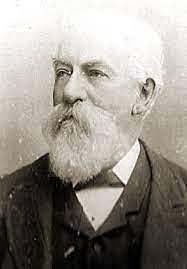
Deciding to expand his coach business further, Hiram Crawford purchases John Alston Wallace’s old Star Hotel in Chiltern and rebuilds the pub, adding large stables. From there the ‘Crawford and Connolly‘ coach routes are expanded to run west, as well as Wodonga and Albury.
1865 – Apr 2

Having shot and killed Sergeant David Maginnity (sometimes McGinnerty) about fifteen miles east of Tumbarumba while they’re returning from Coppabella Station in NSW in 1864, 35-year-old Daniel ‘Mad Dog’ Morgan has been warned by authorities not to cross the border back into Victoria. He ignores the warning in April 1865 and within hours he steals a racehorse at Tarrawingee, 21km from Beechworth before heading south-east to Tawonga, then north-west. Six days later Morgan bails up a property 13km west of Wangaratta and forces the women at the property to make him breakfast. When some neighbours arrive, he takes their finest horse and gives false indications of his intentions.
| Born in 1830, William Moran, aka ‘Bill the Native’, aka ‘Mad’ Daniel Morgan, is first convicted in 1854 by Judge Redmond Barry, who sentences him to 12 years hard labour in Pentridge Prison for armed robbery. He emerges from jail with a fierce hatred of authority that will see him become one of the country’s most feared and hated outlaws. |
1865 – Apr 7
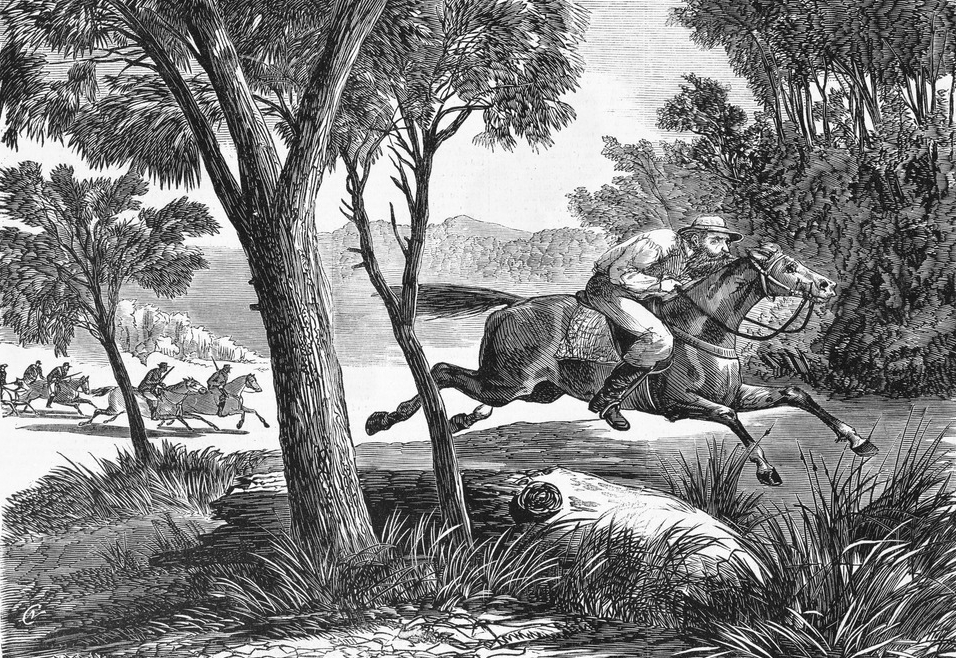
As Daniel ‘Mad Dog’ Morgan continues to cause problems in the district – bailing up travellers, sheep stations and public houses – 40-year-old Superintendent Frederick Alfred Winch at Beechworth sends out all available police in search of the bushranger who is about to be outlawed by an Act of Parliament which gives legal sanction to his execution, without forewarning, by any party.
1865
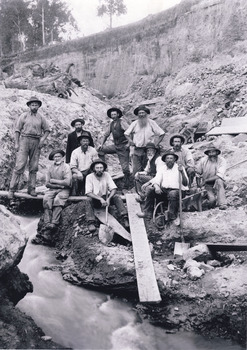
After goldmining had become unproductive and largely abandoned in the area around Three Mile Creek – 3 miles / 4.8 km south of Beechworth – due to lack of water, German-born 31-year-old John Martin Diedrich Pund recognises that it could still be potentially rich, if a better water supply is obtained. So, he and three other miners secure a 15-year license and over the next five years, and set about constructing a 19 km water race, from Upper Nine Mile Creek to Three Mile Creek. By 1881, the Three Mile Mine has delivered 950,000 gallons of water to the Three Mile Sluicing Area resulting, eventually, in large amounts of gold.
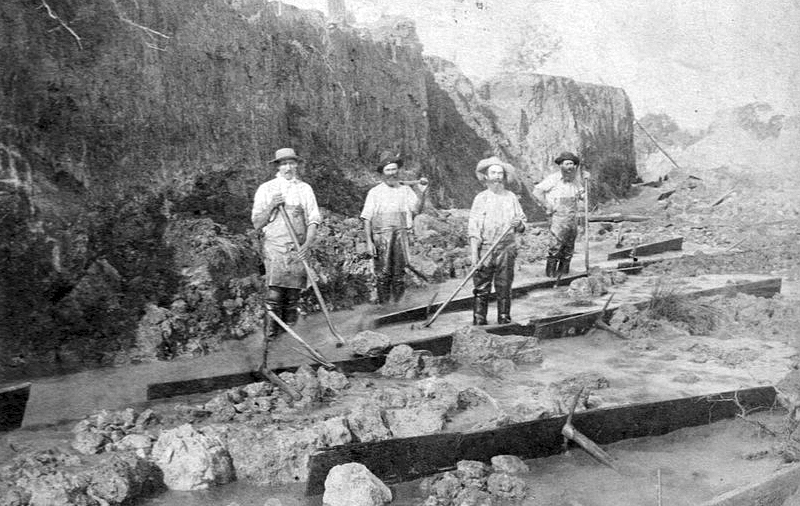

| Pund will later go into partnership with John Alston Wallace, owner of Beechworth’s ‘Star Hotel’. By the early twentieth century ‘Pund & Co’. will be averaging over 1,000 ounces of gold per year from the ‘Three Mile Goldmine’! After John Pund’s death in 1915, ‘GSG Amalgamated Co’ operate the site, and continue sluicing until 1950. Today, the ‘Three Mile Mine’ is called the ‘Baarmutha Mine’. |
1865

Young Richard ‘Dick’ Shelton is nearly swept away in the flooded waters of Hughes Creek at Avenel as he attempts to cross a fallen-tree-footbridge on his way to school. He is rescued by 10-year-old Ned Kelly, who, without hesitation, jumps into the swollen waters fully clothed and paddles young Dick safely to the creek’s bank. The shivering youngsters make their way to the nearby Royal Mail Hotel which is owned by Dick’s parents, Esau and Margaret Shelton. The Sheltons reward Ned with an elaborate 221 cm long, 14cm wide green silk sash, complete with gold bullion fringes at each end. The colour chosen is symbolic of Irish heritage. It is also probable the Sheltons pay Ned’s father Red’s court fine, allowing him to return to his family with an early release from the Avenel lockup where John ‘Red’ Kelly had been charged with stealing a calf from a Mr. Morgan.
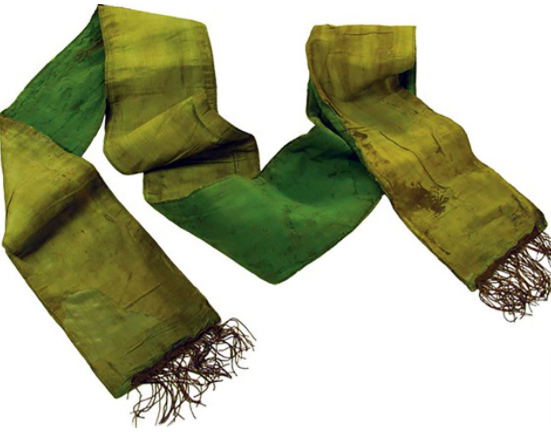
1865 – Apr 9
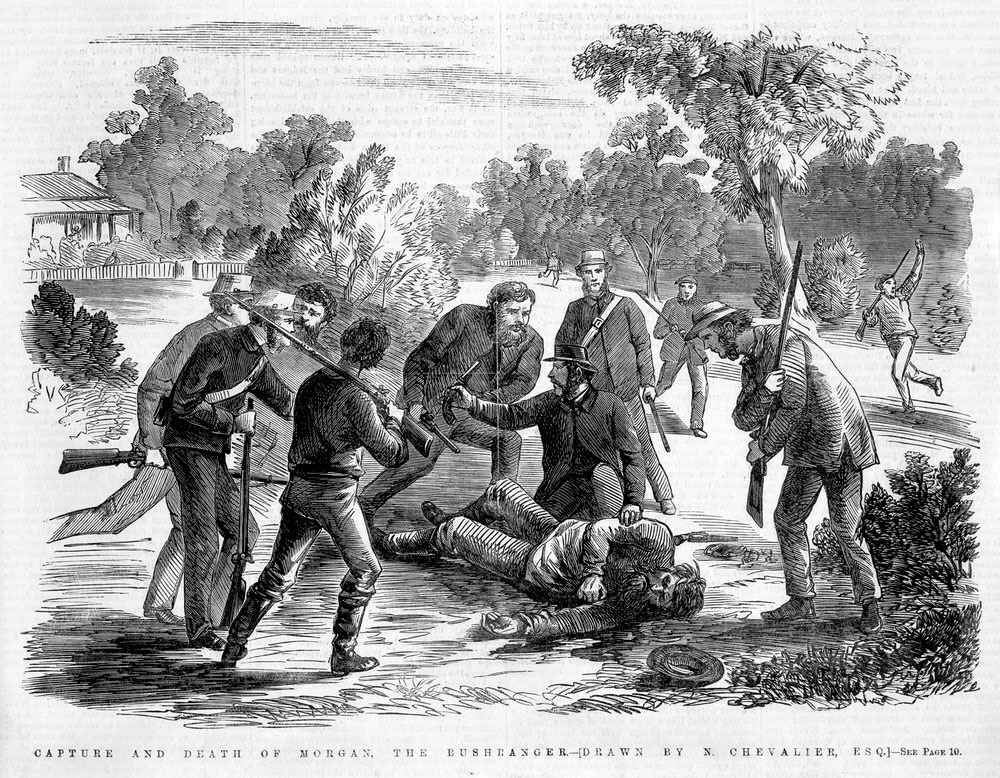
35-year-old bushranger Daniel ‘Mad Dog’ Morgan is shot at Peechelba Station, 28 miles from Beechworth and just 7 miles from the Murray border, which he had been warned not to cross. The night before he had bailed up the McPherson family at the Peechelba homestead. During the evening the McPherson’s maid Alice Macdonald manages to escape and raise the alarm. By the early hours of the morning the house is surrounded by armed men and when Morgan, Ewen MacPherson and his son Gideon emerge from the house, a local stockman John Wendlan fires the fatal shot. Morgan will lie wounded and dying for a number of hours – without any medical assistance – until he succumbs to his injuries at around 2.15pm. As soon as he dies, “several persons commenced cutting locks from his rather profuse head of hair as souvenirs”. While Morgan’s body lies in the woolshed at Peechelba, his body is photographed by two photographers – Mr. Hall of Beechworth and Henry Pohl of Chiltern. Pohl’s most famous image is posed as though Morgan is holding his revolver, with John Wendlan holding a rifle alongside the body (below).
| Daniel Morgan’s body will be put ‘on display’ – for the fascinated public to view – in a cell at the Wangaratta lock up His head will then be removed, wrapped in hessian, and sent to Professor Halford in Melbourne for ‘scientific study’. His remains are then buried at Wangaratta and, at a later inquest into Morgan’s death, no charge is found against John Wendlan, as the incident is declared ‘justifiable homicide’. |
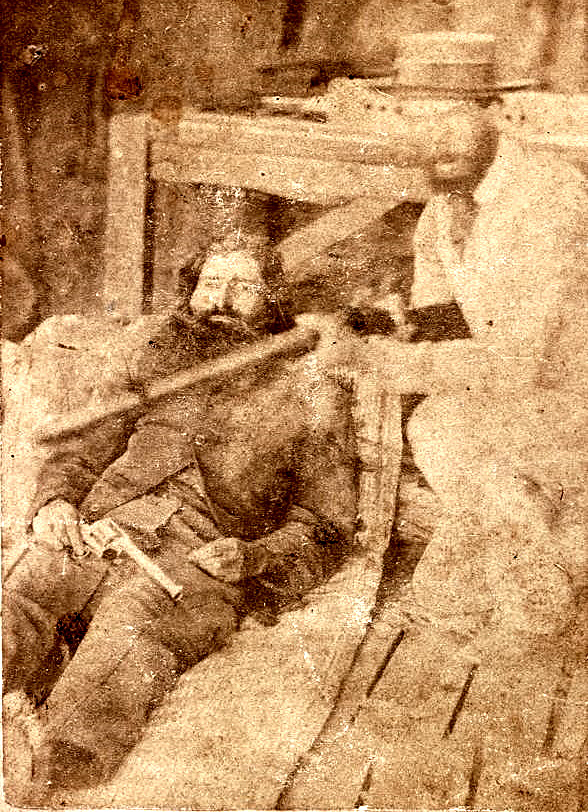
the (posed) dead body of Daniel ‘Mad Dog’ Morgan.

48-year-old George Billson Snr – along with his wife Isabella and their children including 21-year-old George Henry Billson Jnr and 7-year-old son Alfred Arthur ‘Bosher’ Billson – moves to Beechworth from the Wood’s Point District near Mansfield (where he’d been a publican) and takes over George Kerferd’s Ovens Brewery and Malthouse at 4 Last Street. In 1867 he will rename the business Billson’s Ovens Brewery then simply Billson’s Brewery in 1872. The brewery distils ale and porter, a range of cordials, aerated mineral waters, soft-drinks and health tonics. For many years the Brewery also supplies the town of Beechworth with ice.
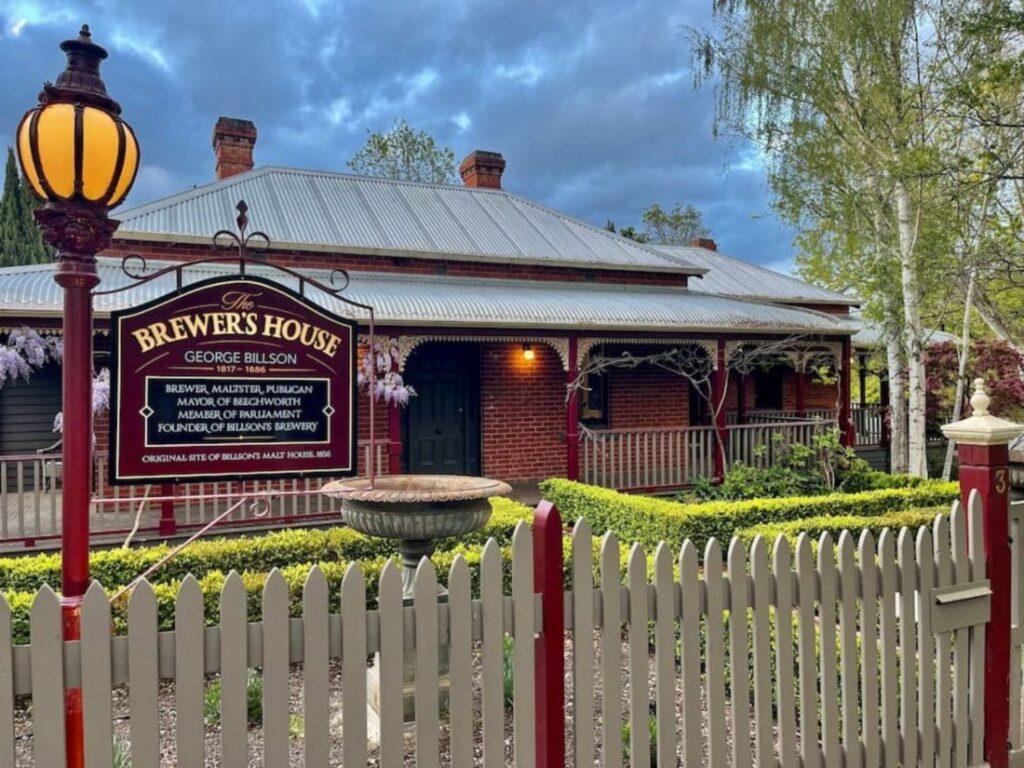
| George Billson also operates a ‘Malt House’ from 3 Finch Street in Beechworth. The original two-storey brick ‘Malt House’ is demolished in the 1880s, replaced by a new stately residence in 1895. Surrounded by beautiful, English-style manicured gardens, and featuring a tinkling fountain and an 80-year-old magnolia tree in the front of the house, it now operates as ‘The Brewer’s House’ luxury accommodation managed by ‘Billson’s Breweries’ (above). |
1865
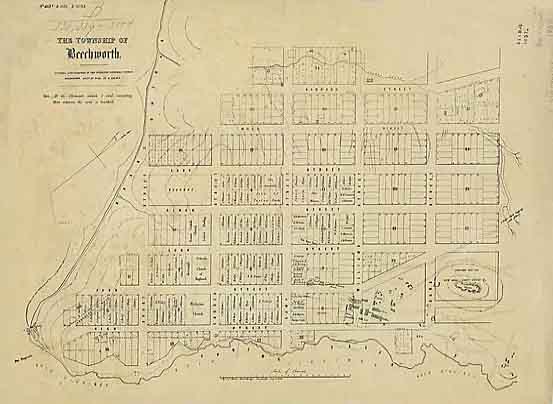
The layout of Beechworth’s newest roads and footpaths is formalised.
1865
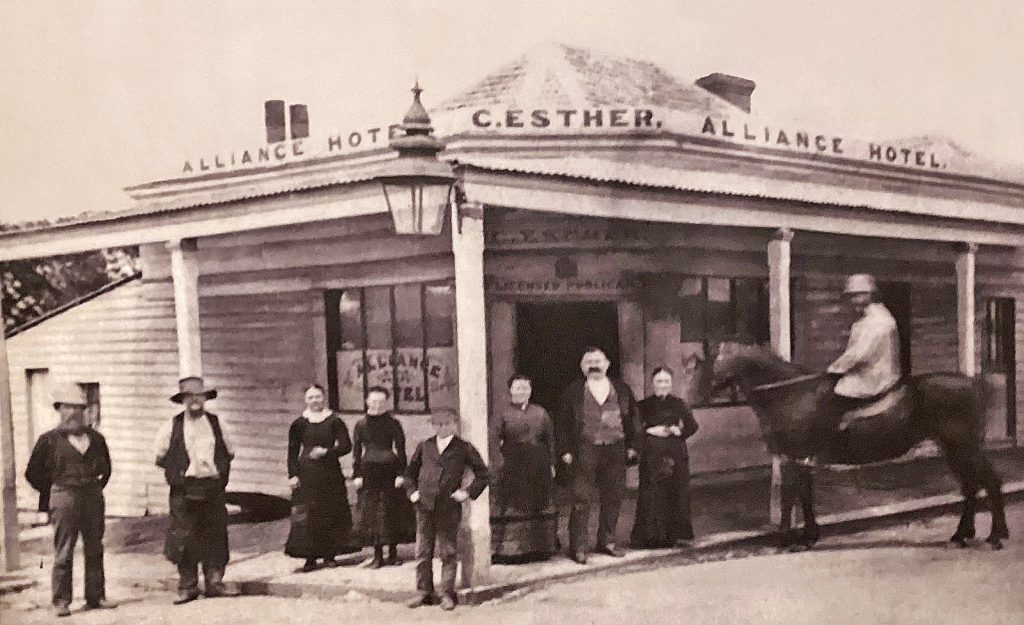
33-year-old German-born Carl Esther, a former publican at Beechworth’s Newtown Hotel, takes over the licence of the 1858-built Alliance Hotel on the corner of Camp and High Streets. The hotel still trades in Beechworth today, at the same location, under the name of the Hotel Nicholas.

| Born in Saxony, Germany, and arriving on the ship ‘Arabian’ in Melbourne in 1855 when he is 23-years-old, Carl Esther is an experienced butcher, which is his original occupation in Beechworth. He will marry Caroline Koch in Beechworth in 1857 and become a naturalised Australian on March 20, 1865. They will have six children together, although two will die in infancy. Esther will be the popular licensee of the ‘Alliance Hotel’ from 1865 until his sudden death at the ‘Alliance Hotel’ on September 1886 aged 54 |
1865

A beautiful home named ‘Du Boulay’ is built at 34 Kars Street for Edward Clarke, a barrister, and his wife Anna Maria B. Young. Situated on over 4 acres of land, the solid granite Victorian house features a 250-year-old French spiral staircase (below). In one of his more unusual cases, Clarke successfully defends Mrs Mary King for “larceny of a candlestick”. His argument is that “a woman cannot be convicted of larceny while in the company of her husband”!
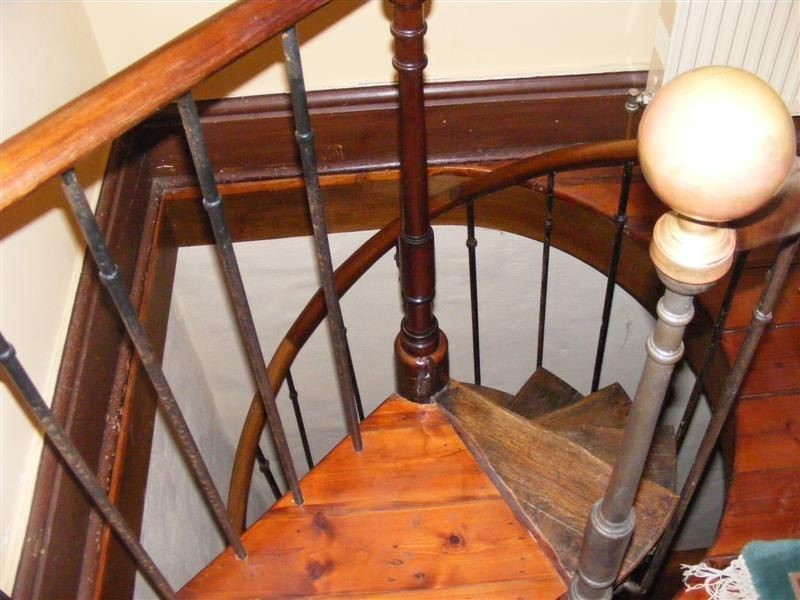
| ‘Du Boulay’ means “a person who lives by a grove of birch trees”. Kars Street is named for the ‘Siege of Kars’ that took place in June 1855, the last major operation of the Crimean War. |
1865 – Jun
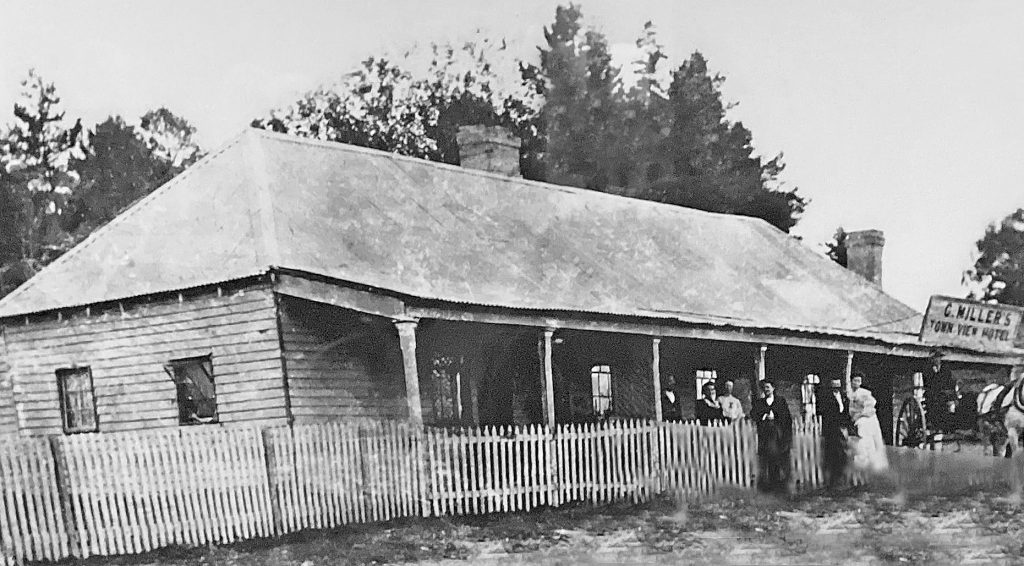
Walter Barnett – a popular butcher at the Three Mile diggings – opens the Butcher’s Arms Hotel on the corner of Albert Road and Stanley Road (now Hodge Street). It is much needed on the ‘further side of Spring Creek’ as The Royal Oak Hotel had been destroyed by fire some months earlier. In November 1895 the Butcher’s Arms Hotel will be renamed the Town View Hotel (above) by Beechworth-born Elizabeth Collier, the licensee at the time, and will continue to trade until March 12, 1916 when it finally closes. The weatherboard building will sit empty and abandoned for many years until being destroyed by fire in the 1960s.
1865
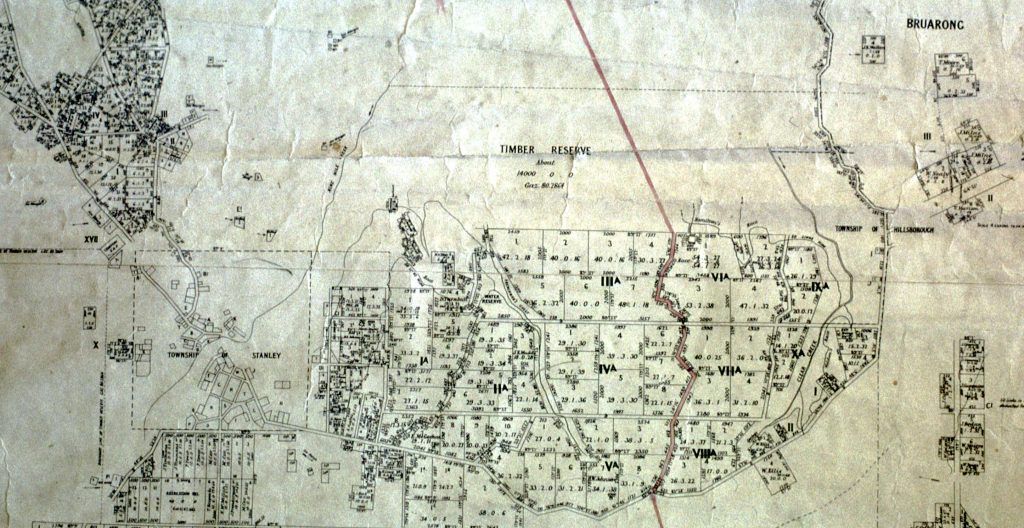
Brothers Arthur and Archibald Clingin discover and work the ‘Bon Accord’ and ‘Homeward Bound’ gold reefs at Hillsborough, 12 miles south of Yackandandah. A small mining settlement begins at the valuable reefs, sitting on an escarpment overlooking Bruarong in the valley, not far north of Mount Stanley. As the settlement grows, Peter Develin establishes the Reefers’ Arms Hotel with a “Spacious Ballroom” and, in October 1867, local citizens led by John Brown raise funds for a school. The Hillsborough School Committee purchase an old hotel (the ‘New Era’ owned by a Mrs Kennedy) and move it to the settlement. Sadly, the town of Hillsborough has been deserted since the early 1920s and apart from empty mining shafts, virtually nothing remains (below). While Arthur Clingin stays in the area and dies in 1897 at the age of 52, Archibald Clingin will move to Twists Creek, then to Burwood in Melbourne, where he dies in 1934 at the grand old age of 92.

The town was about in the centre of this picture (photo: Don Ingram)
1865
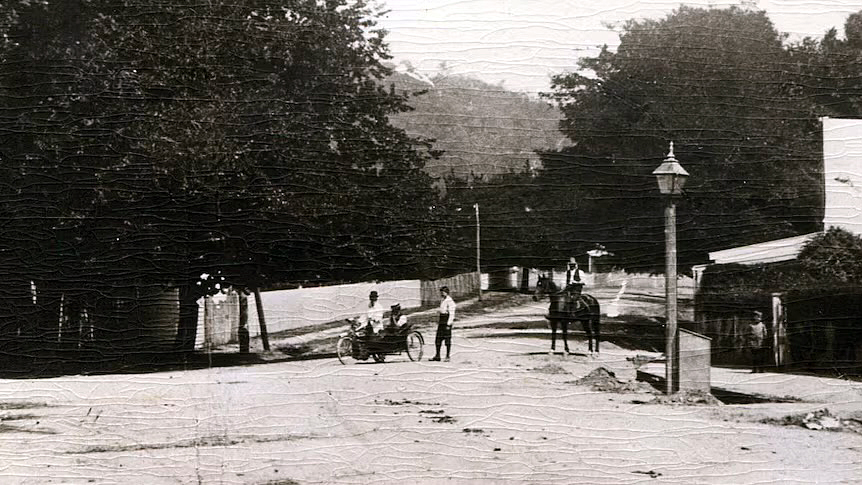
10km from Beechworth, the thriving township of Stanley is now home to around 5,000 people and 900 dwellings. It features a large number of businesses and services with a variety of stores including butchers, bakers, a furniture maker, a dressmaker, a chemist, blacksmiths and a medical practitioner, along with numerous hotels including the Star Hotel, the Rising Sun, the Golden Age, the Full Moon, the Vine, the Royal Oak, and the wonderfully named Live and Let Live Hotel. It also supports two of its own newspapers – ‘The Stanley Times’ and ‘The Mining Journal’.
1865
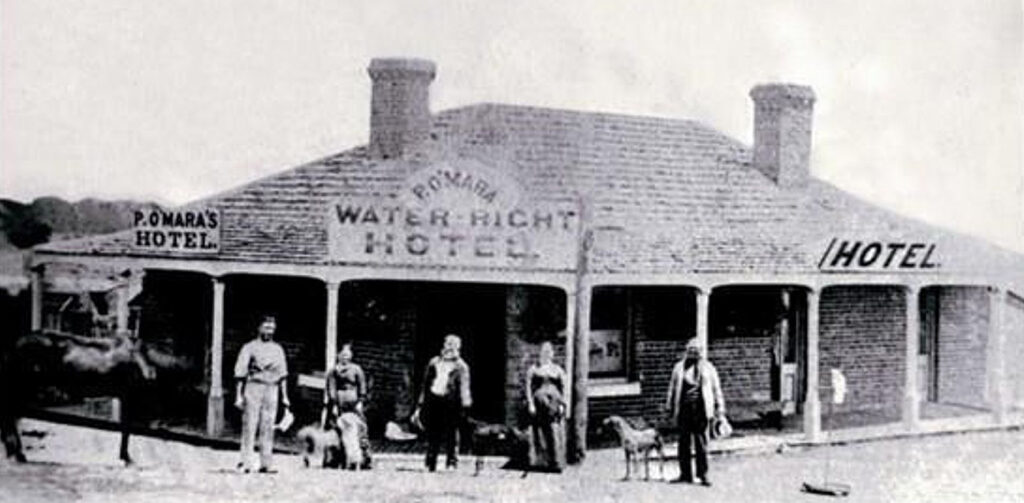
The ‘Water Right Hotel’ is established at 42 Mellish Street, on the corner of Mellish Street and the Buckland Gap Road. It still stands today as a private home (below).
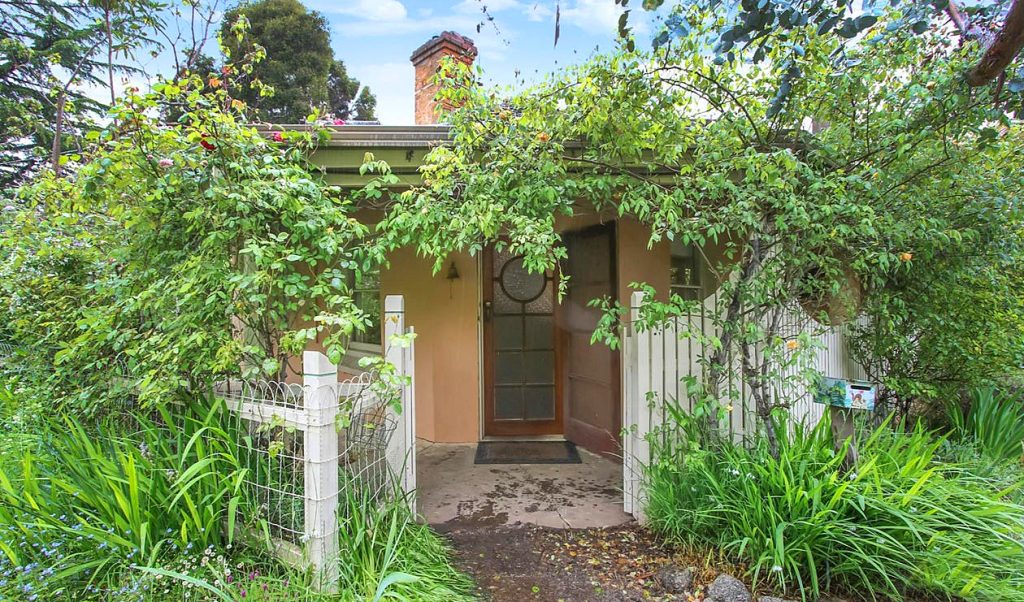

1865 – Nov 6
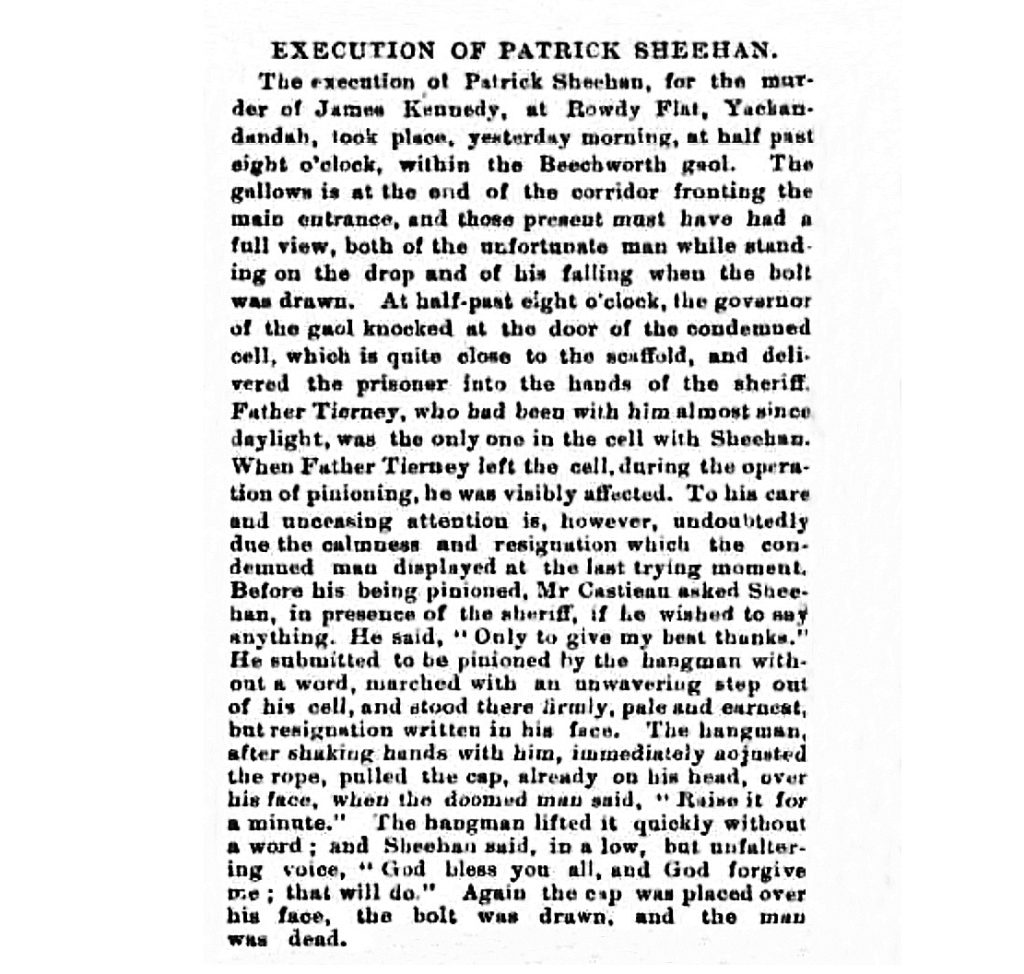
For the first time, gallows are erected at the Beechworth Gaol and a crowd gathers to watch as Patrick Sheehan is hanged for the murder of James Kennedy, a publican from nearby Rowdy Flat at Yackandandah. Sheehan claims not to remember the violent stabbing incident due to drunkenness but seems resigned to his fate as he is is hanged at 8.30am with his last words being “God bless you all and God forgive me. That will do”.
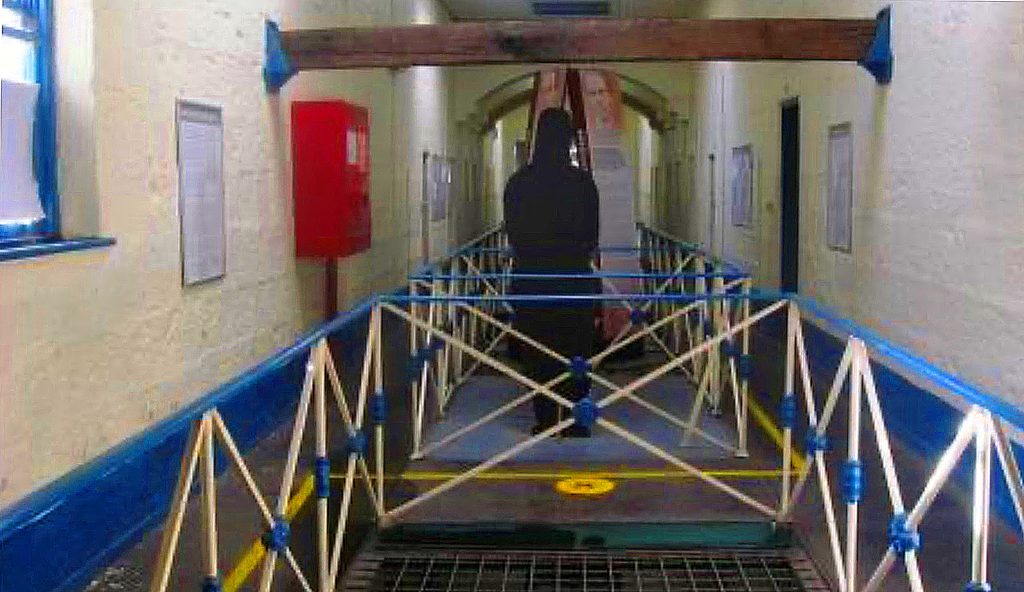
| While Sheehan is the first man executed at Beechworth, a further seven men will be hanged within the imposing walls of Beechworth Gaol between 1865 and 1881. |
1865 – Nov 9
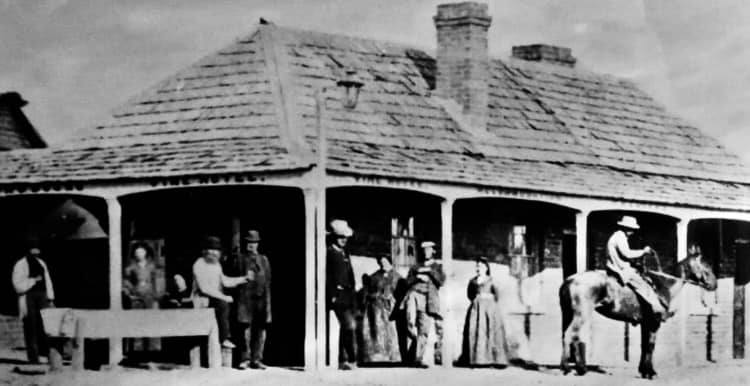
A tornado tears through Beechworth, damaging buildings and uprooting trees – including one that falls onto the verandah of the popular Vine Hotel on the corner of Balaclava Road and Sydney Road towards the Woolshed diggings. The Vine Hotel, established in 1858, is run by Jacob and Christina Vandenberg (or Van Den Berg), prominent members of the community.
1865 – Nov 29
Disaster strikes the Vine Hotel near the Woolshed diggings – again! This time it is destroyed by fire, but is quickly rebuilt by the Vandenbergs.
| On June 24 1880, Joe Byrne – a member of the Kelly gang – rides to the ‘Vine Hotel’ to be with his sweetheart Maggie for the final time. Maggie is a general maid at the hotel which is far enough outside of the Beechworth town centre that Joe can access it with little risk of being spotted. On this night Maggie informs Joe that his best friend Aaron Sherritt has been at ‘The Vine’ with a policeman who has interrogated her. Three days later Joe kills Aaron … and the next day Joe himself will be killed at the Glenrowan siege. An inquest on the body of Aaron Sherritt is held at ‘The Vine’. |
1865 – Nov 30
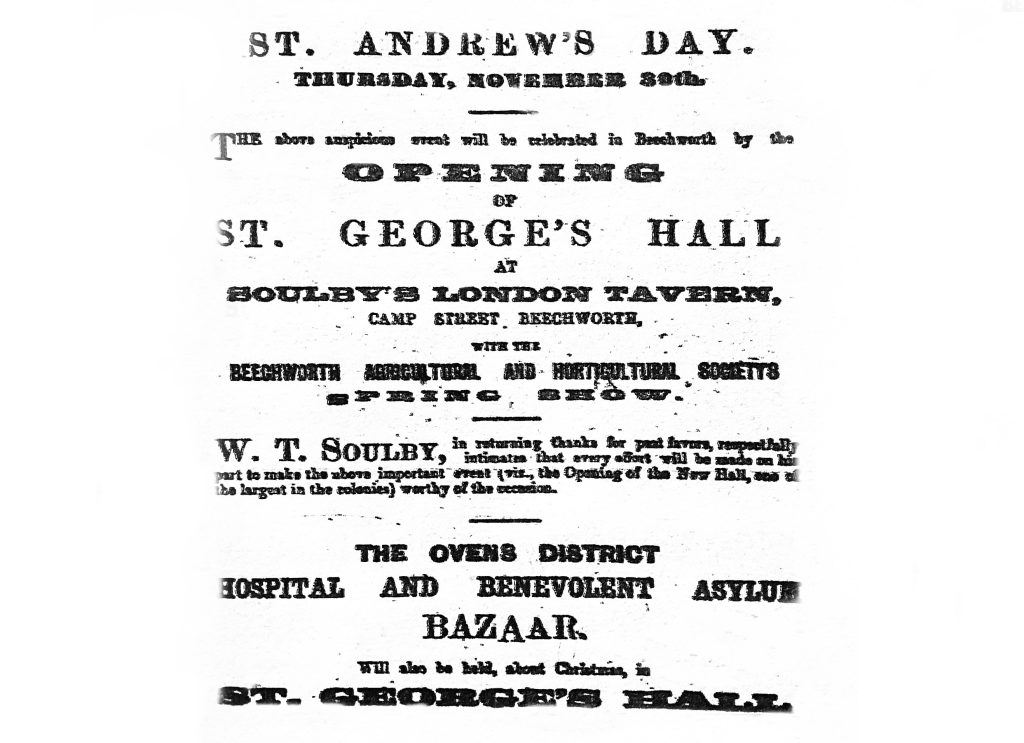
William Thompson Soulby officially opens St. George’s Hall – “the biggest room in the Ovens District”. Standing just around the corner from Soulby’s London Tavern on Camp Street, the large 60 ft by 40 ft wooden building fronts onto Finch Street and features a vast shingle roof – giving it the appearance of a ‘tent-like’ structure (below) – and has room for 250 people. The first (combined) event held in the hall is the ‘Beechworth Agricultural and Horticultural Show‘ and a ‘Bazaar’ to raise funds for The Ovens District Hospital and Benevolent Asylum. Until it closes in the late 1880s St. George’s Hall will be an integral part of the entertainment and social life of Beechworth, hosting theatrical performances and general entertainments of the day including Grand Balls and Dances.

| Soulby’s ‘St. George’s Hall’ is no doubt inspired by Melbourne’s ‘St George’s Hall’, opened on Bourke Street in December 1862 next door to the ‘Theatre Royal’. Briefly renamed Weston’s Opera House in 1869, by the late-1870s the hall is regarded as Melbourne’s “Home of Minstrelsy.” Hoyts exhibit films at the venue from 1909 until late-1914 before it is demolished to make way for the company’s De Luxe cinema (which opens on 26 March 1915). |
1865 – Dec 4

The National School is renamed Common School No. 36 and moves into a new red brick building that has been erected at 17 Loch Street. The majority of children in Beechworth will receive their schooling here between 1865 and 1875. After these 10 years, Common School No. 36 has outgrown the building and part of the ‘Botanical Reserve’ is selected for a new school, which will be built in 1875.
| The school building at 17 Loch Street is designed in 1865 by Thomas Dalziel. When the ‘Common School’ moves, the building will be taken over by James Goldsworthy’s ‘Beechworth Grammar School’, and later become the office of the ‘Ovens and Murray Advertiser’ newspaper. It is now a private home. |
1865 – Dec 27
After beginning as the ‘Municipal District of Beechworth’ on 23 August 1856, then becoming a ‘Borough’ on 11 September 1863, Beechworth now becomes the ‘Shire of Beechworth’, as a union of the Stanley and Wooragee Road Districts.
1866
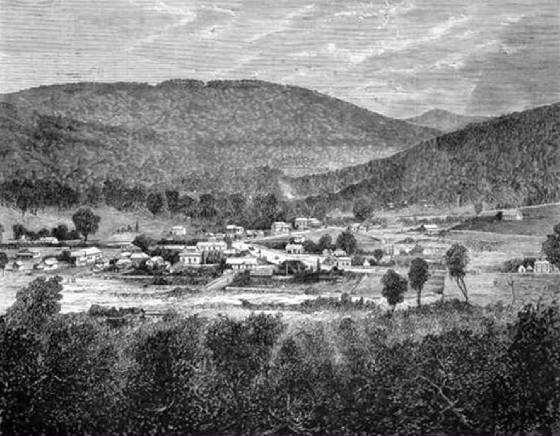
47km from Beechworth, the swelling gold-mining settlement at Morse’s Creek (at the junction of Morse’s Creek and the Ovens River) is renamed Bright after the British liberal politician John Bright, and the town’s role as an administrative centre grows. Shops, hotels, banks, schools and a horse racing track near Racecourse Road are established and newly surveyed streets are named after politicians and lawyers of the time.
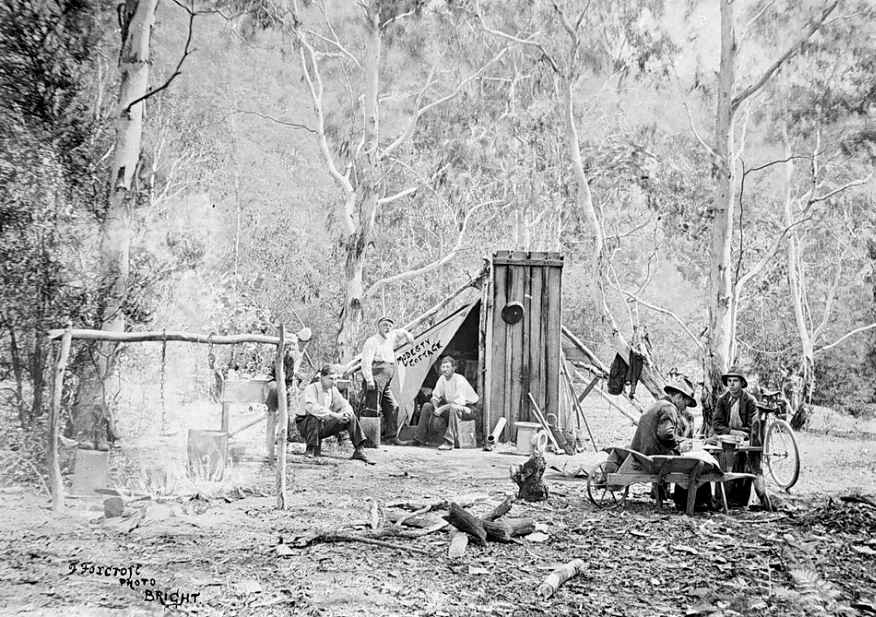
1866 – Feb 12
The district’s first ‘sparkling wine’, made in Beechworth by P.D. Murphy, becomes available. The wine has been ‘carbonated’ with assistance from Edward Samuel Russom, the soda water manufacturer.
1866

Another school for Beechworth. W.H. Neuber – son of the late William Henry Neuber who established Beechworth’s first hotel in 1853 – opens the Ovens and Murray District Grammar School on Havelock Road with student numbers limited to 25.
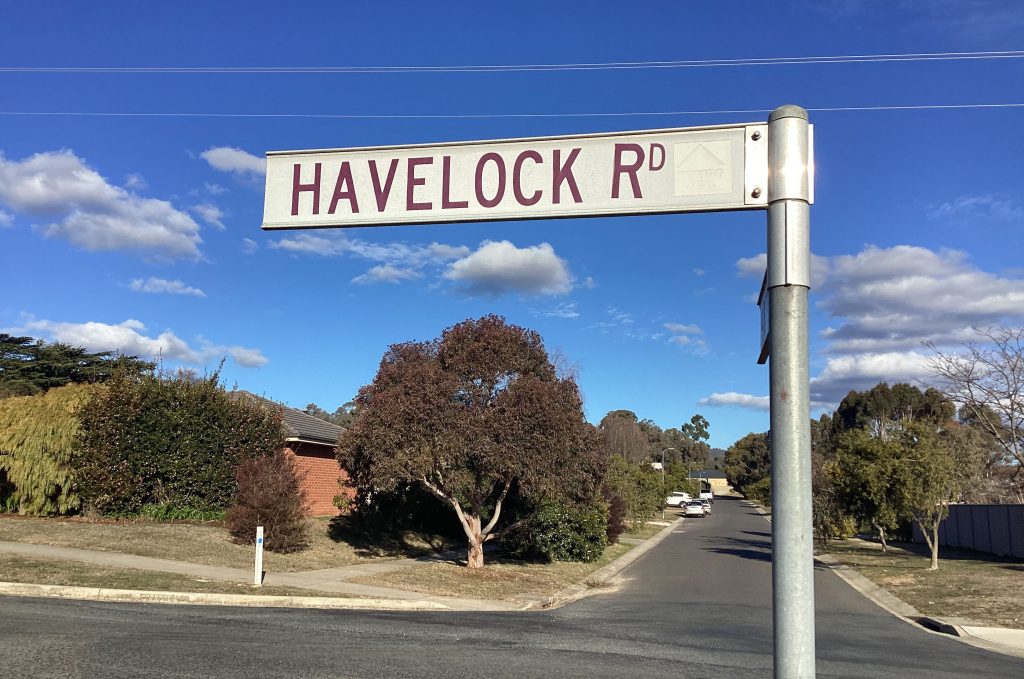
| Havelock Road is named in honour of Sir Henry Havelock, the British army general who spent most of his distinguished career in India where he died of dysentery in November 18657. There is a statue Havelock in Trafalgar Square in London. |
1866
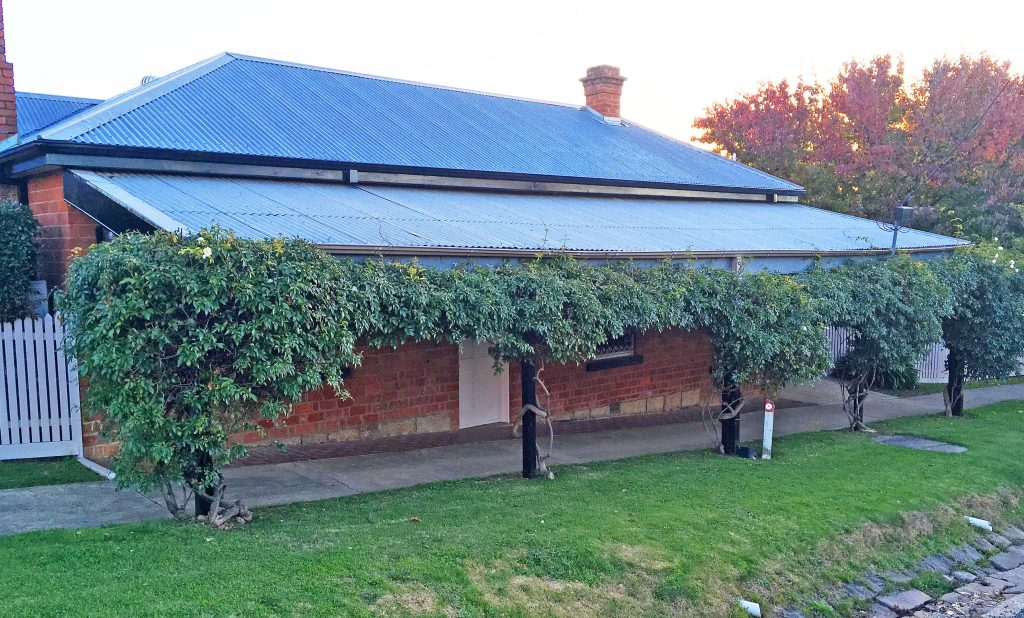
William Trim arrives in Beechworth to join his brother Edward Trim at his recently established Oven’s Bakery on Albert Road. The Trim brothers introduce Beechworth’s first “steam baking apparatus”, before Edward Trim decides to return to England, and William takes over the bakery. William is married to Margaret Trim (née Hulme) who is active with numerous Beechworth charities and will become vice-president of the Beechworth Ladies’ Benevolent Society.

| In recognition of her services for local charities, Margaret is awarded Life Governorship of both the ‘Ovens District Hospital’ and ‘Ovens Benevolent Asylum’. William Trim is a councillor of the ‘United Shire of Beechworth’ from 1896 to 1905 and President from 1902 to 1903. Margaret and William have six sons and three daughters. Margaret dies in Beechworth in 1908, aged 66 and William dies in Beechworth in 1909, aged 74. |
1866
33-year-old John Clements Snr establishes a store in High Street and over the next 18 years will expand his range of goods to food, clothing and building materials.
| Clements arrived in Australia from Devon in 1854 and spent the next 11 years mining at the Spring Creek and Pennyweight Flats sites before deciding to give mining away in favour of running a business in Beechworth. |
1866

On a large property at 1602 Diffey Road – 2 kms from the centre of Beechworth – a small farmhouse is built, with an adjoining cottage added a few years later. It still stands today.

1866

In the 14 years between the first gold discovery in Beechworth in 1852 and 1866, approximately 4 million ounces (115 tonnes) of gold have been extracted from the Beechworth area. At the current price of gold (approximately AU $2,000.00 per ounce), this means that around $6 billion worth of gold is extracted during these 14 years!
1866 – Jun
There are now 725 European alluvial miners, and 936 Chinese miners in the Beechworth district. The Chinese predominate at Woolshed, Spring Creek, and Three-Mile Creek. Magpie Creek (Wooragee) is now exclusively Chinese, with many of them getting 30 or 40 oz per week from their claims. The reefs at Magpie Creek are actually all one reef – a continuation of Homeward Bound on the Twist’s Creek side of the range.
1866

A beautiful and ornate brick house is built at 6 Church Street. It is now known as Hedge House after the large hedge added in the 1930s that surrounds the property.
1866 – May 11

The first Beechworth Dramatic Society is founded. Rehearsals soon begin for their first production – Thomas Morton and John Maddison Morton’s 1851 comic drama “All That Glitters is Not Gold” featuring Mr J.J.B. Bowman in the role of Sir Arthur Lassell followed, after interval, by the 1889 one-act farce “Ici on Parle Français, or Lodgings to Let” by Thomas John Williams. It is staged at the Star Theatre in Beechworth on Thursday June 28th. The Beechworth Amateur Band, under the leadership of Herr Schmidt, give their services on the occasion and all funds raised are donated to the Ovens District Hospital.
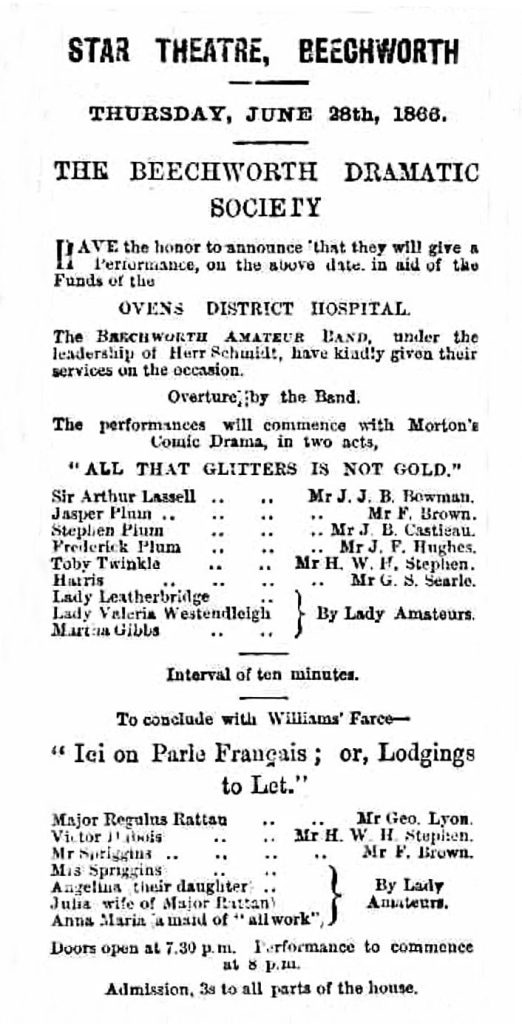
1866 – May 30
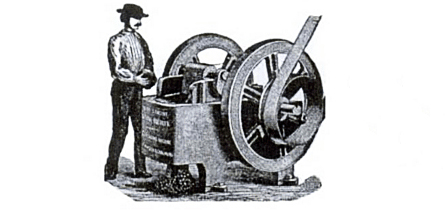
The district’s first cement works are established on the Woolshed. The Pioneer Cement Crushing Mill features steam-driven crushing and stamping machinery designed and manufactured by Alexander Rodgers at his New Ford Street Foundry in Beechworth.
1866

Joseph Piercy Dalton establishes Dalton’s Bakery Shop in a new brick building at 29 Finch Street, then builds a residence next door for his wife Ann Garratt and their children. ‘Oban House’ still stands today (below). Sadly, the Daltons will lose five of their eight children between 1859 and 1875 – 1-year-old Annie, 8-month-old Ebenezer, 3-day-old John, 4-month-old Fanny and 13-year-old Florence, all buried at the Beechworth Cemetery. Their other three children – Herbert, Walter and Sarah Dalton – survive.

| Born in Banwell in Leicestershire, Joseph Piercy Dalton and his wife Ann arrive in Melbourne in 1854 before proceeding to Beechworth where Joseph enters the baking business in Finch Street, running ‘Dalton’s Bakery’ for over 40 years. He is an active and consistent adherent of the Methodist Church and is one of its original Beechworth members, and the last of the original trustees. He is superintendent of the Sunday school and leader of the Methodist Church Choir for 20 years. He will pass away in January 1909 at the advanced age of age 84. |
1866
Beechworth Council construct a lodge at the ‘Botanical Reserve’ to a design prepared by the borough surveyor. It is erected midway between the carriage entrance and the corner of Kars Street and Sydney Road, one chain back from the front fence. The following year, tenders are called for a well and pump, earth closet and fence for the new lodge. The well is found to be too deep for a lift pump so Council opts for a windlass, rope and bucket with a lockable cover for safety. In 1868 tenders will be called for a person to occupy the lodge in return for one day’s work a week, tending the gardens and keeping the grass “at a reasonable length”.
1866

After an ocean trip on the ‘Red Jacket’ from Ireland to Melbourne, 20-year-old Eliza Mercer and her older brother travel to Beechworth to reunite with their uncle who is a policeman in the town. On the way from Melbourne their carriage is held up by a ‘highwayman’! In February 1871 Eliza marries Henry Williams Gaylard – the manager of Fletcher’s Gold Mine – and they build a home at Allotment 2, Mellish Street in Newtown and have eight children together. When she is 44 years old Eliza Gaylard is one of the 170 women from the Beechworth district to sign the ‘Great Petition of 1891’ supporting the female suffrage campaign in Victoria. She will pass away aged 78 in 1925 and be buried in the Gaylard family grave in the Methodist section of the Beechworth Cemetery.
1866
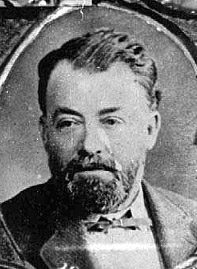
American George Judah Lyon leaves The Ovens and Murray Advertiser to commence his own business as a newsagent and tobacconist at 74 Ford Street, responsible for obtaining the agency for The Argus, which is a very lucrative business.
1866
Although mostly abandoned in 1863, the Spring Creek reefs (including Madman’s Gully and the Canadian Reef) gain new attention when some small discoveries are made by dedicated miners.
1866

After selling his Prince of Wales Photographic Gallery in George Street, Sydney in 1865, 34-year-old photographer James Edward Bray is commissioned to produce six views of the town of Rutherglen to be displayed at the upcoming Intercolonial Exhibition of 1866-67 in Melbourne. After completing his assignment, he tours the area and likes Beechworth so much he decides to stay and establish a photographic portrait business on Camp Street. He will successfully run the business with his wife Elizabeth for 25 years, until his death in 1891.
1866 – Oct 24 to 1867 – Feb 23
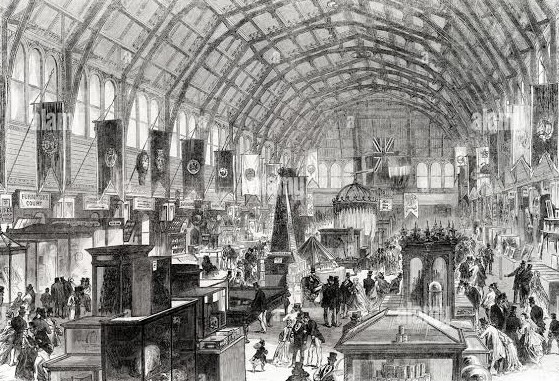
The first Intercolonial Exhibition is held in Melbourne. In the final awards ceremony, ‘honourable mentions’ are given to two Beechworth wines – an 1863 ‘Hermitage’ and an 1864 ‘Chasselas’.
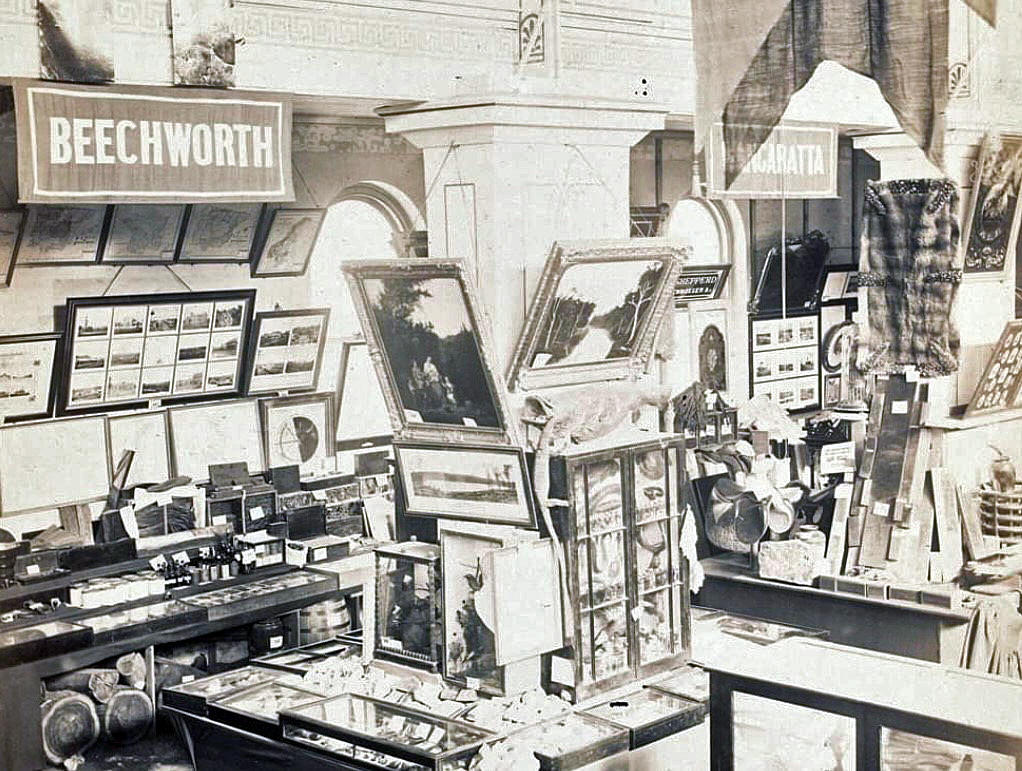
| For the first time, the Australian colonies are brought together for this exhibition to assist in the selection of items to be forwarded to Paris for the ‘Exposition Universelle’. There are exhibits from Victoria, New South Wales, Queensland, South Australia, Tasmania, Western Australia and New Zealand, as well as from New Caledonia, Mauritius and the Netherlands-India. Each colony is assigned a specific area, or ‘court’ for their display. Victoria’s includes separate courts for the Sandhurst (Bendigo), Ovens & Murray, and Wangaratta and Beechworth districts. |
1867 – Feb
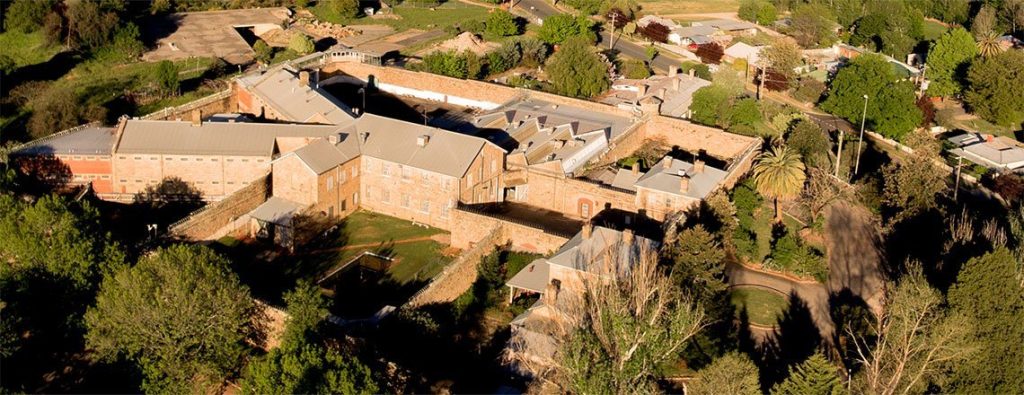
The Governor of Beechworth Gaol agrees to have the prisoners make rustic seats for the ‘Botanical Reserve’ out of saplings and materials in the garden itself, and the Council provide nails and oil for the paint. Several “ornamental rustic garden seats are placed in the Gardens” in June.
1867
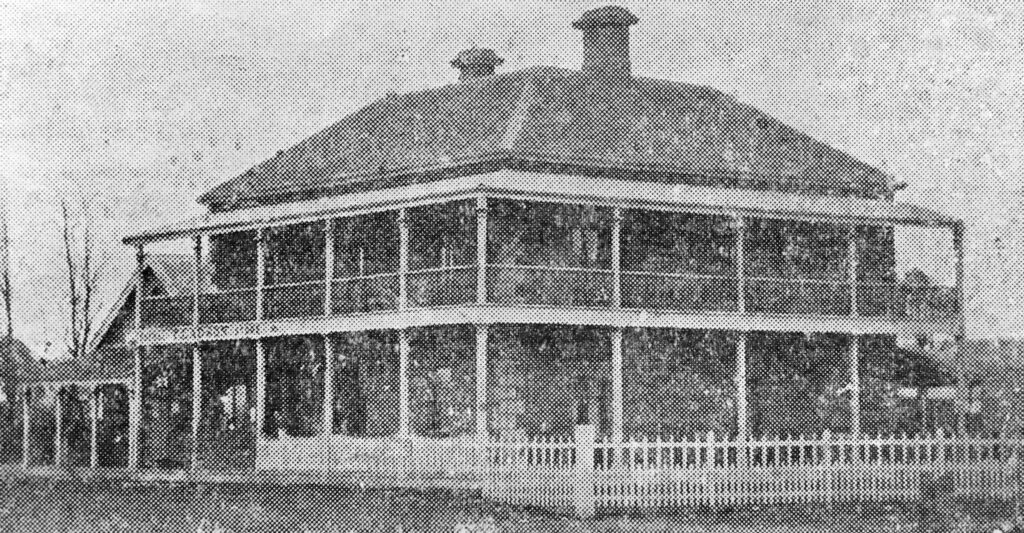
After building began in 1861, construction is finally completed on a grand two-storey Georgian brick residenceat Tarrawingee, on the main road between Beechworth and Wangaratta. Featuring a ballroom and a large underground cellar, it is built by Thomas Shiels and Jack Oliver for former Beechworth jeweller and businessman 35-year-old Thomas Taylor Ladson and his wife Mary who have been operating the Tarrawingee Post Office since 1858. The balustrade of the balcony of the Ladson’s grand home features decorative ironwork with a swag-bellied profile, a detail unusual in Victoria. The building has single-paned sashes and French doors at the front and multi-paned sash windows at the rear. The home initially incorporates the Tarrawingee Post Office and, shortly after, a new single-story building will be added, adjoining the grand residence, to operate as the Post Office and ‘Ladson’s General Store’ (below), along with a Public Hall. Thomas Taylor Ladson is the older brother of popular Beechworth storekeeper Alfred William Ladson.
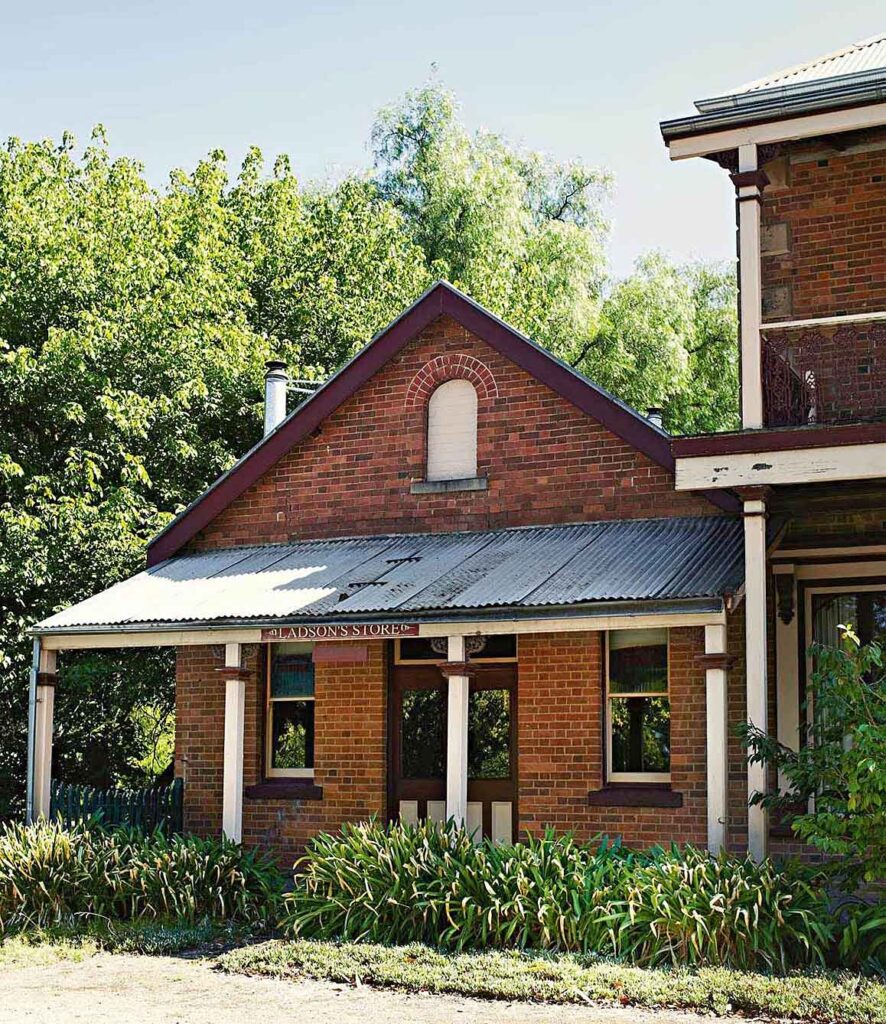
| “Ladson’s Folly” – The buildings will become known as Ladson’s Folly after the much-anticipated new railway line (and station) between Beechworth and Wangaratta bypasses the centre of Tarrawingee and therefore the expected ‘business boom’ does not eventuate. The coming of the railway to the area in 1875-1876 is the main reason Ladson had added the adjoining gabled single-storey brick building for the store! (above) As the road traffic diminishes, his ‘Tarrawingee General Store’ fails and Ladson sells the building to Hopton Nolan, whose family live in it and continue to operate the Post Office from the premises. Nolan will rename the grand house ‘Carinya’. |
1867

Mark Straughair and Scotsman John Laidley Duncan amalgamate their separate businesses, form a partnership, and take over Alexander Rodger’s thriving business, the New Ford Street Foundry on the steep New Town Hill at the entrance to Beechworth. Straughair and Duncan rename it the Beechworth Foundry and grow the business rapidly, adding a Blacksmith and Farrier Engineering building next door. By the late 1860s Straughair and Duncan employ 16 workers, manufacturing all manner of items, including tools and machinery for the mining and agricultural industries.


| In the 1870s John Laidley Duncan becomes a Beechworth Councillor. Duncan Lane is later named in his honour. John and his wife Anne have 12 children. One of them, John Duncan Jnr, kills himself at the ‘Star Hotel’ in 1900 by opening an artery and bleeding to death. |

| Mark Straughair dies in 1882 at the age of 51 and John Laidley Duncan dies at the start of 1896 aged 65. Duncan’s death brings about the immediate business collapse of the ‘Beechworth Foundry’. However, the foundry will be reopened in 1905 by William Henry Phillips (President of the ‘Beechworth Trades’ Cricket Association’) and taken over by H. Delora in 1906 (above). |
1867
30 km from Beechworth, the population of Eldorado has reached 2,000. The more permanent form of mining in the town – with workers on regular wages – has led to the growth and development of a larger township, which now hosts three newspapers, sixteen hotels (some with theatres), a Post Office, Courthouse, a larger range of shops, as well as numerous permanent dwellings that now occupy the undulating land stretching back to the foothills from Reedy Creek. The Eldorado Company – a co-operative which later re-forms as the Second McEvoy Gold Mining Company – sinks a shaft in 1867 which produces large yields (until it is abandoned in 1871). New, equally lucrative shafts are also being excavated, one of which is 240 feet deep and runs beneath the creek and under the township.
1867 – Mar 23

The ‘Great Beechworth Fire’ – Just after 11.00pm on this Saturday night, a fire breaks out in the stables of William Newsom’s Empire Hotel at 24 Camp Street (where the Beechworth Emporium currently stands) and quickly spreads and sweeps along Camp Street, destroying every building on one side of the street including Ingram’s Book & Stationary Store, Dunn’s Tailor Shop, Martin’s Solicitors, the Chinese Store and Young’s Boot Store, as well as badly damaging the Post Office (only the walls and clock tower remain – the clock still working!) and the Bank of Victoria on the opposite corner of Ford and Camp Streets. The fire bell rings out at 11.15pm but locals are unable to help fight the fire as there is a blockage in the town water supply. As the Post Office clock strikes midnight it is surrounded by a sea of flames. A total of seven buildings are destroyed, and four are severely damaged. Most of the buildings destroyed are made of wood, canvas and bark, while buildings of brick and granite offer more resistance. Miraculously, there is no loss of human life, although a horse is consumed by the flames in the stables of the Empire Hotel, which is also burnt to the ground.
| The ‘Empire’ will be rebuilt a few doors further along Camp Street but destroyed again by a fire on March 3rd 1879, before being rebuilt for a third time! The ‘Empire’ had previously been known as both the ‘Post Office Hotel’ and the ‘Central Hotel’. |
1867

After the fire, James Ingram rebuilds his “Newsagency and Booksellers” in the same spot.
1867 – May 4

Beechworth’s second execution. John Kelly (no relation to Ned Kelly) becomes the second man to be hanged at the Beechworth Gaol. He is the only man executed in Beechworth for a crime other than murder, after he is found guilty of ‘an unnatural offence on a male child only some two years of age’ … “So revolting was the evidence that it excited intense disgust”. Witnessed by around sixty people, the hangman is James Gould (a convicted thief) after William Bamford, the ‘official hangman’, fails to arrive from Melbourne.
| James Gould is described by one newspaper as “an unmitigated nuisance.” A thief and drunkard, he “plagues the townships of Yackandandah and Beechworth with his rum-soaked presence”. After volunteering for the job as ‘fill-in hangman’ at Beechworth Gaol, he receives ‘indulgences’ for completing the task. Some years later, when Gould is ‘drying out’ in a cell at Yackandandah, Francis Neville is put in with him. Neville had been a great friend of John Kelly who Gould had hanged in 1867 and proceeds to give Gould a beating he will never forget. |
| The “Official Hangman”. Born in England in 1800, William Bamford will hold the role of Victoria’s official ‘Hangman’ and ‘Flagellator’ from 1857 to 1873, and over those 16 years he will execute 71 convicted prisoners. Losing an eye in an accident in his younger days, he will carry out all the floggings and hangings in Victoria – with the two exceptions at Beechworth in 1867 and 1869. Bamford likes to keeps a count of his executions, and mutters the number he has hanged after each prisoner drops at the gallows. He will die of natural causes in September 1873 at the age of 73. |
1867 – May 11
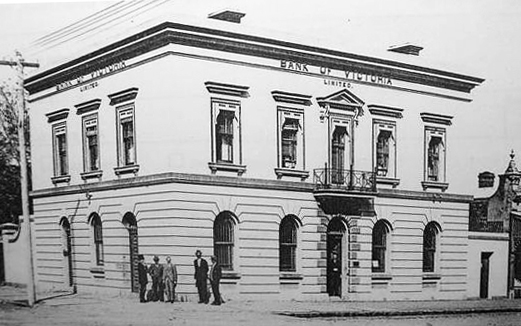
The foundations are laid for the the new Bank of Victoria building after the previous building – badly damaged in the March 23rd fire – is demolished. The grand new structure rises from the ashes on the corner of the Ford and Camp Streets roundabout. Architects Arthur Ebden Johnson and Alfred Louis Smith design the new two-storey brick structure with a five-bay composition. The ground floor is ruled and has arched openings and the first-floor windows feature architraves and hoods. Designed in a classical tradition, rejecting its prominent corner position to take a palazzo form, emphasising the principal entrance by richer decoration on the door opening and on the corresponding window and small balcony above. Both the Bank building and Ingram’s Newsagency still stand today.
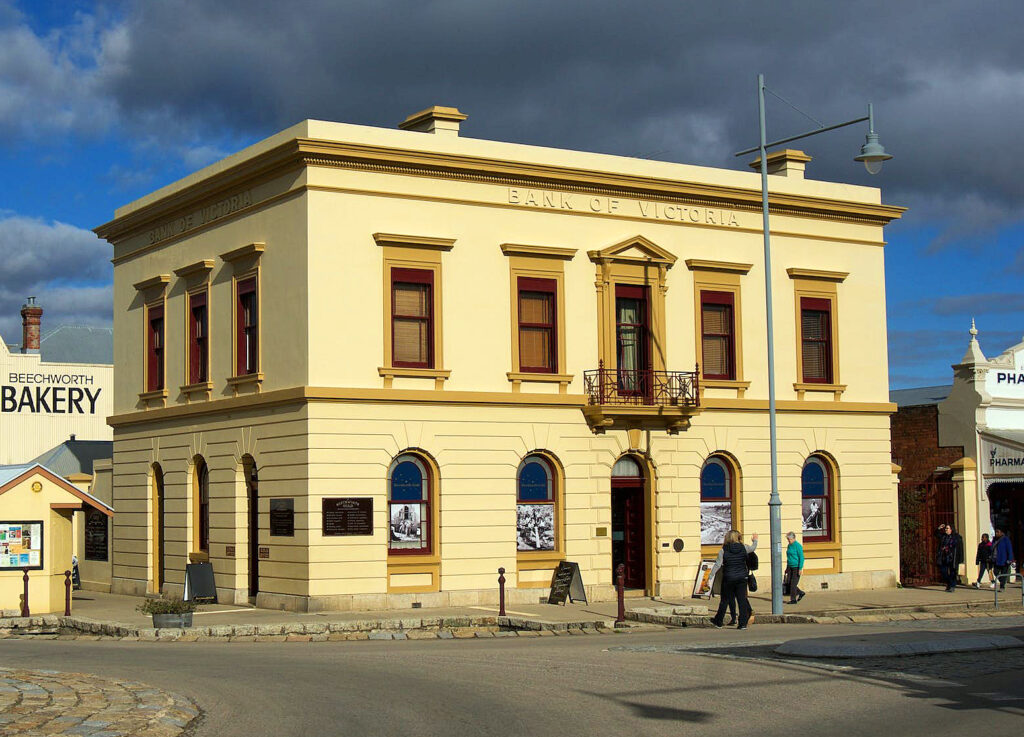
| The ‘Bank of Victoria’ building now houses ‘Beechworth Gold’, a gold and gemstone gallery and shop. The building retains its arched windows on the ground floor and a small cast-iron balcony above the main entrance. Inside stands the original gold vault, used when the building was a gold office. Another feature that remains is the 24-light chandelier with over 4,000 crystals. The original toilet blocks, servants’ quarters and balcony have been restored and a Victorian-style fountain with a fine stone pool is set within the garden area, overseen by wrought-iron gates. |
1867 – Jul

37-year-old William Thompson Soulby, owner of the London Tavern on Camp Street and St. George’s Hall on Finch Street, makes the first serious attempt to plant shady trees along Beechworth streets. He plants fourteen English Elms on both sides of the streets around his Tavern, spacing them twenty-five feet apart along Finch Street and for a lesser distance along Camp Street. He also provides protection for the trees against wandering stock of all kinds and Soulby christens his finished work ‘Elm Grove’.
1867 – Aug 11

The rather unusual funeral of Dr George Mackay. Following his death at the age of 57 on August 9, the hearse carrying Mackay’s body departs Beechworth at 9 am, heading to the cemetery at nearby Tarrawingee, but the coach driver appears to get lost on the myriad muddy tracks leading south from Beechworth and fails to turn up on time. In fact, the coffin is lucky to turn up at all, given that the driver of the hearse has to force his horse to run the hearse full tilt through numerous boggy patches on the way, and yet still gets bogged on a number of occasions. The horse itself almost drops dead when it finally reaches Tarrawingee, many hours after funeral. There is even a story that persists to this day that the body of Dr Mackat was not actually in the coffin when it is finally buried in Tarrawingee. Instead, the carcass of a sheep is “supposed” to be in the coffin, as it had taken so long to reach its destination!
1867 – Sep 23

A Duel at Beechworth! Following a “falling out” between Colonel Probst – Commander of the Beechworth German Rifles – and his adjutant Captain Wilhelm Ahrens, an appointment is made to settle the matter with a “duel at dawn” on the Rifle Ground near the Beechworth Racecourse. The German Colonel arrives just before dawn and waits in his buggy as a small crowd gathers to observe the proceedings – apparently brought about by “a matter of honour involving a disturbance with a woman at Freemasons Arms Hotel”– but all are disappointed (or relieved) when Captain Aherns fails to show up!
1867 – Oct 20

Following the ‘Great Beechworth Fire’, a meeting is held at the Star Hotel to plan for any future disasters … and the Beechworth Fire Brigade is formed, consisting of 10 paid members and 16 volunteers.
| Just 10 years after being established, the ‘Beechworth Fire Brigade’ – through lack of funds – will be disbanded … but, by 1886, there have been so many fires in the Beechworth district, a number of insurance companies approach the council and offer to contribute to the cost of equipment and the running of a new brigade. This will also lead to the formation of the ‘Volunteer Fire Brigade Board’. |
1867 – Oct 20
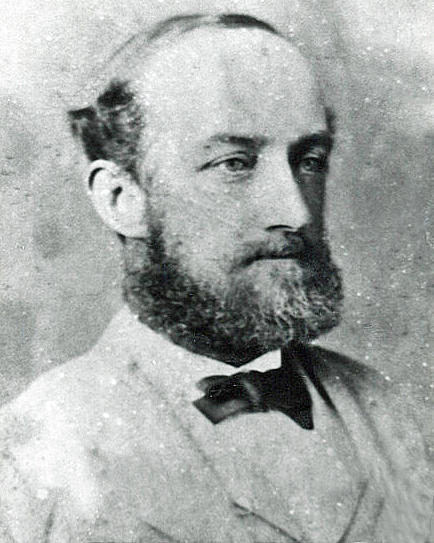
As the Beechworth Lunatic Asylum prepares to open, Dr. Thomas Thomson Dick from the Yarra Bend Asylum in Melbourne is announced as the new asylum’s Chief Medical Superintendent, with Bridget Dunne as the first Matron.
1867 – Oct 24
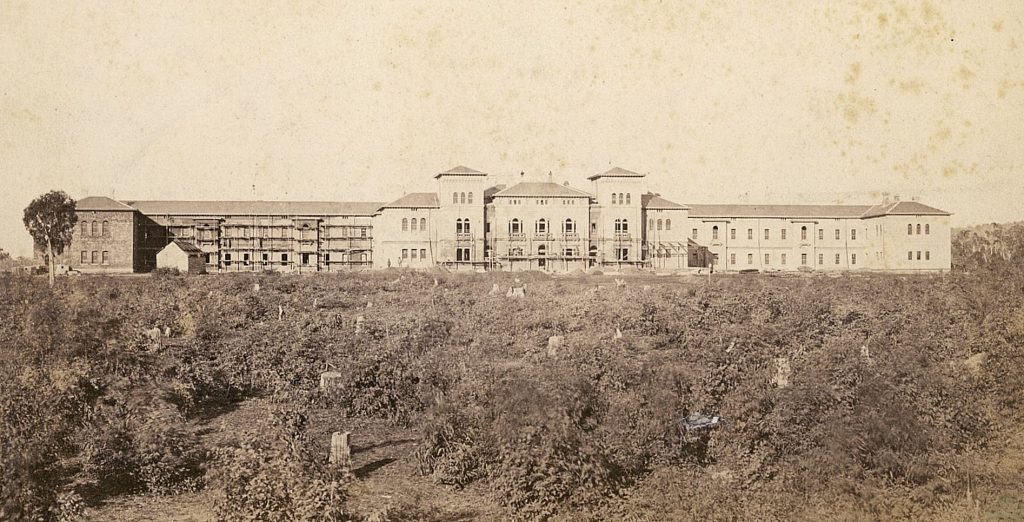
The Beechworth Lunatic Asylum officially opens. A large procession heads from Beechworth Gaol up towards the Mayday Hills location, led by two mounted policemen ahead of a spring cart carrying a dejected occupant along with the Gaol Warder. Behind them, on foot, are seven other male inmates/patients, including “two Orientals” and Beechworth’s own Dr. Dempster. Bringing up the rear of the procession are another Gaol Warder and a policeman. In all, there are ten ‘lunatics’ who have the dubious honour of being the first ‘inmates’ of the new asylum. Other ‘inmates’ will arrive soon after from Melbourne and other parts of the colony. The extensive complex will eventually consist of 67 buildings – built of brick in the Italianate-style – all linked together by half a mile of verandahs which are supported by 350 iron posts, many of which are hollow to carry rainwater from the roof into the Asylum’s unique water supply. The water supply consists of seven underground cisterns – each 23 feet deep and 12 feet in diameter – with each cistern capable of holding 12,000 gallons of water! At its peak, the Beechworth Lunatic Asylum will be home to over 1,500 patients and 750 staff. Featuring 11 hectares of fine gardens, the institution will later be known as the Mayday Hills Mental Hospital.
| Upon its opening, the ‘Beechworth Lunatic Asylum’ becomes one of the largest buildings erected in Australia at the time, incorporating over 3.2 million bricks in its construction. If laid end-to-end, one newspaper article explained at the time, these would extend for a distance of 450 miles! Luckily, these bricks don’t have far to travel as they are obtained from a series of large ‘brickpits’ created just a few hundred yards away, to the rear (north) of the main buildings and can be transported around the site on a specially built tramway. 40,000 paving tiles are used and the foundations of the various buildings contain 22,000 cubic feet of granite encasing 62,000 cubic feet of rubble! |
| Originally planned to be built in Wangaratta, James Ingram persuades the Victorian government to locate the asylum in Beechworth, as the proposed piece of land for it in Wangaratta is flood prone. |
1867

12-year-old Isaac Isaacs moves with his family from Yackandandah to Beechworth where he is enrolled Beechworth’s Common School, then at James Goldsworthy’s Beechworth Grammar School – operating from the hall at 7 Church Street behind Christ Church – where young Isaac excels, becoming Dux in his first year and winning many academic prizes.
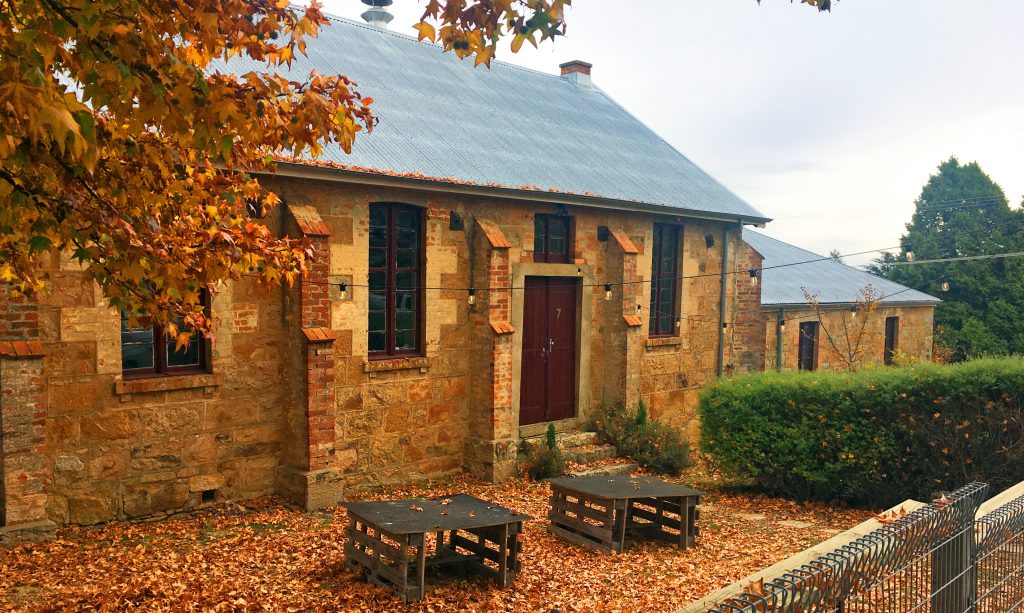
| In September 1870, when Isaacs is just 15 years old – and still a student at ‘Beechworth Grammar School’ – he sits for and passes an examination as a pupil teacher. James Goldsworthy invites him to (unofficially) teach some of the younger students at ‘Grammar’. From 1873, Isaacs is employed by the Victorian Education Authority as an assistant teacher at the Beechworth ‘Common School’ (the original 1865 building still stands in Loch Street). |
1867
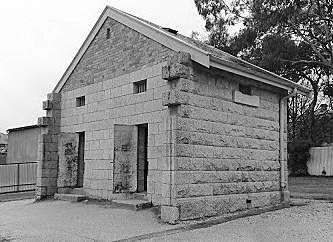
A new Police ‘Lock Up’ is completed on the Police Reserve. The solid stone building has a cell for both male (left hand cell) and female (right hand cell) prisoners for when they are held on remand before their court appearances. Both Ned and Ellen Kelly will be held in the cells on different occasions.

| Established in the 1850s, the Police Reserve will eventually feature several buildings including the stone Police Lock Up and the 1871 Police Stables, built by contractor Lewis Griffiths at a cost £489. (The stables will house horses used by the police in the hunt for the Kelly gang.) Other buildings on the Reserve include the Police Barracks, and the Officers’ and Superintendent’s Quarters & Stables. Many of these building will sadly be removed after 1958 with a plan to turn the reserve into a large vegetable plot worked on by prisoners at the Beechworth Gaol. |
1867 – Nov

Even though Beechworth gardener Mr Tozer is appointed Head Gardner at the Asylum in October 1867, another man – a patient – is responsible for much of the landscaping. Robert Coates, once described as “one of the best professional landscape gardeners in the colony” is transferred to the newly opened Beechworth Lunatic Asylum from the Yarra Bend Asylum in Melbourne. Coates is also considered a “lunatic” – a fact that is celebrated by the Ovens & Murray Advertiser which wrote “Consequently, he brings a greater amount of care and diligence to bear on the work entrusted to his charge than perhaps a sane person would”. During his five-year stay at Beechworth, Coates is given the responsibility of the selection, planning and planting of the trees around the main buildings, including the grand avenue of English Oaks and lavish beds of rhododendrons and azaleas. Most of the exotic trees come from the Royal Melbourne Botanical Gardens and several species still survive, including the 25 Quercus robur – English Black Oaks – along the building’s avenues, described by the National Trust as “one of Victoria’s most aesthetically pleasing driveway avenues, especially for its species”. Robert Coates is transferred back to Melbourne when the Kew Asylum opens in 1872.
1867 – Dec

The Christmas death of James Ring. An inquest is held at the Ovens District Hospital in the presence of Deputy Coroner, Dr Dempster and a jury of twelve, into the death of 60-year-old American James Ring who had been living with his brother Patrick Ring at their home ‘Beaumaris’ by the Three Mile Creek. James had not worked (as a blacksmith) for a few years due to failing health and on December 13th Patrick had run into their house after hearing his brother’s screams, only to find James thrashing about on the floor beside the fireplace with his shirt on fire. After trying to extinguish the fire with his hands, Patrick fills buckets with water to put out the flames. Patrick tends to his brother for a few days before Dr Sparling is called to the home and pronounces James is “in a very dangerous state” telling some that “he will probably die”. Six days later James is finally moved to the Ovens District Hospital where Dr Slater pronounces the case “hopeless” owing to “the man’s weakness”, and he dies the following Saturday morning after Christmas. The inquest is told that a post mortem discovered that James Ring’s liver was enormously enlarged, and contained a large sac filled with pus and hydatids. The following verdict was recorded: That James Ring died at the Ovens District Hospital, on December 28th, from the effect of severe burns accidentally received at ‘Beaumaris’ a house at 11 Weir Lane on the Three Mile Creek, Beechworth on December 13th, 1867.
| Patrick Ring, a miner and sometime blacksmith, had an intemperate mouth and is often before the Beechworth magistrate for using “foul language in public”. ‘The Ovens & Murray Advertiser’ once describes Patrick as ‘The Vulcan of the Three Mile’. |
1868 – Jan 27
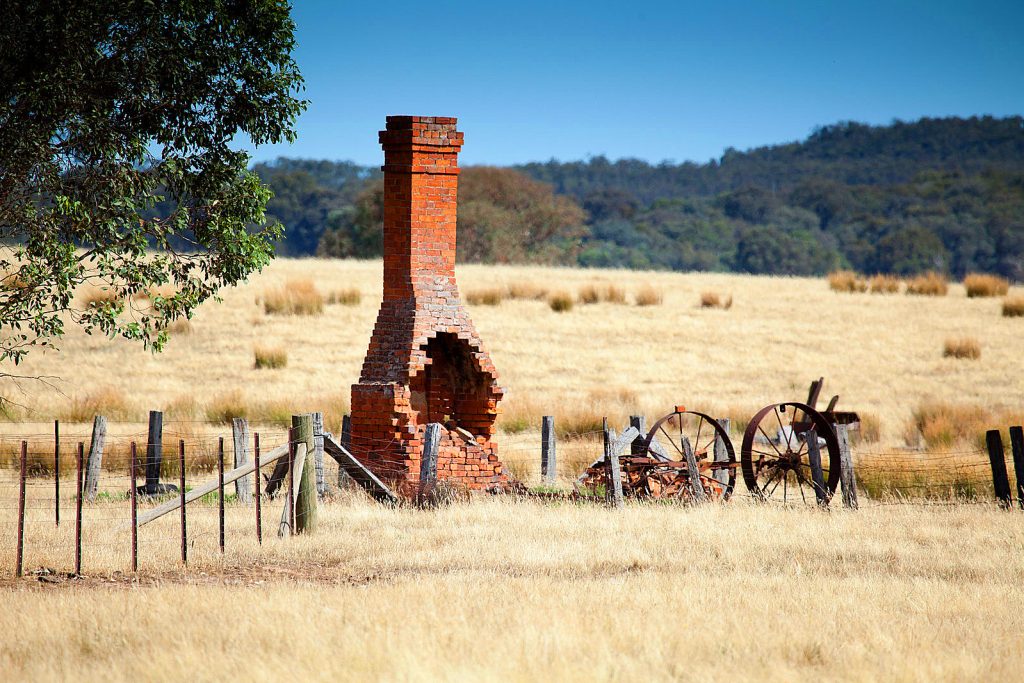
56 km from Beechworth, the Kelly house at Greta – on the Fifteen Mile Creek – is destroyed by fire. 13-year-old Ned Kelly, his brothers and sisters and his mother Ellen are lucky to survive. The fire has been deliberately lit by Ellen’s brother-in-law James Kelly who is later sentenced to death for starting the fire by Judge Redmond Barry at the Beechworth Courthouse, which will be commuted to 10 years imprisonment.
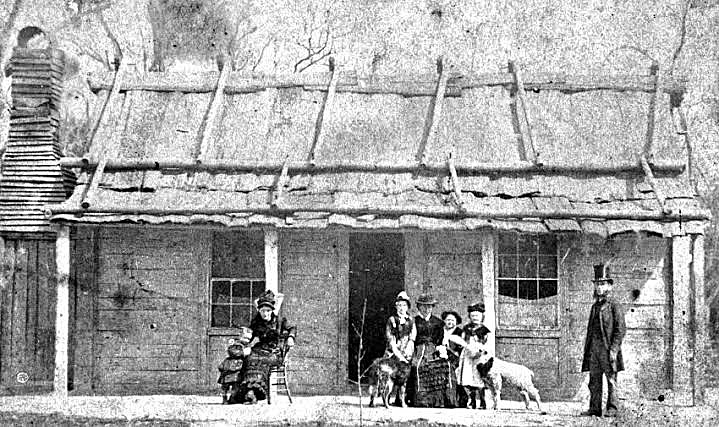
| Surveyed in 1852, the township of Greta flourishes during the goldrush years as roads to the diggings at Beechworth pass through the settlement and, at one stage, Greta has three hotels serving its population and those passing through – ‘The Goldseekers Inn’, ‘The Newmarket Hotel’ and ‘O’Brien’s Victoria Hotel’ (where 16-year-old Ned Kelly had a fight over a stolen horse with Constable Edward Hall in April 1871). ‘The ‘Greta Post Office’ opens in 1863, a Cathlolic School is establised in 1867 and, by the 1880s, there are five schools servicing the Greta area. |
1868 – Feb 27

An earthquake, lasting just five seconds, hits Beechworth, giving locals a moment to reflect on the earthquake that had jolted the area ten year earlier in 1858.
1868

A large and organised group – Ah Gee & Company – establish themselves among the quartz miners at Six-Mile Creek. Chinese miners are usually organised into large groups to work together, which makes them far more efficient than the typical European alluvial gold miners.
| Chinese miners have been living in the nearby official camp at ‘The Three Mile’ since 1857 and some Chinese are also living and working on district farms during the same period. In 1858 there is a mini goldrush to nearby Murmungee where the Chinese will make up 50% of miners and numerous Chinese begin receiving their mail via the Murmungee Post Office. |
1868

36-year-old photographer James Edward Bray opens a studio at his newly-built home at 33 Camp Street. Seven years after establishing his business in Beechworth, Bray will photograph members of the Kelly Gang and their sympathisers, sometimes in his small studio on the second floor at the rear of the building. ‘Brays Photographic Studio’ is conveniently located next door to the ‘Ovens and Murray Advertiser’ newspaper offices. It is now known as ‘Ned Kelly’s Marlo Cottage’ holiday accommodation (above).
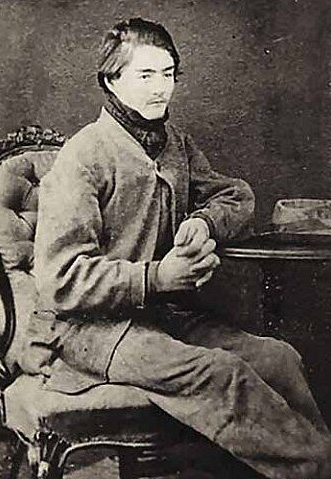
| Bray’s portraits of the Kelly gang taken in his studio include Dan Kelly (wearing his brothers too-big clothes) and 21-year-old Joe Byrne in 1877. When he is 48-years old, James Edward Bray will be one of the four men who photograph the Kelly gang after the siege of Glenrowan in 1880. |

1868 – Mar 22

Only one year after it opens, a mental patient escapes from the Beechworth Lunatic Asylum. Suffering “from idiocy”, the young man escapes by climbing over a section of the ‘Ha Ha Wall’ which is still under construction. He makes his way down the Albert Road hill where he drops into John Duncan Fisher’s Commercial Hotel on Ford Street. Police Superintendent T.E. Langley (in charge of Ovens District) happens to be there, and he asks the police officer if he can have a ‘nobbler’ (a shot of spirits) and a cigar before being returned to the Asylum. This is granted and he is returned to the asylum … but soon escapes again! The young (unnamed) man is then placed in a secure lockdown ward, so he can’t escape again!
1868 – May 6

To replace the original wooden church structure built in 1857, the foundation stone for St. Josephs Church, Beechworth’s first Roman Catholic Church, is laid by James Alipius Goold, the Bishop of Melbourne. Sitting at 9 Church Street, the church is designed by architect John Coe, and constructed of granite blocks. When finally completed in 1875, it will include a magnificent rose window and quatrefoil granite columns supporting the interior. However, a planned spire is never built.
| St. Joseph’s church is renovated in 1963-64 but gutted by fire in July 1977, with the ‘Lady Chapel’ the worst affected. |
1868

Former Roman Catholic school master William John Austin establishes the Hibernian Hotel on the corner of Camp and Loch Streets. The two-story brick-built Irish pub will become a regular haunt for many of Ned Kelly’s family, associates and sympathisers and will host the wedding reception for one of the Kelly Gang. Although it is not one of the ‘grandest’ hotels in Beechworth, the Hibernian – smaller and more ‘homely’ – does have some unique features, including its fine cast iron lace work on its corner façades and balcony. Very few of Beechworth’s buildings of this time feature this kind of detailed cast iron balustrading and ornamental work, which is often seen in other Victorian cities and country towns.
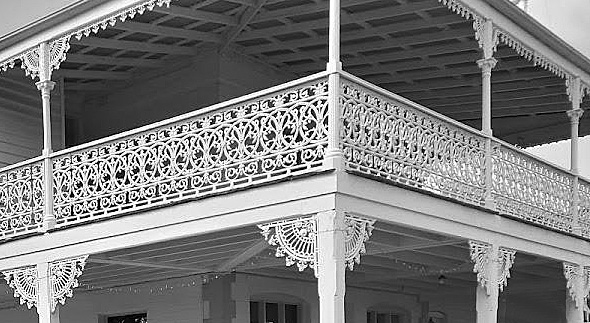
| The ‘Hibernians’ are a fraternal and church-based benefit society founded in 1836 to promote the welfare of people of Irish birth or descent. The Australian branch of the society is founded in 1868 by Mark Young who runs the ‘White Hart Hotel’ in Ballarat. Young is very active in local affairs and assists fellow Irishmen by creating the ‘Ballarat Hibernian Benefit Society’ which later amalgamates with the ‘Australian Catholic Benefit Society’ to form the ‘Hibernian Australian Catholic Benefit Society’ Like Beechworth’s Hibernian ‘Lodge of St. John’ opposite the Burke Museum, the original ‘Hibernian Lodge’ in Camp Street – strictly for Roman Catholics – provides fellowship and welfare people in Beechworth who are far from their Irish homes and families. |
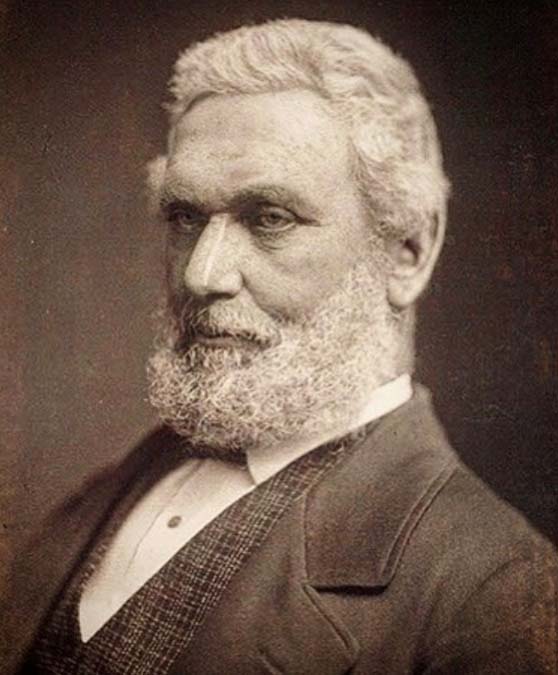
| In May 1877 George Billson Snr will win the seat of Ovens in the Legislative Assembly. Professedly an independent, he supports the Liberal Government of Sir Graham Berry during the 1878 budget crisis and attempts Legislative Council reform. Billson will be defeated in July 1880 but regains his seat for the Coalition years of 1883-86. He is a sensible, practical politician who supports manufacturing development and assiduously protects his district’s interests. Aged 69, he will die of heart failure on 9 February 1886 in Beechworth. |
1868 – Aug 20

Edward Rogers, licensee of the Imperial Hotel, generously pays for the planting of a number of trees around the exterior of Beechworth Gaol and along High Street. The successful hotelier has been brewing small batches of his own beer since the early 1860s, being amongst the first to plant hops in North-East Victoria after cultivating roots in the garden of his Imperial Hotel on Camp Street.
1868
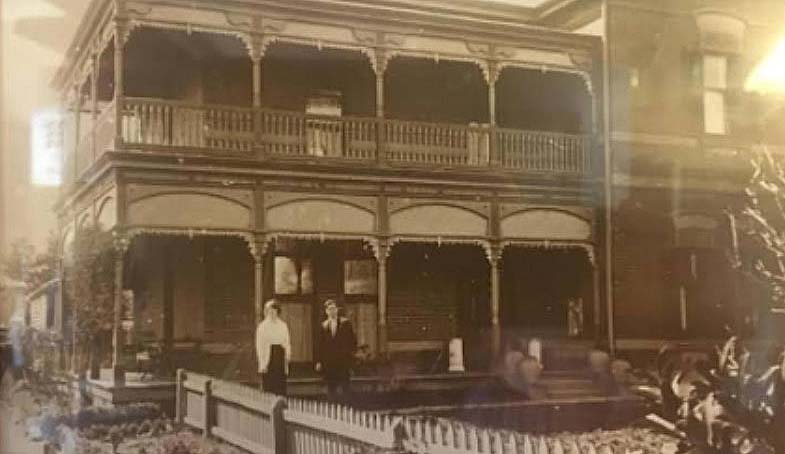
A beautiful home called Walworth is completed at 12 Kars Street. Beginning as a single-storey house in the 1850s, it is finished as a commanding and iconic two-storey solid red brick Victorian residence, historically referred to as “The Retreat”. It is built for Judge Thomas Spencer Cope – chair of the Beechworth General Sessions Court – and later owned by Beechworth pharmacist George Gammon and his wife Kate and then by coach builder Thomas Augustus Connolly of Crawford and Connolly Coach Builders.

1868 – Sep 26

Next to the Victoria Hotel, Mark Baldwin opens the Apollo Hall, a new Beechworth entertainment venue as a rival to William Thompson Soulby’s popular St. George’s Hall on Finch Street and the Concert Room at the Imperial Hotel. Four months earlier Baldwin had purchased the freehold of Soulby’s Victoria Hotel on the corner of High and Camp Streets for £300, made extensive alterations and then built the brick Apollo Hall adjoining the hotel. The Apollo hosts dances, concerts and other entertainment events. However, by May 1871 Baldwin’s Victoria Hotel has ceased business – with Sergeant Baber of the local police reporting the hotel “had become dilapidated and unfit for accommodation” – and the Apollo Hall will soon go the same way.
1868
Beechworth begins campaigning for a railway to be constructed to serve the town, possibly as part of the main route into New South Wales.
| For many years Beechworth district residents have been frustrated with poor roads and high transport costs which are inhibiting the development of the Ovens region. The opening of a branch line could mean a journey that once took many days, could be done in a few hours. A railway line would connect Beechworth with the main rail line at Wangaratta and open up the district for further development. |
1868 – Dec 17

Irishman Felix O’Connor is discharged from duties as a policeman at Beechworth. Felix had become a member of Victoria’s Mounted Police Force on 31 May 1859 after serving 9 years in the Irish Constabulary. He is made a Senior Constable in Beechworth in May 1860, going on to be Sergeant of Police. However, notes on his service record show that he is a heavy drinker, not very good at following orders and has little understanding of Police duties. An example: “Not the slightest reliance could be placed in this man, I think he is the greatest liar I have ever had at the depot.” He subsequently goes into the hotel business, taking the licence for Beechworth’s 1866-built Yorkshire Hotel in January 1869. Standing opposite the London Tavern on the corner of Camp and Finch Streets, O’Connor will initially rename it the Dublin Inn (below) before changing the name to the Dublin Hotel in May 1869. In 1876 he will take over the London Tavern itself, followed by the Post Office Hotel in 1886. Finally, in 1892, Felix becomes the licensee of the Railway Hotel, by which time he is the oldest hotel-keeper in Beechworth. While still running the Railway Hotel, he dies of heart disease in 1898 at the age of 66.
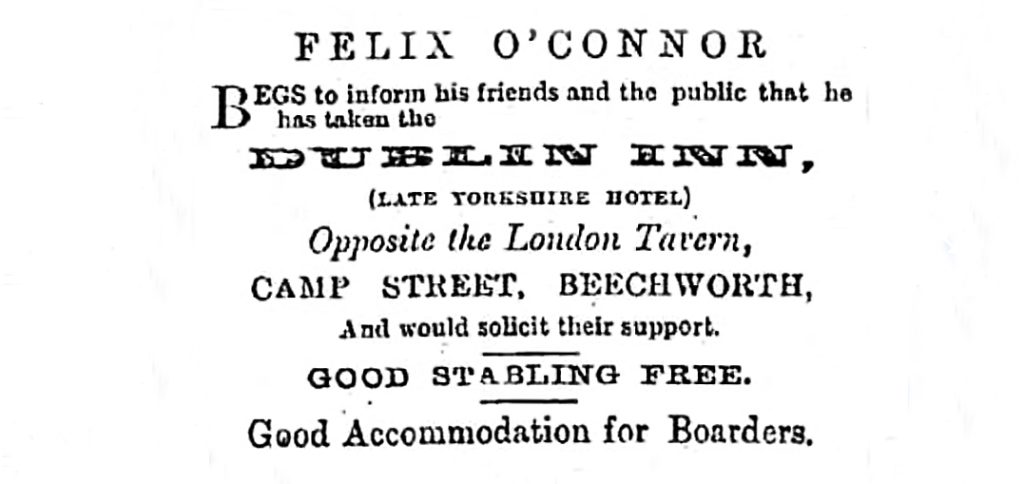
1869 – Feb 24

Frederick ‘Fritz’ Dreyer, licensee of the Beechworth Hotel on High Street, takes over Henry Thomas Littlewood’s two-story Manchester House building on the corner of Ford and Camp Streets. He converts it into a hotel which he names the Corner Hotel (above right). It sits diagonally opposite the Beechworth Post Office in the centre of town. Henry Vandenberg will take over the Corner Hotel in 1884 and the licence is taken by Percival ‘Percy’ Pund from 1887 to 1890. In November 1892 the name of the hotel is changed to the Central Hotel and a verandah is added to the first storey (below).
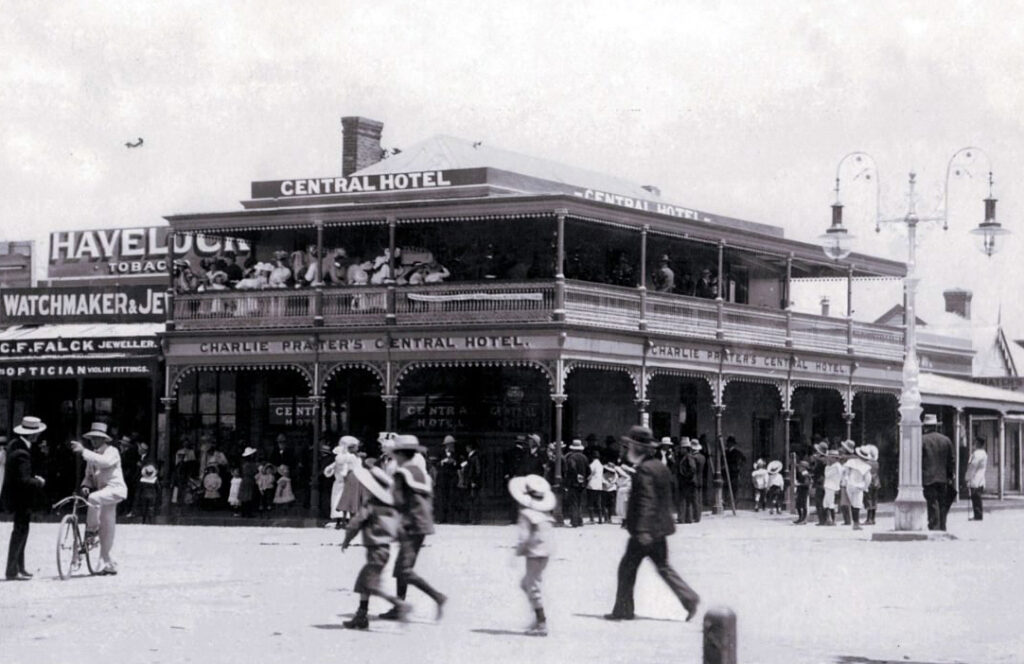

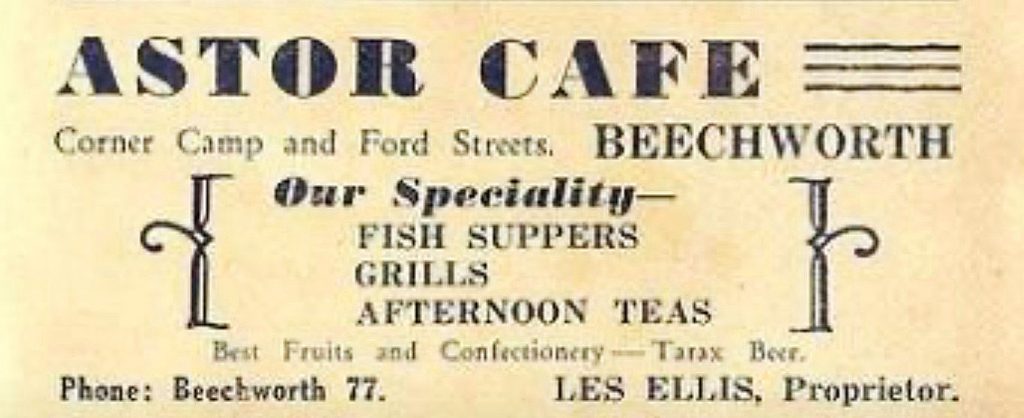
| This highly desirable location had previously been a single-storey building, home of the ‘Argus’ newspaper branch office (as a base for reporters writing about the goldfields); a clothing store; and a tobacconist. For many years from the 1940s to the 1960s the two-storey building is run as the popular ‘Astor Café’ (above), and then the ‘Dolphin Café’. In 2000 it becomes ‘Pozzebon’s Pizza Parlour’ followed by ‘Taylor’s Beechworth Milk Bar’. After sitting empty for a number of years, it is fully refurbished in period style in 2021-22 and now operates as ‘Miss Amelie Gourmet – Fine Food Merchants’. |
1869 – Mar
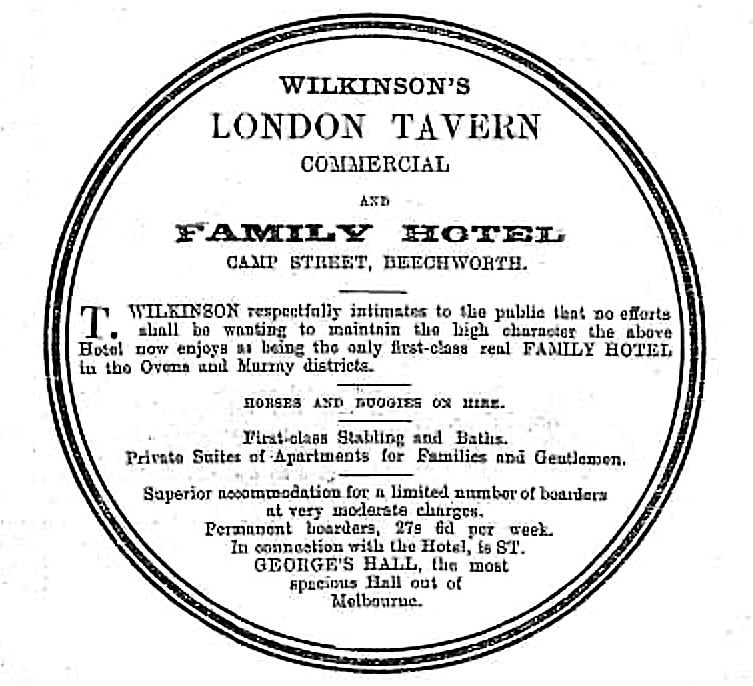
After establishing the fine London Tavern at 43 Camp Street in 1859, William Thompson Soulby puts his hotel – and his St. George’s Hall next door – up for sale. The hall and the hotel – with “twenty spacious apartments built in brick” – are purchased by Thomas Wilkinson who renames it Wilkinson’s London Tavern Commercial and Family Hotel – “the only first-class real Family Hotel in the Ovens and Murray Districts” – but within sixteen months he puts the hotel back on the market. It does not sell but instead is rented by John Rawlings who remains the licensee until 1876, when the hotel is purchased by Felix O’Connor who undertakes a full refurbishment and reinstates the original (and more simple) London Tavern name.
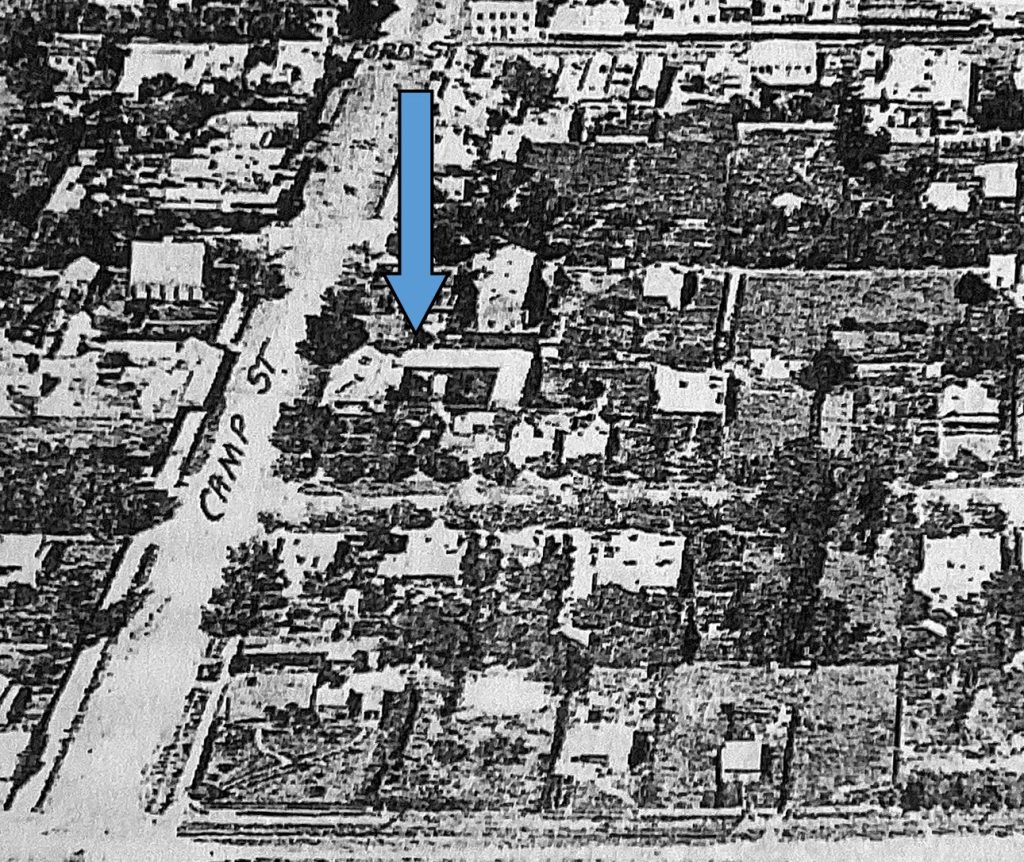
1869 – Apr 22
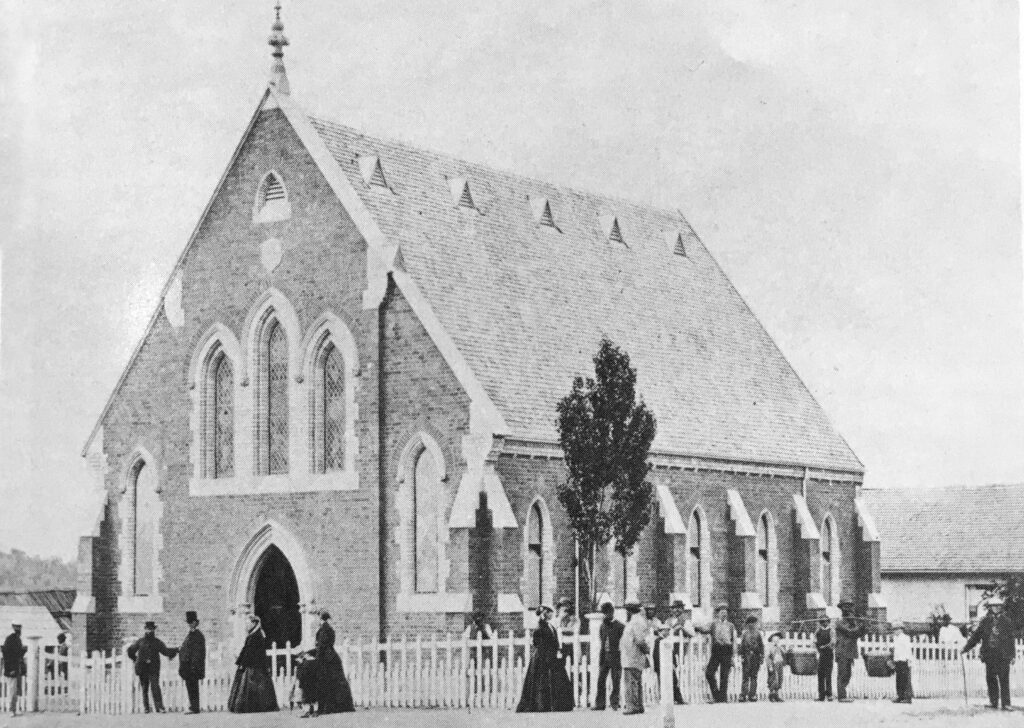
The foundation stone is laid for the Congregational Church by the Reverend Mark Bradney on the corner of Camp and Loch Streets. The new church will stand at 40a Camp Street, next to the site of the Congregational Church Hall, which had previously been the location of the original cemetery. (The bodies had been exhumed and transferred to the new cemetery in 1857.)
| When the Congregational and Methodist Churches amalgamate in the 1970s it ceases being used for services and most recently it has been the home of ‘Gospel Antiques’. |
1869
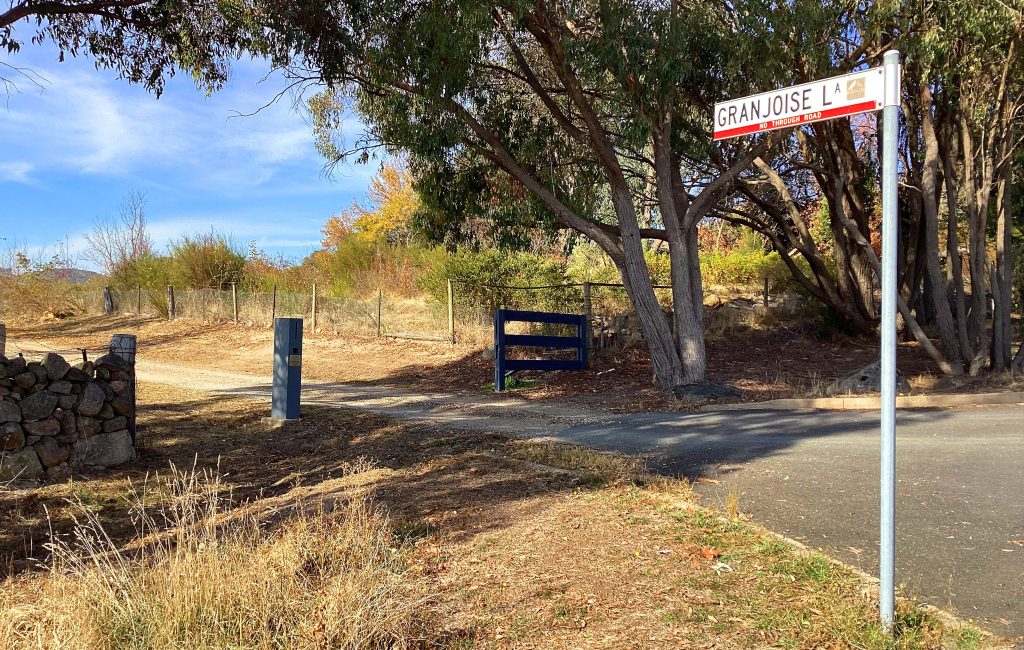
French chef Ambroise Granjoux (who had been a chef at Government House in Melbourne and then in charge of the restaurant at Beechworth’s El Dorado Hotel) establishes a vineyard at Newtown. After some success, the vineyard is sadly destroyed by a fire and in 1873 Ambroise Granjoux will return to France. Today, Granjoise Lane (named in his honour) runs off Malakoff Road at Newtown and new vines have been planted at the end of the lane, surrounded by the impressive original stacked stone walls (below).
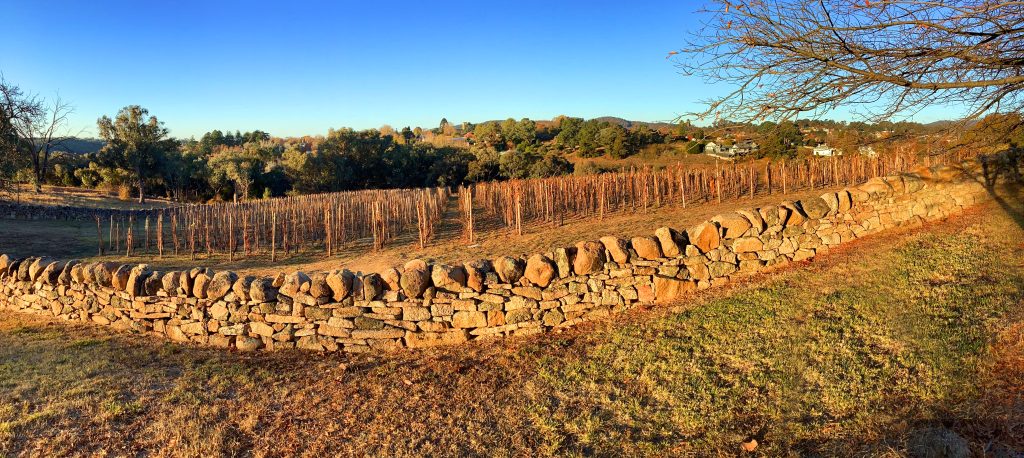
1869

Beechworth newsagent and tobacconist George Judah Lyon purchases the Beechworth Cordial and Aerated Water Manufactory in Loch Street from Mr E. H. Dunn. He carries on this business for some time with a fair amount of success but, believing that the water passing through the slate strata towards the head of Spring Creek will be more suitable for the purposes required, he moves the factory to that locality and pushes forward the business with redoubled energy, emphasising the Soda Water. His cordials include ‘Ginger Wine’, ‘Peppermint’, ‘Lemon Syrup’, ‘Cloves’ and ‘Cherry Cordial’ and his award-winning ‘Raspberry Vinegar’ (label above). He later adds sauces, including his own ‘Bogong Sauce’. He will eventully sell his Spring Creek Brewery to Dr. Brierly and Hurst & Co when George and his wife move to Windsor in Melbourne in 1885.

| New York native George Judah Lyon and his wife Wilhelmina enjoy amateur theatricals and regularly stage performances. The Ovens and Murray Advertiser report on a performance of the Shakespeare reading “Seven Ages” given by George at ‘St. Georges Hall’ to raise funds for the ‘Beechworth Academy.’ It is met with hearty applause. Finding that he cannot devote full attention to his newsagency, he sells it to Alfred ‘Alf’ William Foster and adds a brewery to his premises beside Spring Creek. |
| In 1873, 20 years after arriving in Australia from America, George Judah Lyon is naturalised. He has become both popular and important in Beechworth. There is a strong American presence in Beechworth and Lyon takes a prominent part in organizing Fourth of July celebrations. Always ready to be in the forefront of any movement which might benefit the district or develop its resources, when the United Shire of Beechworth is constituted, he is elected a Councillor from 1877 to 1881. He is philanthropic and a supporter of helping to relieve human suffering. He is a member of the Church of England, the Benevolent Society, the Public Library, and is also a Committee Member of the ‘Ovens and District Hospital’ and the ‘Agricultural Society’. He is a keen sportsman and member of the Beechworth Racing Club Committee, he is a strong supporter of the Beechworth Railway, and initiates the idea of the Boxing Day Sports which are held in Beechworth for many years. |
1869 – May
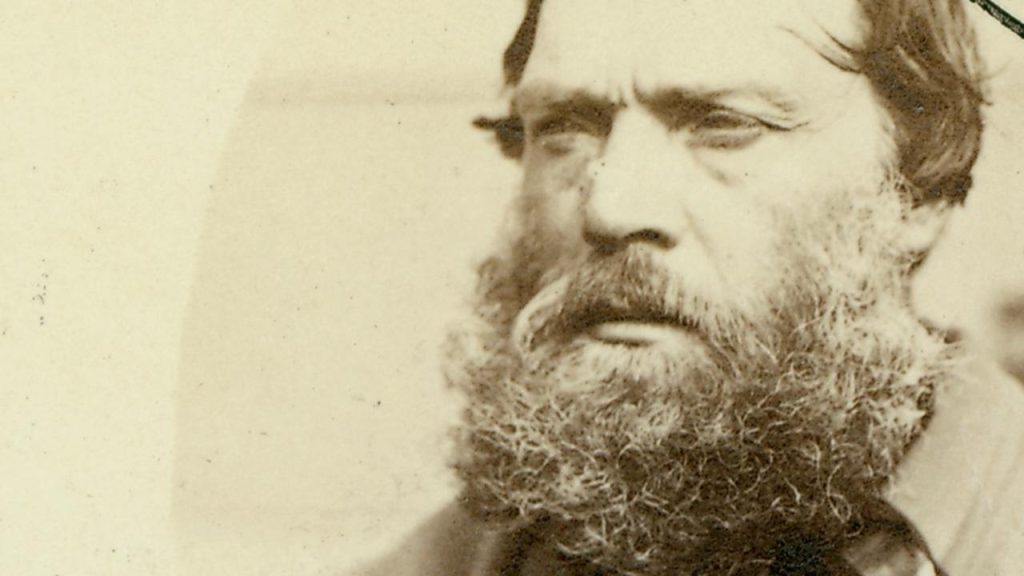
14-year-old Ned Kelly forms an association with notorious bushranger, prison escapee and ‘wanted man’ 50-year-old Irish-born Harry Power (alias of Henry Johnson) who now operates in the Ovens Valley area. Becoming Power’s bushranging protégé, he teaches young Ned bushcraft and other “tricks of the trade”. Power and Kelly attempt to steal horses from the Mansfield property of squatter John Pearson Rowe as part of Power’s bigger plan to rob the Woods Point-Mansfield gold escort, but the plan comes unstuck when Rowe catches them ‘in the act’ and shoots at them. They disappear back into the bush and Ned breaks off his association with Harry Power … but only temporarily.
| When Harry Power and Ned Kelly attempt to steal the horses, Dr. John Pearson Rowe (1810–1878) is a physician and squatter who owns the ‘Loyola Run’ (also known as ‘Mount Battery’) near Mansfield. Reputed as the first Roman Catholic resident of the district, Dr. J. P. Rowe was one of the principal founders of the ‘University of Melbourne’ in 1853. In October 1878 Rowe will supply information to Mansfield police Sergeant Kennedy on the whereabouts of Ned Kelly. Acting on Rowe’s verified advice, Kennedy and his police party will ride into the Wombat Ranges, where three of them are killed at Stringybark Creek. |
1869

At Finn’s old claim at the Woolshed, a few diamonds are discovered as tailings are being washed through, and large quantities of stream tin are discovered at Pilot Range, north of the Beechworth-Chiltern Road.
1869
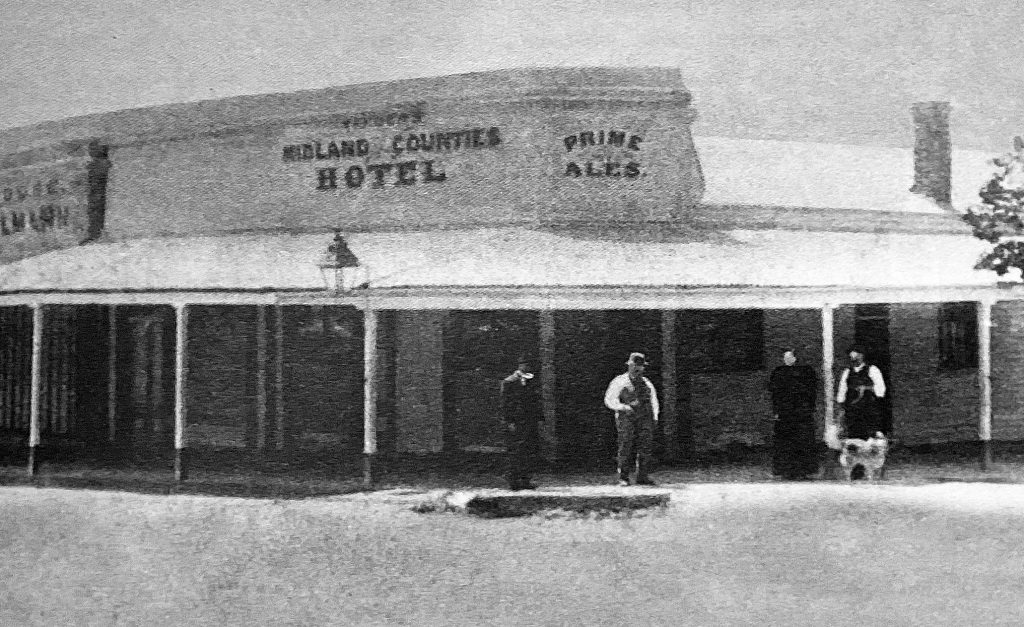
Having sold his Australian Arms hotel at Silver Creek, Edwin ‘Teddy’ Warden builds a new hotel in Beechworth, on the corner of Ford and Church Streets, formerly the site of the ‘Masterson & Hamilton Grocery Store’. He names it the ‘Midland Counties Hotel’ (after his home county in Coventry) and the new hotel boasts of a ‘private entrance from Church Street to the Dining Room’ (presumably for those who did not wish to walk through the bar!) and a verandah is extended in 1874 around both sides of the building. In 1889 Warden passes the license to his son Frederick Oscar Warden who, in 1900, adds a second story at the back of the hotel containing ten hotel rooms, with a new rear balcony with ‘a view of the distant Buffalo Mountains’. Frederick Warden dies suddenly at the age of just 43, leaving his widow Ellen Warden to run the business. She runs it extremely well … in 1913 she carries out major renovations and changes the name of the business to ‘Warden’s Hotel’. To celebrate, the Beechworth Town Band play selections from the balcony for the gathered gentry at the official re-naming and ‘free drinks are dispensed for an hour’.
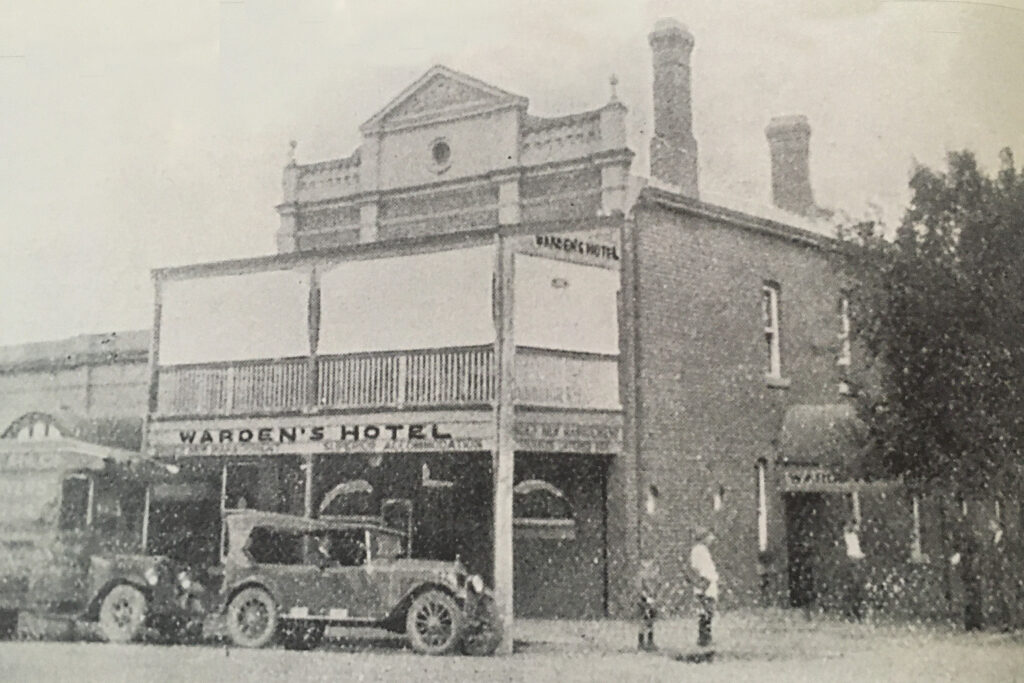
| Members of the Warden family run the hotel for almost fifty years, before the licence is sold to Ms. Frederica Walker in 1935. ‘Warden’s Hotel’ finally closes in 1971. The building remains today – still featuring its pair of famous ‘Wardens’ and ‘Hotel’ stained-glass windows facing Ford Street and, until 2022, operated as the ‘Beechworth Indian Restaurant’. |
1869
After much debate and design work, construction begins on a new Beechworth Post Office after the damage caused to the previous building during the ‘Great Beechworth Fire’ in 1867. The iconic solid granite tower, which is still standing proudly, is to be incorporated into the new structure, designed by architect Peter Kerr from the Public Works Department (Kerr will also design the Kyneton Post Office) at a cost of £3,700.
1869

Having first arrived in Beechworth as a 22-year-old butcher at the beginning of the goldrush in 1852, Thomas Tanswell, now aged 39, returns to Beechworth with his wife Ann and their 13 children after spending the last 16 years in the nearby town of Bright. The son of a convict, in 1862 Tanswell had built and operated the Empire Hotel in Bright before his eventual move back to Beechworth where, amongst other things, he will become a Justice of the Peace and Beechworth Shire President from 1878-1879 and again from 1886-1887.
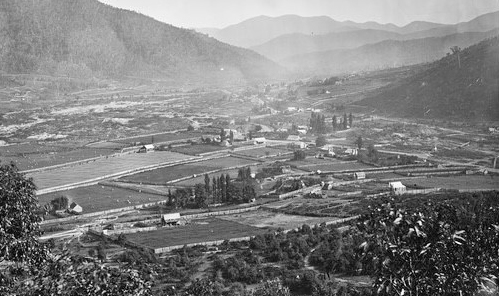
| In the township of Bright, at the junction of Morse’s Creek and the Ovens River 57km from Beechworth, Thomas Tanswell had run a hotel on the Buckland Goldfields below the river junction before building the popular ‘Empire Hotel’ in 1862. Later renamed the ‘Oriental Hotel’ this building still stands today at 2 Ireland Street (as the ‘Velo Hotel’) and is one of the oldest commercial buildings in Bright. |
1869 – Jul 20

11km from Beechworth, the first school at Murmungee opens. Built by local residents for use as a school, hall and a church, ‘School No. 997’ begins as a ‘Non-Vested’ school with an initial enrolment of 52 students. As the building is only leased by the Board of Education, it is used for many other things and quickly becomes the centre of social life, as well as learning, in the Murmungee area. Although the school ceases to operate at the site in 1938, it continues to be used for local activities and events, and still stands today and is heritage listed.

| In the 1860s, government policy requires a small community to build their own school and employ a teacher before state aid is granted. So the Murmungee community begins to raise funds in 1865, holding a concert and a ball which attracts around 300 people to a local landowner’s house. Dancing and festivities (and fundraising!) go on until sunrise (not surprising as horse drawn buggies had no lights). |
1869 – Aug

27-year-old champion roller-skater Adolphus Frederick Spiller opens a season of his ‘Spiller’s Skating Rink’ at St. Georges Hall on Finch Street. Beechworth citizens can hire roller skates and enjoy roller skating around the hall, accompanied by the ‘Beechworth Fire and Drum Band’.
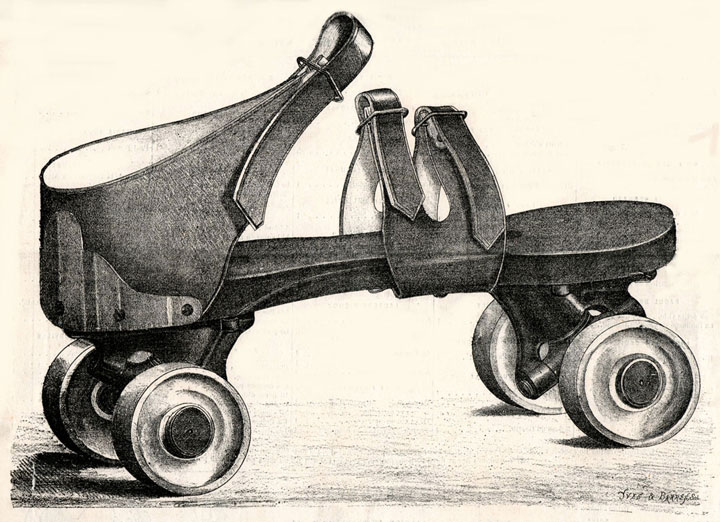
| Also a talented singer and musician, Tasmanian-born Adolphus Frederick Spiller soon leaves Australia for India and then for Europe in October 1870. In London in 1874 Spiller establishes a company manufacturing his patented roller skates, becoming one of the major roller skate inventors and manufacturers of the late 19th century, particularly at the time of ‘Rinkomania’, the great European skating fashion from the mid-1870s, with London alone boasting over 50 roller-skating rinks at one stage! |
1869 – Aug 30

Demolition begins on the 1854-built wooden Wesleyan Chapel at 26 Ford Street. Used as the Wesleyan School since 1857, it has been deemed unsafe. Four tenders for demolition are received, with the accepted tender going to 43-year-old James Kyle for a demolition fee of £287. It is to be replaced by a new brick chapel, on the same spot, next door to the new stone Wesleyan Church built in 1857.
| When it opened in 1854, the old wooden Chapel is the first place of worship constructed in Beechworth. |
1869
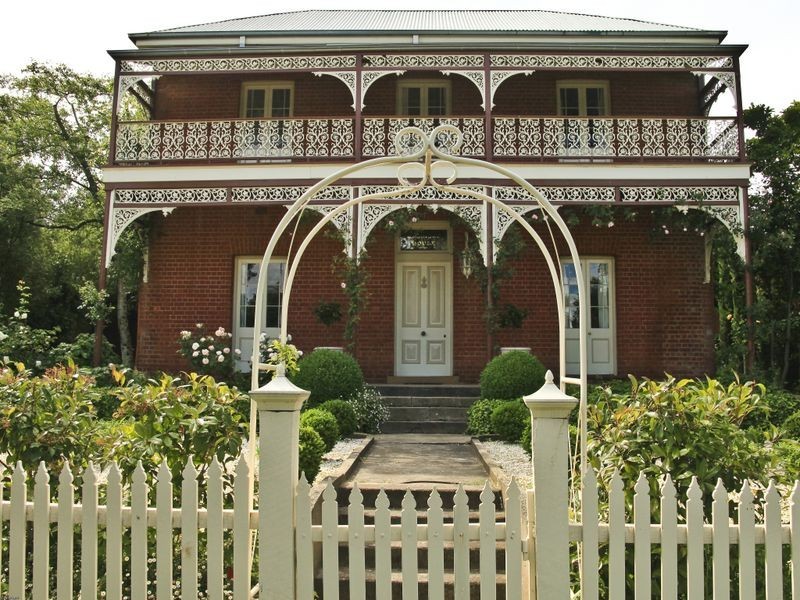
The beautiful two-storey Victorian home ‘Richmond House’ is completed at 14 Bridge Road on the Newtown Hill for Mark Straughair and John Laidley Duncan, the blacksmiths and farriers and owners of the Beechworth Foundry across the road. The foundry owners build the house themselves, which features granite foundations with ‘English bond’ brickwork – triple brick downstairs and double brick upstairs.
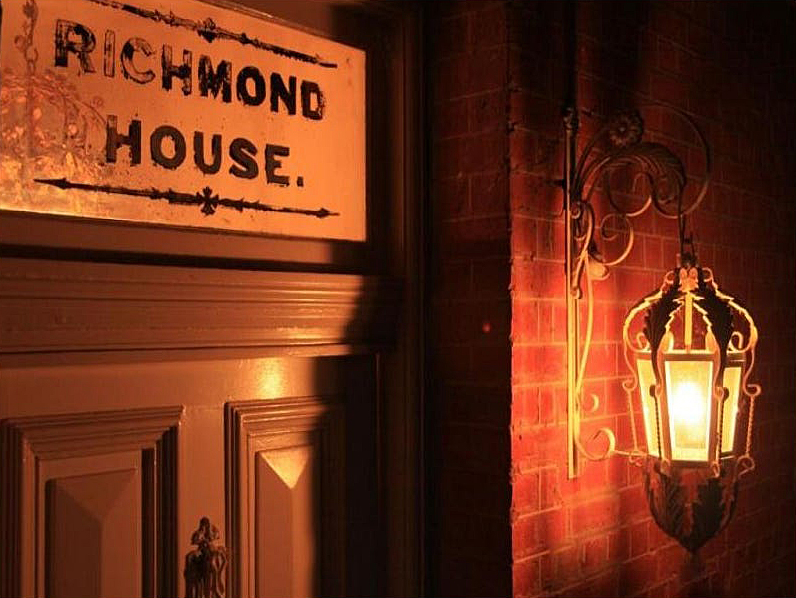
| Duncan will carry on the ‘Beechworth Foundry’ in Newtown after the death of his partner Straughair in 1882. When Duncan dies in 1896 the Foundry business collapses but will be re-established by William Henry Phillips in February 1905 before being taken over a year later by H. Delora. |
1869
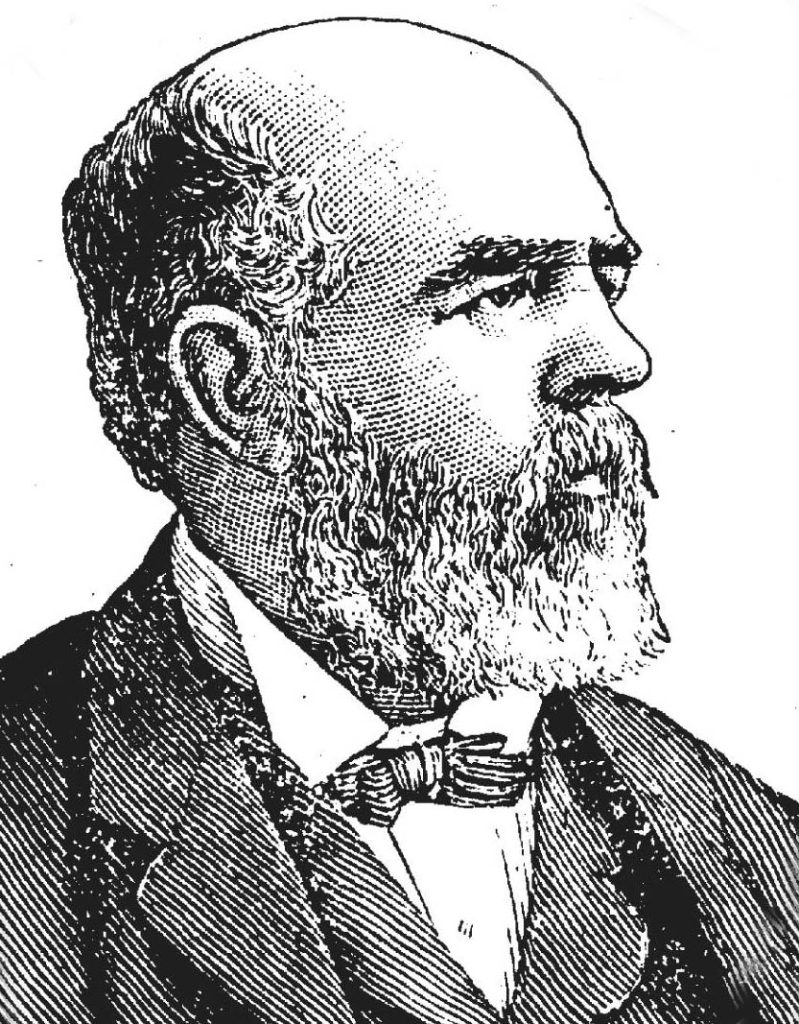
Beechworth’s George Briscoe Kerferd becomes Minister for Mines and Railways in the Victorian Government and is instrumental in having Beechworth connected to the State’s railway system, telling parliament “The advancement of Beechworth means more to me than my political career.” He has the branch line to Beechworth included in the Railway Construction Bill.
1869 – Oct
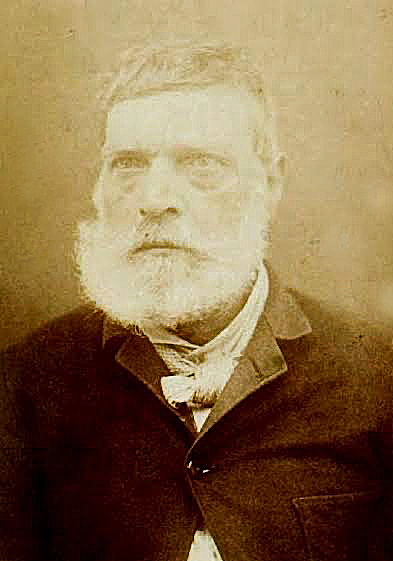
After escaping from Pentridge Prison in Melbourne on 16 February 1869, 50-year-old Harry Power (born Henry Johnson in Ireland) roams throughout the North-East Victoria robbing both the rich and the poor, finally settling on highway robbery as the most profitable line of work, holding up the mail-coach at Porepunkah on 7 May and another coach on the Longwood-Mansfield Road on the 22nd 1869. In Beechworth in late October having a drink at the Commercial Hotel, he overhears a ‘Crawford & Connolly’ coach driver (their office is across the street) boast that “he would shoot Harry Power if he came upon him”. Harry decides to put the driver to the test and the next day he will ride down the Buckland Gap Road and block the stagecoach with a barrier of logs in its path.
1869 – Oct

As planned, bushranger Harry Power holds up the ‘Crawford & Connoelly’ stagecoach near Orton Road at Murmungee on the Buckland Gap Road 7 miles from Beechworth. Once the coach is halted, Harry springs from the surrounding bush (is Ned Kelly holding the horses? – see entry below) and orders everyone to put their valuables on the ground. There are four passengers on the coach, a Bright store keeper, a little boy, and two women – Kate Dalgleish, the teenaged Murmungee School Assistant Teacher, and a Chinese woman named Hing Ung. (This is highly unusual, since of the 1,500 Chinese in the district, only 2 are female!) The coach driver empties his pockets of £2/16s (and his pistol) after denying his boast the previous day at Beechworth. The Bright store-keeper hands over his gold watch and Hing Ung offers 13 shillings. Harry suggests she has more money ‘hidden in her garments’ and threatens to strip her to discover it. She protests tearfully as her fellow passengers plead with Harry to leave her alone. Chivalry prevails and he makes off with the lead horse from the coach to forestall any pursuit.
| The Victorian Government immediately raises the reward for Harry’s capture from £200 to £500. Alas Harry’s days are numbered and his fondness for watches will lead to his undoing. Offering to return a gold watch (for £15) to one of his victims via one of Ned Kelly’s uncles, Ned’s grandfather James Quinn will reveal Power’s hideout for the reward, receiving £300 for his part in the capture. Harry Power receives a sentence of 15 years in prison. |
1869 – Oct 29

14-year-old Ned Kelly appears at the Benalla Courthouse charged with assaulting and robbing Chinese pig and fowl dealer Ah Fook on the track between Winton and Greta on October 14th. Beechworth’s ‘William’ Tsze Hing acts as interpreter during the hearing of the case in which Ah Fook claims that as he passed the Kelly family home, Ned brandished a long stick, declared himself “a bushranger” and robbed him of 10 shillings after hitting him with the stick. Young Ned will spend ten days in custody before the charges are dismissed, but following this incident, local police regard Ned Kelly as a “juvenile bushranger”.
1869 – Nov 11

Another execution at Beechworth Gaol. After being convicted of murdering of his wife Elizabeth Whilihan at the October sitting of the Beechworth Circuit Court, 40-year-old Irishman Peter Higgins (aka James Smith) is brought to the hangman’s noose for the crime at Springhurst – on the Chiltern and Wangarratta Road – which quickly became known as the “Springs Murder” and attracts much publicity. At 9 o’clock on a Thursday morning, almost fifty people, including gaol officials and the Rev. Father Egan, are present to witness the execution of Higgins by Tom Healy – “Tom the Devil” – who performs the duty of hangman. Once on the drop, Healy adjusts the rope around the condemned man’s neck, the lever is drawn, followed by the dull heavy thud which tells all present that the law has been vindicated. His death is instantaneous – no movement is observable after the body drops – meaning the neck has been dislocated by the drop.
1869 – Nov 12

The new brick Wesleyan Chapel and Schoolroom is completed, replacing the recently demolished wooden chapel on Ford Street. A special ‘combination’ event is held on November 14, with sermons preached by local Wesleyan, Congregational and Methodist ministers. The following day about ‘250 ladies and gentlemen’ attend a ‘Tea Meeting’ in the new building at which the Wesleyan minister Revered James D. Dodgson and others speak and Mr Ah Ling sings a ‘hymn in Chinese followed by a few remarks in English’. Both buildings remain intact today.
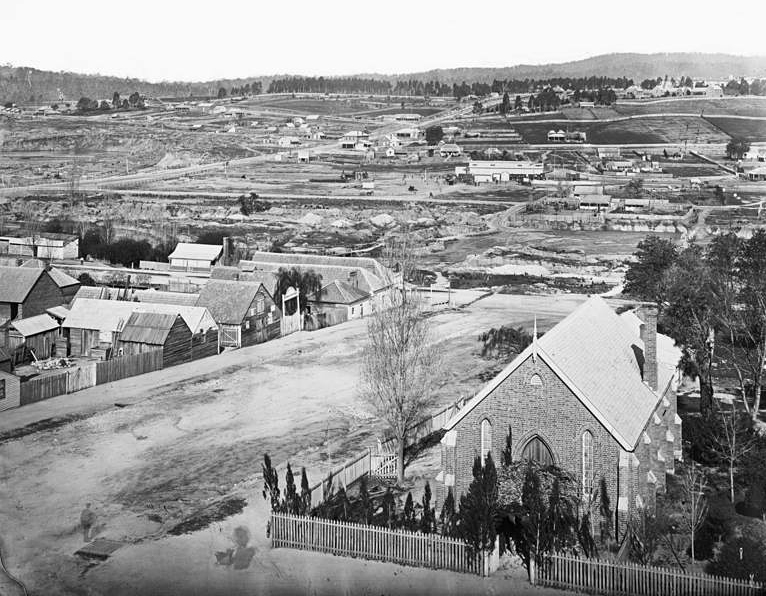
| The Wesleyan Church will become the Methodist Church in 1900. When the Methodist and Congregational Churches merge in 1966 it ceases being used for services. The church building will become the ‘Beechworth Neighbourhood Centre’ in the 1980s and is now the home of the ‘Quercus Community Centre’ while the Wesleyan Schoolroom is now the ‘Quercus Bookshop’. |
THE STORY CONTINUES IN THE 1870-1899 TIMELINE